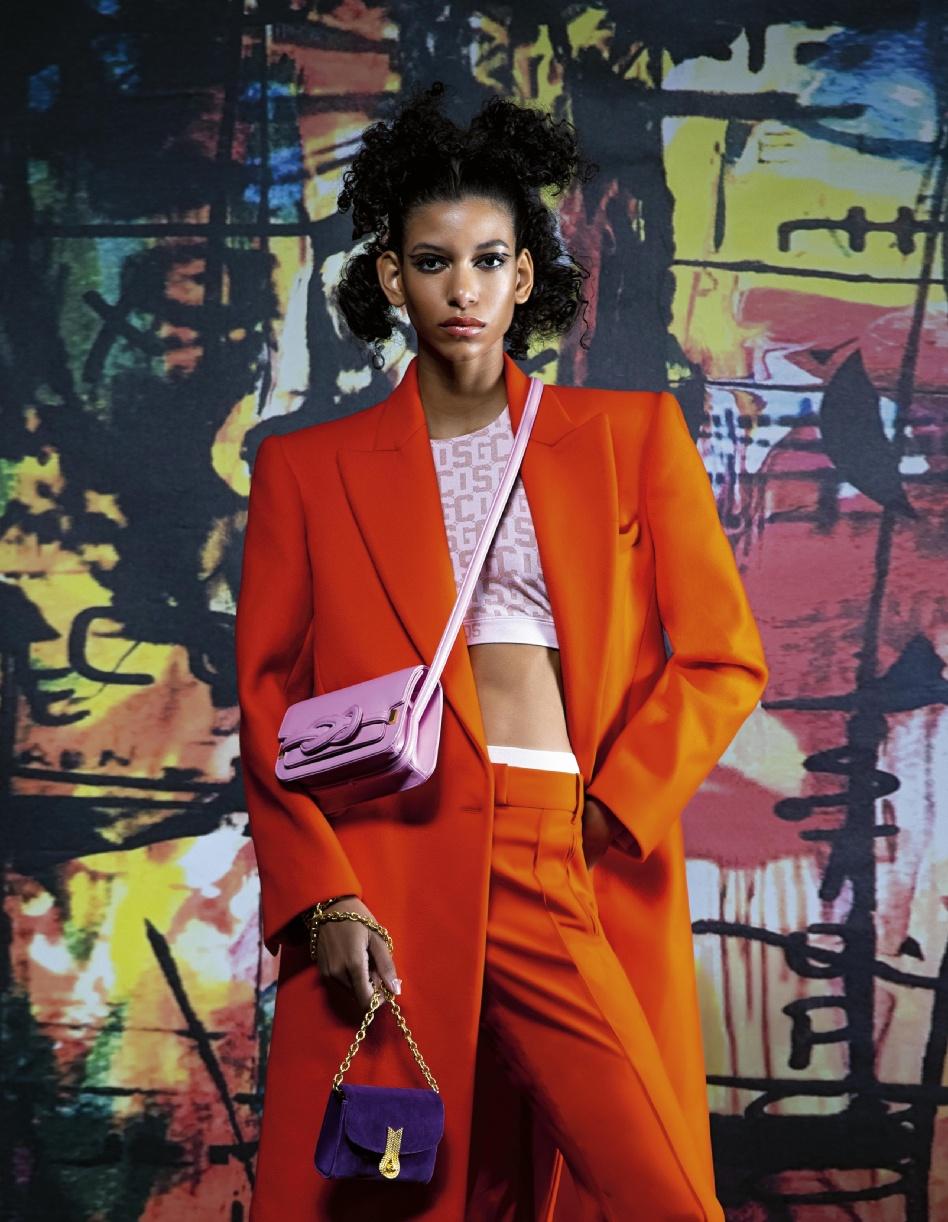
28
MICAM Emerging designers
OPINION LEADER Asap LTD
DESIGNER Justin Son ESENES VINTAGE The wardrobe of A.N.G.E.L.O. ART Silvia Caimi Fabius Tita FOCUS ON The magnificent 10 of SS23
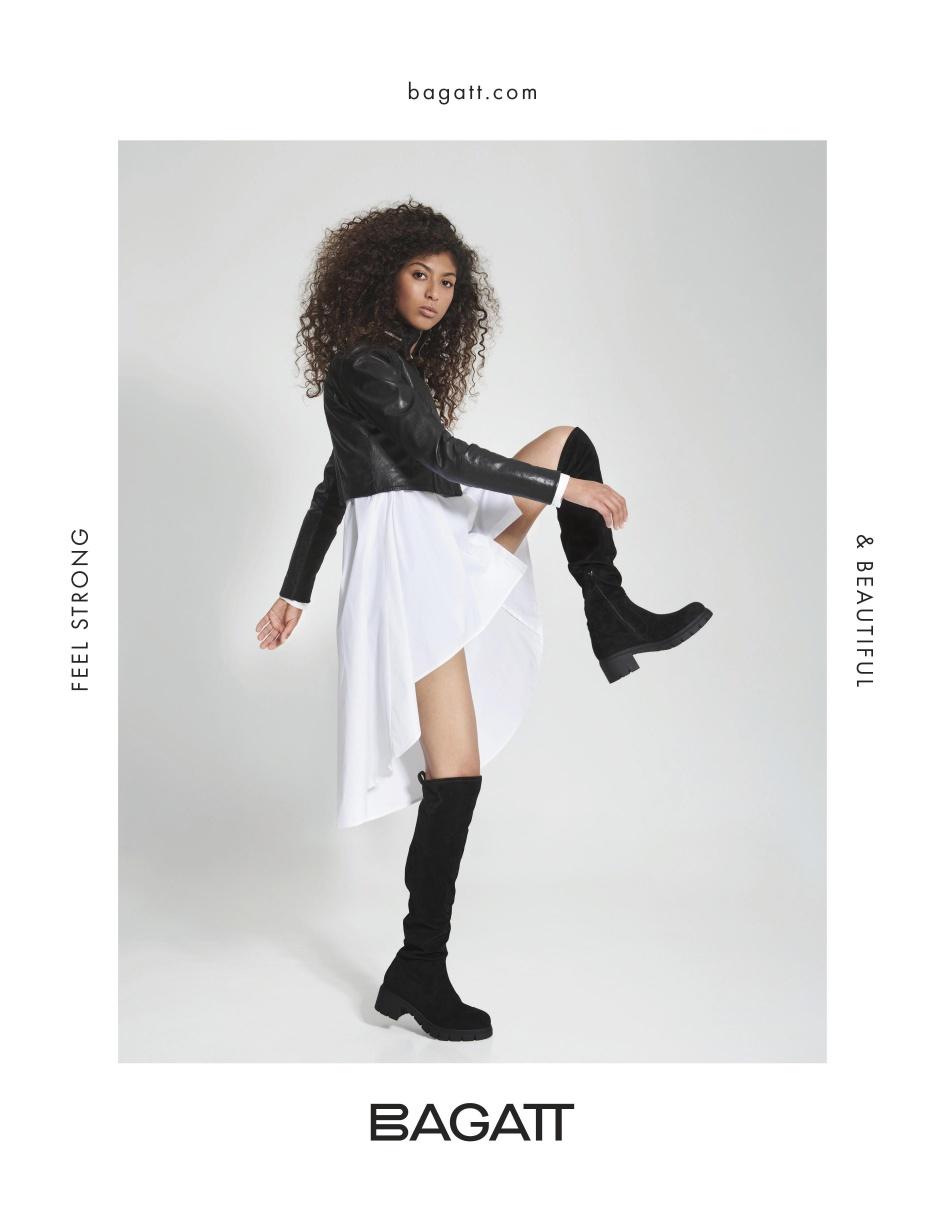


28

EDIZIONI AF SRL
Via Ippolito Nievo, 33 - 20145 Milano Tel. +39 02 319121 - Fax +39 02 33611619 www.edizioniaf.com info@edizioniaf.com
Direttore responsabile Matteo Pasca
Direttore editoriale Enrico Martinelli
Art director Angelo Lanza
Fashion editor Luca Termine
Graphic design Michele Alberti Cartoonist Matteo Sessa Vitali
Contributors
Angela Qehaja, Anna Luzzi, Bohdan Bohdanov, Daniela Rettore, Daniele Botallo, Dinalva Barros, Fumatto, Gianni Bortolazzi, Joe Colosimo, Luca Cioffi, Lucrezia Bazzolo, Lucrezia De Vita, Martina De Carolis, Paolo Guadagnin, Sara El Beshbichi, Giulia Simonotti, Ursula Beretta, Yadier Castro Piedra
Editorial
Erika Alberti, Alessandro Dorio, Matteo Galuzzi, Sara Meneghetti redazione@edizioniaf.com
Digital
Alessandro Capuzzi, Domiziana Desantis, Ilaria Marciò digital@edizioniaf.com
PR & Marketing
Mariella Catalano, Mariel Cuba subscription@edizioniaf.com
Advertising
Filippo Crepaldi, Giorgio Gori, Lucio Luiselli, Stefano Migliavacca, Jose Rivera adv@edizioniaf.com
Operations
Massimo Ledda, Elisa Trasi, Andrea Zampieri operations@edizioniaf.com
Printing Porpora Group - porpora-group.it
Distributore nazionale: m-dis
Foto e illustrazioni Alcune foto sono prese dal web in assenza di copyright. Chi riconosce immagini di sua proprietà lo segnali a AF Mag
Poste Italiane Spa - Spedizione in abbonamento po stale - Autorizzazione MBPA/LO - NO/114/A.P./2017
ART.1 COMMA1 - LO/MI. Pubblicazione registrata presso il Tribunale di Milano al numero 374 in data 3 lu glio 1995. © Copyright 1967 - È vietata la riproduzione senza autorizzazione dei testi e delle immagini. Il tratta mento dei dati personali dei destinatari di “Idea Pelle” è svolto nel rispetto della Legge 675/96 sulla Privacy. È possibile chiedere la modifica o la cancellazione dei propri dati indirizzando la richiesta a: Edizioni AF S.r.l. sede di Via Ippolito Nievo, 33 - 20145 Milano - Italy ai numeri di fax e di posta elettronica sopraindicati.
COVER STORY: Coat and trousers BCBGMAXAZRIA

Bag AMATO DANIELE Spot set GCDS for Wolford
Drawing Basquiat inspiration: Joe Colosimo Photo by Angelo Lanza Fashion by Luca Termine Make-up: Imma Mennuti Hair: Giorgia Prini @MKS Milano Model: Anna Virag Seck @BraveModels MNG
ISSUE 28/2022
05Perspectives on luxury
Il linguaggio è una geniale convenzione che ha permesso agli umani di collaborare ed evolversi. E i concetti che esprime mutano di significato e peso in base al contesto. Le parole ‘ho fame’ pronunciate all’ingresso di un ristorante parigino espri mono uno stato d’animo ben diverso da chi le articola in una baraccopoli mentre sopravvive con 3 dollari al giorno. Anche ‘ho freddo’ registra temperature ben diverse se udito in un appartamento che attende di accendere i termosifoni a causa della crisi energetica, o se risuona in un campo profughi siriano. La parola ‘lusso’ - che conduce il gioco di questo numero - è anch’essa foriera di molte, possibili e varie intonazioni. Il significato che a noi piace è quello espresso da una Moda capa ce di farsi bellezza, creatività, colore e forme. Una moda in grado di esprimere il meglio di un essere umano e criticarne ferocemente il peggio.
Senza dimenticare mai che le prospettive del ‘lusso’ variano in base alla posizione da cui lo si osserva. Potrebbe anche signifi care tenersi stretto un lavoro che mette a rischio la propria salute e l’ambiente, come avviene in India, per esempio. Una storia che leggerete verso la fine di questo numero. Se lusso deve essere, quindi, che sia bello, significativo, grato di potersi esprimere e consapevole di portare con sé risonanze di fatica ancora da sanare.
Enrico Martinelli
Language is an ingenious convention that has enabled humans to collaborate and evolve. And the concepts it expresses change in meaning and weight according to context. The words ‘I’m hungry’ uttered at the entrance of a Parisian restaurant express a quite different state of mind than someone articulating them in a slum while surviving on $3 a day. Even ‘I’m cold’ registers quite diffe rent temperatures if heard in an apartment waiting to turn on the radiators because of the energy crisis, or if it resonates in a Syrian refugee camp.
The word ‘luxury’ - which leads the play in this issue - is also a harbinger of many, possible and varied intonations. The meaning we like is the one expressed by a Fashion capable of becoming beauty, creativity, color and form. A fashion capable of expressing the best of a human being and fiercely criticizing its worst.
Never forgetting that the perspectives of ‘luxury’ vary depending on the position from which one observes it. It could also mean hol ding on to a job that puts one’s health and the environment at risk, as is the case in India, for example. A story you will read toward the end of this issue.
If luxury is to be, then, let it be beautiful, meaningful, grateful to be able to express itself and aware that it carries with it resonances of toil yet to be healed.
5 EDITORIAL
Enrico Martinelli
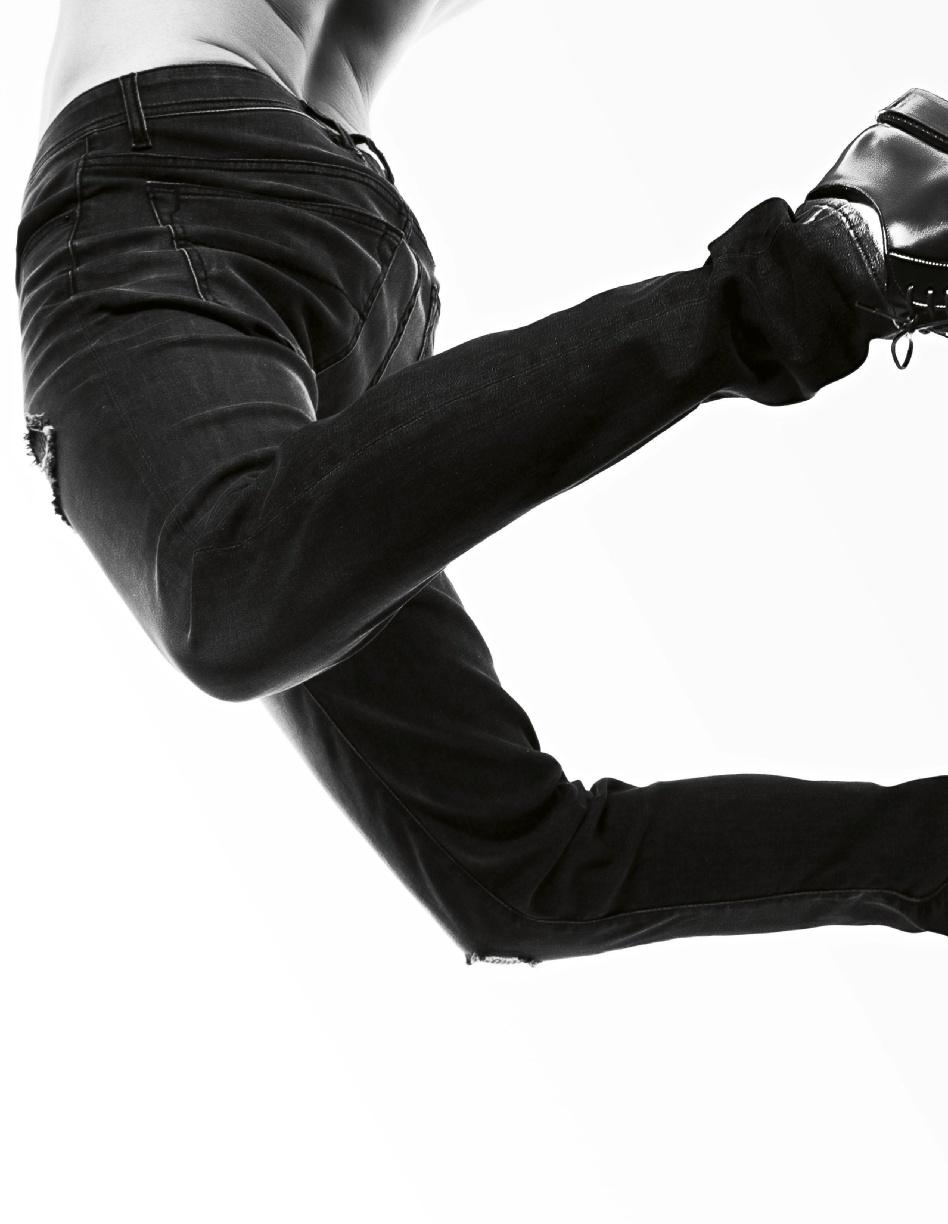
06 Shoes DOUCAL’S
SLIDING DOORS
“Panta rei, but up to a point” by Ursula Beretta
THE EYE ON “Art (ap)art” by Luca Cioffi
OPINION LEADER Angelo Tarfanelli e Giovanni Cecchini / ASAP DESIGNER Justin Son / ESENES Worldwide INTERVIEW Angelo Caroli
VINTAGE The wardrobe of A.N.G.E.L.O.

Tips for buying and where to buy
Emerging
08 12 ISSUE
2022 16 99 20 24 28 64 112 113 124 39 129 136 96 138 146
FASHION Welcome to Mudd Club Jump into the light Metaverso Mistaken shots No face The guardians of the moon ART Silvia Caimi ART Fabius Tita FOCUS ON The magnificent 10 of SS23 FASHION Fashion in the time of war by Giulia Simonotti RUNWAY Woman/Man S/S 2023 REPORTAGE I lack... water by Carlo Olmi WINDOWS
MICAM
designers COMPANY Ducanero CARTOONS “Fashioncartoonist” by Matteo Sessa Vitali
N.28 DECEMBER
Panta rei, but up to a point
by Ursula Beretta Drawing by Joe Colosimo
Il nuovo lusso è tutta una questione di heritage. O meglio, di rilettura di quell’heritage. Iconico, leggendario, fastoso nel pieno senso del termine, ma soprattutto incredibilmente vivo e fecondo. Oggi come ieri. Basterebbe uno sguardo alle ulti me passerelle per avvalorare una tesi che di rivoluzionario ha l’assunto, ovvero il rispetto per qualcosa di grande sottratto alle logiche del tempo e delle tendenze per rimanere un uni cum. Sempre.
Panta rei, ma fino a un certo punto, perché il passato è il vero pro tagonista del presente con una veste, of course, totalmente nuova. E non c’è contraddizione in questa contaminazione temporale in cui designer e direttori creativi affondano le mani perché il punto è sempre uno, ovvero che niente vale più di qualcosa che resiste solidamente al trascorrere delle stagioni. In un mondo velocissimo in cui anche la moda, al netto degli appelli a un ralenti, continua a macinare kilometri come se fosse una velocista, scrivere il futuro attualizzando l’anima (e gli archivi storici) di un marchio o di una maison non è un vezzo ma una direzione. Che in molti hanno scel to. Il perché è semplice. Fermare l’attimo, cristallizzare il momento, mantenere la perfezione: non è questo quello che succede, per esempio, con la chirurgia estetica che cerca di trattenere per sem pre i vessilli di uno splendore che si vorrebbe eterno, aggiungendo, perché no, piccole migliorie in corso d’opera? E allora per quale ragione anche la moda, soprattutto in epoche incerte e soggette a crisi, pandemie, ribaltoni, non dovrebbe rifugiarsi nella sua età dell’oro e da lì, con i dovuti aggiustamenti, andare avanti? È un fatto storico che ha precedenti illustri. Perché l’essenza stes sa della moda è circolare nella misura in cui annulla le distanze temporali seguendo sequenze squisitamente sue che rispondono a logiche di simultaneità tra passato e futuro. Quello, però, che sembrerebbe un eterno ritorno è in realtà il risultato di una dialetti ca affascinante in cui non esistono regole prestabilite, ma solo un punto di partenza. Ovvero, lo spirito del marchio.
Che, alla pari di un patrimonio storico, unico e autentico, è stato scandagliato, riletto, interpretato, esposto e studiato. E mai come oggi le magnifiche sorti di un marchio o di una maison sono servite a certificarne il DNA, la ricchezza, la tradizione facendo emergere quella continuità sottratta alle fluttuazioni del tempo – e di conse guenza, ai suoi turbamenti - che è sinonimo di lusso. Di cui fanno egualmente parte l’estetica riconoscibile, i valori sottesi all’imma ginario, perfino l’engagement che ne giustifica il posizionamento nel contesto culturale e sociale. E la storia o, per dirla in termini commerciali, la company value recuperata dal passato e proiet tata nel presente. Un valore speciale, che garantisce autenticità e legittimazione nei confronti dei clienti in primis, e pure un valore distintivo perché attribuisce al marchio una tradizione preesistente non imitabile e, quindi, un vantaggio competitivo. È il coefficiente di sogno, per semplificare ulteriormente, realizzato grazie a uno storytelling che dà la possibilità, acquistando quel capo o quell’ac cessorio rieditato, di entrare a far parte della storia del marchio e della sua grande famiglia. Una certezza, ancora una volta sottratta ai marosi del tempo. Ne deriva che quella che si potrebbe definire la vita eterna dell’eti chetta viene ricontestualizzata nel presente – riletta o aggiornata, cambiano le sfumature ma la sostanza è la medesima – dai moder ni rabdomanti, ovvero i direttori creativi. Queste figure fondamenta li, che hanno fatto il loro debutto nei primi anni 90 in concomitanza con l’ascesa dei grandi gruppi del lusso, hanno fin da subito avuto il compito di portare avanti la loro visione in cui personale creatività ed heritage si univano in un dialogo fecondo capace di generare commistioni colte e vivaci. Pioniere in questo fu Karl Lagerfeld che, non appena prese le redini di Chanel, si impose di far evolvere lo stile della maison senza mai prescindere dal suo passato come se, in qualche modo, la mano di Mademoiselle Coco rivivesse nella sua. Questione di genio, senza dubbio, che permette che i mar chi si reinventino costantemente senza mai compromettere la loro

8 SLIDING DOORS
08
>
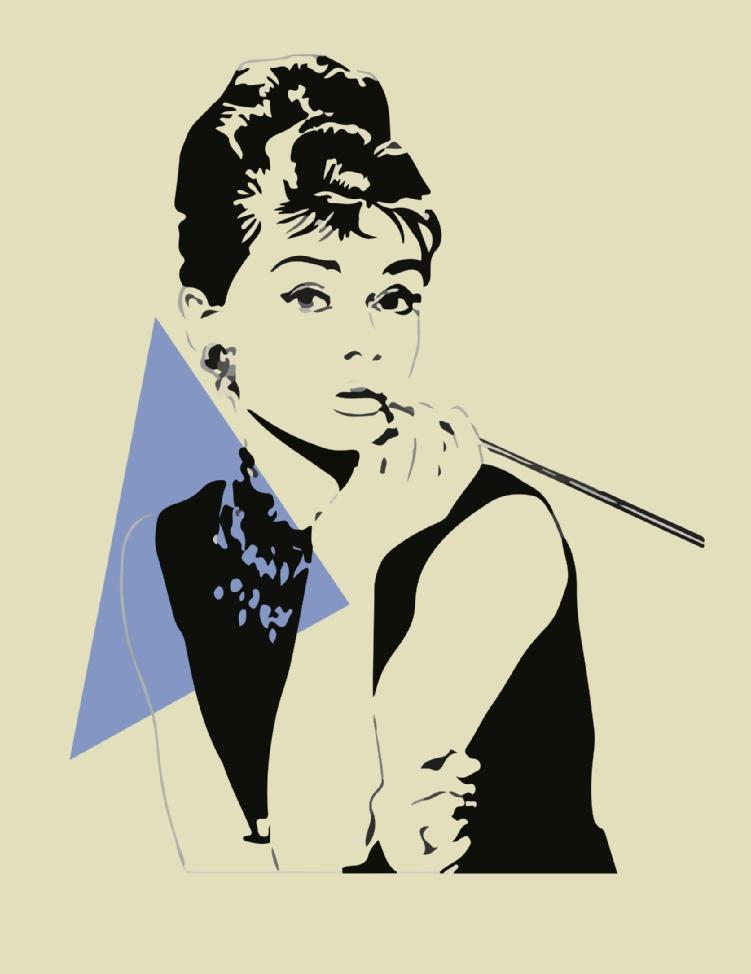
9 SLIDING DOORS
identità. Una verità che ha la forma di una sfida per veri e propri visionari coraggiosi, dalla personalità forte e decisa, che, nel caso di Dior, hanno fatto scuola. La maison francese ha scelto, nel cor so del tempo, direttori creativi che perpetuassero la sua identità e, al contempo, vi infondessero una nuova energia creativa: John Galliano, con la sua mente originale e audace; Raf Simons, che ha ridefinito i codici della couture in chiave design; Hedi Slimane, maestro nel ridisegnare la silhouette dell’uomo Dior fino a rivolu zionare la moda maschile. E ancora Maria Grazia Chiuri che, sotto l’egida di un potente femminismo, ha riletto l’heritage di Dior in un continuo gioco di rimandi temporali capace di attualizzare codi ci e stilemi del passato. Perché il vero lusso all’interno di questo divertissement creativo è dato anche dalla libertà dei designer di lasciarsi ispirare, di poter sguinzagliare la loro visione dentro un universo i cui confini vanno sì tenuti presente, ma possono sere namente essere bypassati. Ne sa qualcosa Pierpaolo Piccioli, che non a caso lo stesso Valentino Garavani considera il suo unico ere de, che ha saputo trasformare in un volano l’eredità potente della maison contaminandola con la sua personalità creativa. Grazie a un’intelligenza sincretica ferocemente puntata sul futuro e sui nuovi valori derivati dal tempo attuale che hanno permesso una stratifi cazione colta di codici, Piccioli ha messo Valentino al centro di una conversazione in cui la memoria di ciò che era stato contenesse le premesse del domani. E l’apoteosi di questo percorso è stata la sfilata “The Beginning” dello scorso luglio in cui la continuità con il passato della maison è stata spezzata da incursioni – manifesto del presente, come l’inclusività estetica che ha guidato la scelta dei modelli in passerella, per dare vita a “un racconto umano, persona le e insieme corale, di una storia ancora da scrivere”.
E come Piccioli anche Anthony Vaccarello da Saint Laurent, Kim Jones per Fendi, Fausto Puglisi da Cavalli, lo stesso Giorgio Arma ni capace di far evolvere il suo linguaggio pur mantenendo chiari i propri codici (e senza mai smettere di stupire), e Miuccia Prada che è ritornata al suo stile netto e preciso di un tempo grazie allo zampi no del partner in crime Raf Simons. E che dire di Dolce & Gabbana che hanno scelto una curatrice d’eccezione, Kim Kardashian, per rileggere il loro archivio in chiave 2.0? La super guest ha indossato i panni di curator di una collezione speciale che ha portato in pas serella vent’anni memorabili della storia del marchio con lo scopo di celebrarne la firma immortale e di renderla fruibile alle nuove ge nerazioni. Già, perché conquistare la generazione smartphone che
vive in un eterno presente con classici senza tempo dotati di una storia è una cosa che Alessandro Michele per Gucci ha saputo fare alla perfezione in collezioni che, come cortocircuiti temporali, han no restituito e restituiscono una memoria aggiornata e ricchissima di cui tutti, ma proprio tutti vogliono fare parte e di cui si nutre, oggi come ieri, il vero lusso.
The new luxury is all about heritage. Or rather, a reinterpretation of that heritage. Iconic, legendary, sumptuous in the full sense of the term, but above all incredibly alive and fertile. Today as yesterday. A glance at the latest catwalks is enough to corroborate a thesis that is revolutionary in its assumption, i.e. respect for something great subtracted from the logic of time and trends to remain uni que. Always.
Panta rei, but up to a certain point, because the past is the real protagonist of the present in a, of course, totally new guise. And there is no contradiction in this temporal contamination in which designers and creative directors sink their hands because the point is always one, namely that nothing is worth more than something that solidly resists the passing of the seasons. In a very fast world in which even fashion, apart from calls for a slow motion, continues to grind out kilometres as if it were a sprinter, writing the future by updating the soul (and the historical archives) of a brand or a mai son is not a quirk but a direction. Which many have chosen. The reason is simple. To stop the moment, to crystallise the moment, to maintain perfection: isn’t this what happens, for example, with cosmetic surgery, which seeks to retain forever the banners of a splendour that one would like to be eternal, adding, why not, small improvements along the way? So why shouldn’t even fashion, especially in uncertain times and subject to crises, pandemics, upheavals, take refuge in its golden age and from there, with the necessary adjustments, move on?
This is a historical fact that has illustrious precedents. Because the very essence of fashion is circular to the extent that it cancels temporal distances by following exquisitely its own sequences that respond to the logic of simultaneity between past and future. What would appear to be an eternal return is actually the result of a fa scinating dialectic in which there are no pre-established rules, only a starting point. Namely, the spirit of the brand.
10 SLIDING DOORS
“The new luxury is all about heritage. Or rather, a reinterpretation of that heritage”
Which, like a unique and authentic historical heritage, has been plumbed, re-read, interpreted, exhibited and studied. And never as today have the magnificent fortunes of a brand or a maison served to certify its DNA, its richness, its tradition, bringing out that con tinuity removed from the fluctuations of time - and consequently, from its upheavals - that is synonymous with luxury. Of which the recognisable aesthetic, the values underlying the imagery, even the engagement that justifies its positioning in the cultural and social context are equally part. And history or, to put it in commercial terms, company value retrieved from the past and projected into the present.
A special value, which guarantees authenticity and legitimacy towards customers in the first place, and also a distinctive value because it gives the brand a pre-existing tradition that cannot be imitated and, therefore, a competitive advantage. It is the dream coefficient, to simplify further, realised thanks to a storytelling that gives the possibility, by purchasing that re-edited garment or ac cessory, to become part of the history of the brand and its great family. A certainty, once again removed from the storms of time. The result is that what could be defined as the eternal life of the label is recontextualised in the present - re-read or updated, the nuances change but the substance is the same - by the modern diviners, the creative directors.
These key figures, who made their debut in the early 1990s at the same time as the rise of the big luxury groups, immediately had the task of carrying forward their vision in which personal creativity and heritage were united in a fruitful dialogue capable of generating cul tured and lively mixtures. A pioneer in this was Karl Lagerfeld who, as soon as he took over the reins of Chanel, set himself the task of evolving the style of the maison without ever disregarding its past as if, in some way, Mademoiselle Coco’s hand revived in his own. A matter of genius, no doubt, which allows brands to constantly rein vent themselves without ever compromising their identity. A truth that takes the form of a challenge for courageous visionaries with a strong and decisive personality, who, in the case of Dior, have set the standard. Over time, the French fashion house has chosen cre ative directors who perpetuate its identity and, at the same time, in fuse it with new creative energy: John Galliano, with his original and audacious mind; Raf Simons, who redefined the codes of couture in a design key; Hedi Slimane, a master in redesigning the silhou ette of the Dior man to the point of revolutionising men’s fashion.
And then there is Maria Grazia Chiuri who, under the aegis of a po werful feminism, has reinterpreted Dior’s heritage in a continuous game of temporal cross-references capable of updating codes and stylistic features of the past. Because the true luxury within this cre ative divertissement also lies in the freedom of the designers to be inspired, to unleash their vision within a universe whose bounda ries must be kept in mind, but which can serenely be bypassed. Pierpaolo Piccioli, whom it is no coincidence that Valentino Gara vani himself considers his sole heir, knows something about this. He has been able to transform the maison’s powerful legacy into a flywheel by contaminating it with his own creative personality. Thanks to a syncretic intelligence fiercely focused on the future and the new values derived from the present time that allowed for a cul tured stratification of codes, Piccioli placed Valentino at the centre of a conversation in which the memory of what had been contained the premises of tomorrow. And the apotheosis of this path was last July’s ‘The Beginning’ fashion show, in which continuity with the maison’s past was broken by incursions - manifestos of the pre sent, such as the aesthetic inclusiveness that guided the choice of models on the catwalk, to give life to “a human tale, personal and at the same time choral, of a story yet to be written”.
And just like Piccioli, Anthony Vaccarello from Saint Laurent, Kim Jones for Fendi, Fausto Puglisi from Cavalli, Giorgio Armani himself, capable of evolving his language while keeping his codes clear (and never ceasing to amaze), and Miuccia Prada who has returned to her clear and precise style of yesteryear thanks to the hand of her partner in crime Raf Simons.
And what about Dolce & Gabbana who have chosen an excep tional curator, Kim Kardashian, to reinterpret their archive in a 2.0 key? The super guest took on the role of curator of a special col lection that brought twenty memorable years of the brand’s history to the catwalk with the aim of celebrating its immortal signature and making it accessible to the new generations. Yes, because con quering the smartphone generation that lives in an eternal present with timeless classics endowed with a history is something that Alessandro Michele for Gucci has been able to do to perfection in collections that, like temporal short circuits, have given back and give back an updated and very rich memory that everyone, but really everyone, wants to be part of and on which true luxury is nourished, today as yesterday.
11 SLIDING DOORS
“Panta rei, but up to a certain point, because the past is the real protagonist of the present in a, of course, totally new guise”

12 THE EYE ON
Art (ap)art
 by Luca Cioffi Drawing by Joe Colosimo
by Luca Cioffi Drawing by Joe Colosimo
Era il 1984 e in una Parigi americanizzata dalle correnti pop e avanguardiste di seconda generazione, l’arte sempre più invadeva l’atelier e la maison, cioè tutti quegli spazi definiti “intoccabili ed imperturbabili” da qualsiasi senso di costrizione. Marc Bohan, in quell’anno, presenta una collezione monotematica, dove ogni goccia di colore era studiata per cadere e occupare uno spazio ben definito, come se l’abito fosse una tavola schematica su cui la casualità rima neva fuori dai bordi e la creatività era studiata per passare l’esame critico dell’arte. E tra linee nere irregolari su pareti di tessuto rosa, la grande casa dell’arte aprì le porte alla moda, riconoscendola non più come copia, ma ulteriore espressione di una genialità artistica: gli abiti di Bohan eressero le mura di una nuova abitazione condi visa dalle due creatività protagoniste di quel tempo. Una collezio ne ispirata a Pollock dove “l’artista è designer e modellista”, come scrissero i giornali di quell’anno, sembrò essere il secondo atto di una crescita spontanea del primigenio abito Mondrian del 1965 di segnato da Yves Saint Laurent. I più oculati vi colsero la riprova del raggiungimento di un’inclusione tanto ambita. Ma Marc Bohan fu solo uno dei primi grandi ammiratori dello spirito museale dell’abito, punto di congiunzione fra arte e moda. Negli anni successivi, infatti, il connubio mutò a favore di una più moderna libertà espressiva. Da Dior a Versace, tutto era forma d’arte a misura d’uomo, a misu ra del corpo, resa indossabile in ogni occasione. Fu proprio Gianni Versace, in un’intervista, a riprendere le parole del critico Dessari per spiegare come la moda faccia da copertura alle fragilità dell’arte e del suo messaggio. Una sorta di protezione che di anno in anno si aggiorna e si impreziosisce di nuovi significati. In seguito, Ferrè, durante gli anni trascorsi da Dior, tradusse in tessuto in movimento, quasi a rendere animati i quadri di Tiziano, Rembrandt e Cezanne. Al contrario l’arte si è sempre servita del costume per narrare un preciso periodo storico, a volte ingannando il pubblico, con opere che attingevano a epoche precedenti. Tutto era sottoposto alla vo lontà dell’arte.
Una lontananza ideale e fisica tra i due mondi percepita non solo nell’ambito moda, ma anche in quello dell’arte, tanto che diversi ar tisti tentarono di riconciliare le due identità. Emblematico l’esempio
dell’artista Sonia Delaunay che, nel 1925, presentò la sua Boutique Simultanee all’Esposizione Universale di Parigi, con l’intento di tra durre i suoi dipinti in abiti e tessuti capaci di incapsulare l’imme diatezza della modernità. L’idea non venne accolta come avrebbe meritato, poiché interpretata più come un atto di profanazione. Il segno di una diffidenza dell’arte che vedeva la moda come un ospite passeggero. Ipotesi smentita dalle collezioni di molti designer venuti dopo e capaci di costruire il proprio successo proprio grazie alla col laborazione con artisti, tanto da rendere la moda stessa esponente di quei movimenti culturali. Accadde per Elsa Schiaparelli e il Surre alismo, un sodalizio durato una vita intera che ha visto un rapporto nato nel privato (quello della designer con Salvador Dali) sfociare in ambito lavorativo. Da quel momento l’abito divenne opera d’arte ancor prima di essere “indumento”, e così nacque anche il mito delle collaborazioni.
Lo stesso Daniel Rosberry, attuale direttore creativo della maison, sembra allargare il campo a una contaminazione artistica che non è più solo surrealista, ma a tratti cubista e neoclassica. E con Schia parelli anche Valentino riprende l’iconografia classica. Un uso predo minante del colore come simbolo di collezioni Couture che ricordano i dipinti di dame del 1700 fiorentino, dove ogni colorazione aveva un significato celato, come il viola ed il giallo, rispettivi sinonimi di sacralità e opulenza. Fino ad arrivare a un più recente Louis Vuitton, in collaborazione con Jeff Koons, che ricopre borse e accessori con stampe raffiguranti i dipinti più noti di Leonardo Da Vinci, Tiziano e degli altri maestri del primo Cinquecento. E se l’arte ora comprende le discipline della produzione video, del balletto e della recitazione sono sempre di più le collezioni di brand come Balenciaga, Coperni e Alexander McQueen a divenire attivisti a sostegno della “causa dell’arte di moda e della moda d’arte”.
Ma non fu solo l’incontro tra designer e artisti a rendere possibile la nascita di questo rapporto, perché fu anche grazie a una comunica zione innovativa che questa unione arte-moda raggiunse il grande pubblico e fu proprio l’editoria a cogliere questa opportunità. L’anno 1951 segna il principio di una comunicazione nuova della moda sulla carta stampata.
13 THE EYE ON
13
>
In quell’anno il fotografo Cecil Beaton realizza un servizio fotografico per Vogue presso la galleria Betty Parsons di New York, dove pre senta le ultime creazioni della Couture davanti a quadri di Jackson Pollock. Un atto rivoluzionario che non venne ben visto dalla stampa conservatrice, come si legge nell’articolo del critico T.J. Clarck ap parso sul New York Times, il quale definì questa sperimentazione come un tentativo infelice di unire arte e industria in una foto. Ma quello che Clarck colse, ancor prima della critica al lavoro di Beaton, fu che, per la prima volta, l’arte si trovava a competere con un’en tità che conosceva il suo stesso processo creativo. Solo nel 1982 il mondo dell’arte riconobbe la moda come forma artistica con un piccolo ma significativo passo: la copertina di Artforum con l’abito di Issey Miyake. L’editoriale di quell’uscita era firmato dalla scrittrice americana Ingrid Sishy e dal critico d’arte italiano Germano Celant, i quali affermavano all’unanimità che la moda poteva essere ricono sciuta come “nuova forma di produzione artistica che mantiene la sua autonomia entrando nella cultura di massa senza distinguere arte e commercio”. Entrambi avevano compreso che era stata la pop art ad aver abbattuto divisioni e pregiudizio, grazie a una co municazione che spiegava alla massa le parole dell’intellettualismo artistico, finendo, così, per porsi una sola domanda: ma la moda è arte? La domanda apparve sul Metropolitan Museum of Art Bullettin, e la risposta fu una sola, senza riserve: si lo è. Fu il pubblico chiama to al voto a rispondere, senza che alcuno potesse sottrarsi, perché come disse Rei Kawakubo: “chiunque si è vestito almeno una volta per andare a vedere un quadro”.
It was 1984 and in a Paris Americanised by second-generation pop and avant-garde currents, art increasingly invaded the atelier and the maison, all those spaces defined as ‘untouchable and imper turbable’ by any sense of constraint. Marc Bohan, in that year, pre sented a monothematic collection, where every drop of colour was designed to fall and occupy a well-defined space, as if the dress were a schematic table on which randomness remained outside the edges and creativity was designed to pass the critical examination of art. And amidst irregular black lines on pink fabric walls, the great house of art opened its doors to fashion, recognising it no longer as a copy, but as a further expression of artistic genius: Bohan’s clothes erected the walls of a new home shared by the two creative prota gonists of that time. A Pollock-inspired collection where “the artist is designer and model”, as the newspapers of that year wrote, see med to be the second act of a spontaneous growth of the primitive Mondrian dress of 1965 designed by Yves Saint Laurent. The more astute saw it as proof of the achievement of a much sought-after inclusion. But Marc Bohan was only one of the first great admirers of the museum spirit of the dress, a point of conjunction between art and fashion. In the following years, in fact, the union changed in favour of a more modern freedom of expression. From Dior to Versace, everything was an art form on a human scale, tailored to the body, made wearable for every occasion. It was Gianni Versace himself, in an interview, who took up the words of the critic Dessari to explain how fashion acted as a cover for the fragility of art and its message. A sort of protection that from year to year is updated and embellished with new meanings. Later, Ferrè, during his years at Dior, translated the paintings of Titian, Rembrandt and Cezanne into moving fabric, almost as if to animate them. On the contrary, art has always used costume to narrate a precise historical period, sometimes misleading the public with works that drew on previous eras. Everything was subject to the will of art. An ideal and physical distance between the two worlds perceived not only in fashion, but also in art, so much so that several artists
attempted to reconcile the two identities. Emblematic is the example of the artist Sonia Delaunay who, in 1925, presented her Boutique Simultanee at the Exposition Universelle in Paris, with the intention of translating her paintings into clothes and fabrics capable of en capsulating the immediacy of modernity. The idea was not received as it deserved, as it was interpreted more as an act of desecration. The sign of a distrust of art that saw fashion as a passing guest. An assumption belied by the collections of many designers who came later and were able to build their success precisely thanks to collaboration with artists, to the extent that fashion itself became an exponent of those cultural movements. This was the case with Elsa Schiaparelli and Surrealism, a lifelong association that saw a relationship born in private (that of the designer with Salvador Dali) blossom into work. From that moment on, the dress became a work of art even before being a ‘garment’, and so the myth of collabora tions was born. Daniel Rosberry himself, the fashion house’s current creative director, seems to be broadening the field to an artistic con tamination that is no longer just surrealist, but at times cubist and neoclassical. And with Schiaparelli, Valentino too takes up classical iconography. A predominant use of colour as a symbol of Couture collections reminiscent of the paintings of ladies in the Florentine 1700s, where each colour had a hidden meaning, such as purple and yellow, respective synonyms of sacredness and opulence. Up to a more recent Louis Vuitton, in collaboration with Jeff Koons, which covers bags and accessories with prints depicting the most famous paintings of Leonardo Da Vinci, Titian and the other masters of the early 16th century. And if art now encompasses the disci plines of video production, ballet and acting, it is increasingly the collections of brands such as Balenciaga, Coperni and Alexander McQueen that become activists in support of the “cause of fashion art and art fashion”. But it was not only the encounter between designers and artists that made this relationship possible, because it was also thanks to inno vative communication that this art-fashion union reached the general public, and it was the publishing industry that seized this opportuni ty. The year 1951 marked the beginning of a new communication of fashion in print. In that year, photographer Cecil Beaton did a photo shoot for Vogue at the Betty Parsons gallery in New York, where he presented the latest Couture creations in front of paintings by Jackson Pollock. A revolutionary act that was not well seen by the conservative press, as stated in the article by critic T.J. Clarck in the New York Times, who described this experimentation as an unfortu nate attempt to combine art and industry in a photo. But what Clarck grasped, even before the criticism of Beaton’s work, was that, for the first time, art was competing with an entity that knew its own creative process. It was not until 1982 that the art world recognised fashion as an art form with a small but significant step: the cover of Artforum with Issey Miyake’s dress. The editorial of that issue was signed by the American writer Ingrid Sishy and the Italian art critic Germano Celant, who unanimously affirmed that fashion could be recognised as a “new form of artistic production that maintains its autonomy by entering mass culture without distinguishing between art and commerce”. Both had understood that it was pop art that had broken down divisions and prejudices, thanks to a communica tion that explained the words of artistic intellectualism to the masses, thus ending up asking only one question: but is fashion art? The question appeared in the Metropolitan Museum of Art Bulletin, and the answer was one, without reservation: yes, it is. It was the public that was called to vote, and no one could evade it, because as Rei Kawakubo said: “everyone has dressed up at least once to go and see a painting”.
14 THE EYE ON
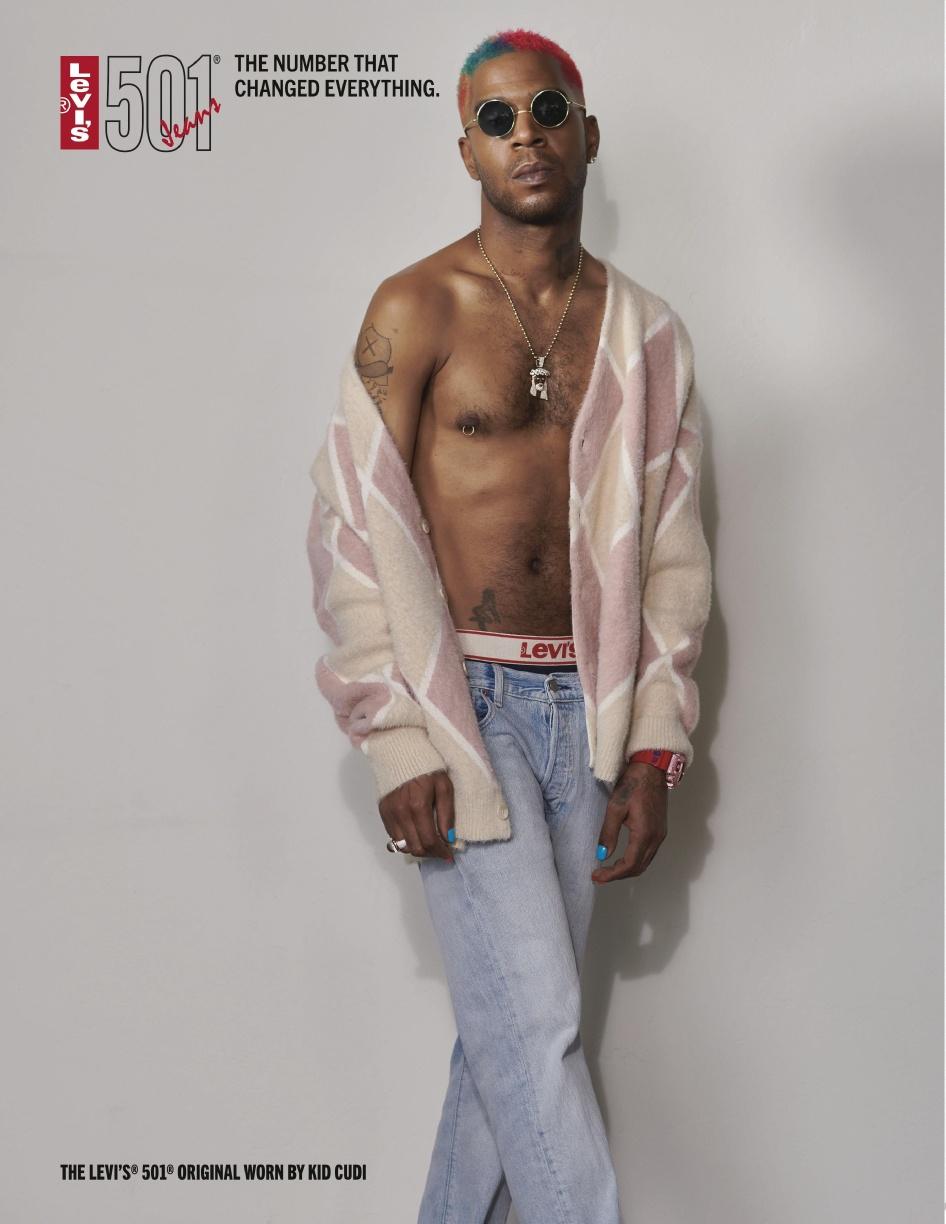

16 OPINION LEADER
17
Angelo Tarfanelli e Giovanni Cecchini / ASAP
Research abroad and have a flair for new trends
“
Ci piace tutto ciò che è insolito”. Asap LTD (asaplimited.com) è un distributore di calzature nato in Italia nel 1989. Angelo Tarfanelli e Giovanni Cecchini, i due fondatori, condividevano il sogno di portare Dr. Martens in Italia, e dopo esserci riusci ti hanno continuato ad espandere il proprio portfolio guidati proprio dalla voglia di portare in Italia marchi belli, di qualità e, appunto, insoliti. Oggi, ASAP rappresenta uno dei più im portanti distributori di moda in Italia, con brand del calibro di Dr. Martens, Ugg, Karl Kani, Buffalo, Palladium, Steve Madden, Kawasaki, Kurt Geiger, Sam Edelman, Juicy Couture, Circus, Jef frey Campbell, New Rock, Mezcalero, Los Angeles Apparel, Naked Wolfe, Creative Recreation e Windsor Smith, e molti altri. Conta circa quaranta dipendenti fra la sede di Firenze, i due show room, nel capoluogo toscano e a Milano, e il magazzino, dove tut te le merci vengono ricevute, controllate e spedite direttamente ai clienti.
Come nasce la vostra avventura?
“La prima ispirazione è sorta grazie alle calzature del brand George Cox, un piccolo calzaturificio a nord di Londra che produsse le pri me creepers indossate a fine anni ’70 da molte band inglesi in stile Sex Pistols. Nel 1989 ci venne l’idea di riportare in auge il brand in Italia. Ci accomunava la passione per la musica rock e le mode bri tanniche. Quello stesso anno venimmo in contatto con la fabbrica di scarpe R. Giggs & Co che produceva le Dr. Martens, al tempo scarpe con puntale in ferro realizzate per la working class inglese e amatissime dai punk dell’epoca. Scommettemmo sul marchio e lo portammo in Italia per trasformarlo in un accessorio moda. En trambe le intuizioni si rivelarono un enorme successo”.
Da allora quali cambiamenti di mercato rilevereste?
“Fino agli inizi del nuovo millennio la moda era più lenta. Non si assisteva a cambiamenti di tendenza così repentini e i fenomeni moda duravano più a lungo.
Il cambiamento più recente, invece, è stato sollecitato dal Covid che ha cambiato le abitudini delle persone: oggi si acquista meno e con più attenzione. Si valutano gli acquisti con parsimonia e ocula tezza, informandosi tantissimo sui vari media. I desideri puntano su marchi del tutto nuovi oppure su vecchi ricordi che si riaffacciano sul mercato”.
Quali i vostri punti di forza?
“La ricerca continua a livello internazionale che viaggia dalla strada alle vetrine, dalle piccole fabbriche al panorama musicale. Altro valore aggiunto di ASAP è l’esserci guadagnati la possibilità di far produrre ai brand che rappresentiamo modelli esclusivi e perfet tamente in linea con il mercato italiano”.
Ci sono delle regole che vi guidano nella selezione dei marchi? “Ovviamente non esiste la formula magica. Abbiamo costruito la nostra carriera prendendoci molti rischi: talvolta è andata molto bene, altre volte male.
Il nostro occhio cade spesso su marchi che propongono collezioni con caratteristiche molto particolari e distintive che altri trovano dif ficili da piazzare sul mercato. Per noi sono una sfida, anzi meglio, per noi è un piacere accompagnarli al successo.
Più di una volta abbiamo proposto prodotti inizialmente ritenuti troppo strani, benché capaci di richiamare l’attenzione. Dopo un’i niziale diffidenza esplodono e sono sulla bocca di tutti.
17 OPINION LEADER
>
Tra i casi più recenti citerei Kito Wares. Un artista americano che ha debuttato nel 2020 nel mondo della moda e in particolare nel settore delle calzature, con le sneakers Passion of the Christ e la slide Kito Wares Jag Runner”.
In questo momento cosa cercano i buyer della distribuzione? “I negozi cercano prodotti nuovi, emergenti da cui poter ottenere anche una marginalità migliore, che offrano una buona qualità e un contenuto innovativo.
Al tempo stesso il Covid ha lasciato dietro di sé una scia di scetti cismo su cui i compratori inciampano: cercano la novità, ma sono molto attenti e talvolta titubanti nel selezionarle. Fino a qualche anno fa, invece, la risposta era molto più immediata e, potremmo dire, istintiva. Una situazione causata anche da budget sempre più poveri in cui è difficile trovare spazio per la sperimentazione. Diverso il discorso per l’online che concede ancora poco più di spazio per alcuni tentativi, prove e azzardi.
Ora la guerra e l’inflazione non aiutano. Già da questa estate mol ti si aspettavano una propensione agli acquisti fortemente in calo verso la fine dell’anno e, quindi, i compratori sono rimasti molto conservativi e oculati rispetto agli ordini”.
Il luogo che secondo voi genererà i prossimi trend?
“In questo momento la West Coast degli Stati Uniti è senza dub bio il luogo più interessante al mondo, dove c’è fermento, dove nascono di continuo piccoli nuovi marchi molto interessanti, dove l’industria musicale sperimenta nuove strade con tanti nuovi artisti. È senza dubbio il luogo da cui emaneranno molte delle future ten denze. Lì si concentrano tante piccole startup che utilizzano la tec nica di vendita dei drop e realizzano ottime marginalità. È evidente che si stia aprendo una nuova era nell’esperienza di vendita. Un sistema che appassiona il consumatore perché gli regala la sen sazione di fare suo un prodotto nuovissimo e che ha il carattere di
unicità, vista la tiratura limitata dei pezzi a disposizione. A Los Angeles si percepisce proprio un incredibile fermento ed en tusiasmo del mondo giovanile”.
“We like everything that is unusual”. Asap LTD (asaplimited.com) is a shoe distributor founded in Italy in 1989. Angelo Tarfanelli and Giovanni Cecchini, the two founders, shared the dream of bringing Dr. Martens to Italy, and having succeeded, they continued to ex pand their portfolio driven by the desire to bring beautiful, quality and, indeed, unusual brands to Italy. Today, ASAP represents one of the most important fashion distributors in Italy, with brands of the calibre of Dr. Martens, Ugg, Karl Kani, Buffalo, Palladium, Steve Madden, Kawasaki, Kurt Geiger, Sam Edelman, Juicy Couture, Cir cus, Jeffrey Campbell, New Rock, Mezcalero, Los Angeles Appa rel, Naked Wolfe, Creative Recreation and Windsor Smith, among many others. It has about forty employees between the head office in Florence, the two showrooms, in the Tuscan capital and in Milan, and the warehouse, where all goods are received, checked and shipped directly to customers.
How did your adventure start?
“The first inspiration came from the footwear of the George Cox brand, a small shoe factory in north London that produced the first creepers worn in the late 1970s by many English bands in the Sex Pistols style. In 1989 we came up with the idea of bringing the brand back to Italy. We shared a passion for rock music and British fashions. That same year we came into contact with the shoe factory R. Giggs & Co, which produced Dr. Martens, at the time iron-toed shoes made for the English working class and much loved by the punks of the time. We bet on the brand and brought it to Italy to turn it into a fashion accessory. Both intuitions turned out to be a huge success”.
18 OPINION LEADER
“The most recent change has been prompted by Covid, which has changed people’s habits: now they buy less and more carefully”
Since then, what market changes have you noticed?
“Until the beginning of the new millennium, fashion was slower. We did not see such sudden changes in trends and fashion phenome na lasted longer.
The most recent change, on the other hand, has been prompted by Covid, which has changed people’s habits: now they buy less and more carefully. People consider their purchases sparingly and wisely, informing themselves a great deal in the various media. De sires point to completely new brands or to old memories that are coming back onto the market”.
What are your strengths?
“Continuous international research that travels from the street to shop windows, from small factories to the music scene. Another added value of ASAP is that we have earned the possibility of having the brands we represent produce exclusive models that are perfectly in line with the Italian market”.
Are there any rules that guide you in the selection of brands?
“Obviously there is no magic formula. We have built our career by taking many risks: sometimes it has gone very well, other times badly. Our eye often falls on brands that propose collections with very particular and distinctive characteristics that others find diffi cult to place on the market.
For us they are a challenge, or rather, for us it is a pleasure to accompany them to success. More than once we have proposed products that were initially considered too strange, although ca pable of attracting attention. After an initial diffidence they explode and are on everyone’s lips.
Among the most recent cases I would mention Kito Wares. An American artist who debuted in 2020 in the world of fashion and in particular in the footwear sector, with the trainers Passion of the Christ and the Kito Wares Jag Runner slide”.
What are retail buyers looking for at the moment?
“Retailers are looking for new, emerging products from which they can also get better margins, which offer good quality and innova tive content.
At the same time, Covid has left behind a trail of scepticism on which buyers are stumbling: they are looking for novelty, but are very careful and sometimes hesitant to select them. Until a few years ago, on the other hand, the response was much more imme diate and, we might say, instinctive.
A situation also caused by increasingly poor budgets in which it is difficult to find room for experimentation. The discourse is different for online, which still allows little more room for some attempts, trials and daring.
Now the war and inflation do not help. As early as this summer, many were already expecting a strongly declining propensity to buy towards the end of the year and, therefore, buyers remained very conservative and cautious with regard to orders”.
The place that you think will generate the next trends?
“Right now, the West Coast of the United States is undoubtedly the most interesting place in the world, where there is buzz, where very interesting new brands are being born all the time, where the music industry is experimenting in new ways with many new artists. It is undoubtedly the place from where many of the future trends will emanate.
A lot of small start-ups that use the drop-selling technique and make very good margins are concentrated there. It is clear that a new era in the sales experience is opening up. A system that fa scinates consumers because it gives them the feeling of getting a brand new product that has the character of uniqueness, given the limited number of pieces available.
In Los Angeles, one can really sense an incredible ferment and enthusiasm of the youth world”.
19 OPINION LEADER
“Retailers are looking for new, emerging products from which they can also get better margins, which offer good quality and innovative content”
Justin Son / ESENES Worldwide
A brand/community for those tired of conforming
Nel 2020, il designer Justin Son lancia ESENES Worldwide, superando i confini di quella New York City che lo ha introdotto nel mondo degli accessori moda. ESENES (pronunciatelo così: SNS), è un acro nimo esteso di “Sorry Not Sorry”. Questa scelta di nome, che suona anche come claim, esprime l’idea di non doversi mai dispiacere per la propria identità. Esenes Worldwide vuole essere un brand/comunità per chiunque sia stanco di conformarsi alle norme sociali.
I concetti cari a Son si ritrovano e manifestano proprio nelle colle zioni che propone: modelli di calzature e abbigliamento che sfrut tano la materialità in modo unico, che difficilmente trova precedenti in esperienze moda del passato.
La scarpa di maggior successo del brand statunitense, la OOZE Airs, ha guadagnato popolarità sfruttando i social media e regi strando il tutto esaurito entro la prima ora dal lancio. Da allora, il marchio ha proposto oltre 50 diversi stili di calzature e abbigliamen to, attirando l’attenzione del pubblico dei Millennial e della Gen-Z. Esenes Worldwide continuerà a spingere sempre un po’ più in là i limiti del fashion design concettuale, coinvolgendo e ispirando la propria comunità a celebrare l’identità e l’individualità.
A Justin Son chiediamo qual è stato il suo percorso prima che ESENES prendesse forma?
“Il marchio è nato nel 2020. La mia storia è quella di un artista/de signer che due anni prima si trasferisce dalla West Coast degli Stuti Uniti a New York alla ricerca di migliori opportunità creative. Occa sioni che effettivamente si sono concretizzate: ho trovato lavoro come designer di calzature, ho imparato molto, e le competenze acquisite le ho investite sul mio progetto artistico e creativo. Così nasce Esenes Worldwide”.
Quali i valori che vi sta a cuore trasmettere con le vostre creazioni?
“Cerchiamo di prenderci cura di una comunità di persone libere,
che la pensano come noi, così da realizzare uno spazio sicuro per far brillare le nostre luci senza essere giudicati o senza do verci piegare alle regole di uniformità della società. Molta dell’i spirazione la traiamo dalla nostalgia e dai momenti della nostra giovinezza con cui tutti cerchiamo in modo subliminale di trovare una connessione”.
Cosa vi riserva il futuro?
“Abbiamo molti progetti interessanti all’orizzonte. Capi e calzature ispirati alla natura o che incoraggino a essere attivi e a vivere di più all’aperto. I nuovi accessori rappresenteranno un’evoluzione dei modelli precedenti, così da radicare lentamente un’identità di marchio”.
Dove producete e come vi ponete rispetto ai temi della soste nibilità?
“In questo momento stiamo puntando molto sull’artigianato affi dandoci alla cultura e alle competenze di diversi paesi nel mondo. Lavoriamo con diverse fabbriche in Italia, Spagna, Corea e Cina. Per quanto riguarda la sostenibilità posso solo anticipare che stia mo sviluppando una scarpa completamente sostenibile e vegana, il cui lancio è previsto per il prossimo anno”.
Come è strutturata la vostra distribuzione?
“Oltre ad affidarci una rete di professionisti, come l’agenzia ASAP, puntiamo moltissimo sull’e-commerce, le mailing list, Instagram e Facebook, o sulla cassa di risonanza di piattaforme come Com plex, IG, Modern Notoriety, FFFiles”.
A quali fiere partecipate?
“Lineapelle, Complexcon e alcune altre. Ad essere sincero, però, non amo tanto questi eventi e ne farei volentieri a meno. Il mio obiettivo è tracciare un nuovo percorso, diverso dell’esperienza tradizionale del settore calzaturiero. Preferirei organizzare, e lo farò, eventi pop-up a livello locale a San Francisco, Los Angeles e New York. Li sento più nelle mie corde”.
20 DESIGNER
>
20
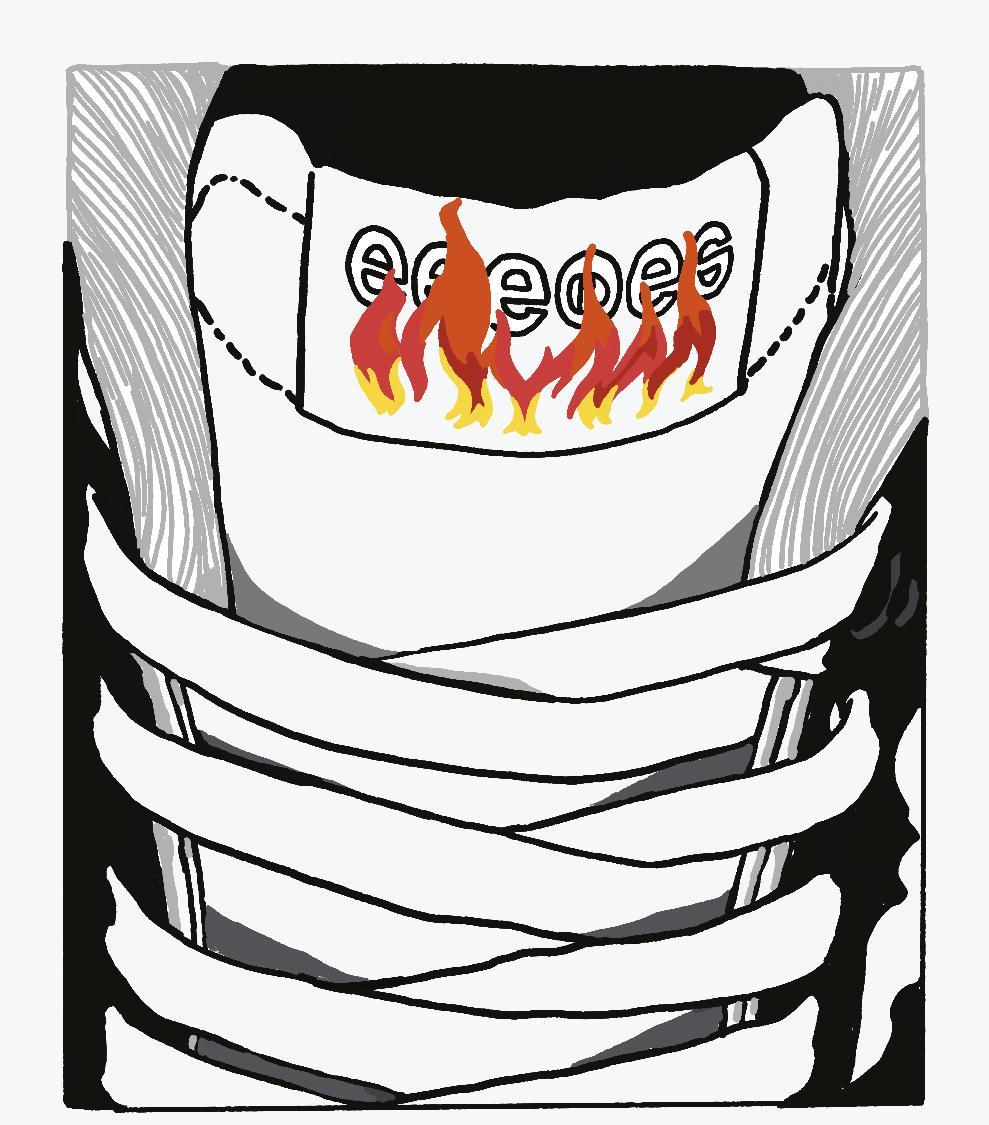
21 DESIGNER
In 2020, designer Justin Son launched ESENES Worldwide, tran scending the boundaries of the New York City that introduced him to the world of fashion accessories.
ESENES (pronounced SNS), is an extended acronym for ‘Sorry Not Sorry’. This choice of name, which also sounds like a claim, ex presses the idea of never having to feel sorry for one’s identity. Ese nes Worldwide wants to be a brand/community for anyone who is tired of conforming to social norms.
The concepts dear to Son can be found and manifested in the very collections it offers: footwear and clothing models that exploit materiality in a unique way that hardly finds precedent in fashion experiences of the past.
The US brand’s most successful shoe, the OOZE Airs, gained po pularity by exploiting social media and selling out within the first hour of its launch. Since then, the brand has offered over 50 dif ferent styles of footwear and apparel, attracting the attention of Millennials and Gen-Z audiences. Esenes Worldwide will continue to push the boundaries of conceptual fashion design, engaging and inspiring its community to celebrate identity and individuality.

We ask Justin Son what was his journey before ESENES took shape?
“The brand was born in 2020. My story is that of an artist/designer who two years earlier moved from the West Coast of the United States to New York in search of better creative opportunities. Op portunities that actually materialised: I got a job as a shoe designer, I learnt a lot, and the skills I acquired I invested in my artistic and creative project. This is how Esenes Worldwide was born”.
What values do you care about conveying with your creations?
“We try to care for a community of free, like-minded people, so that we can create a safe space for our lights to shine without being
judged or having to bow to society’s rules of uniformity. Much of our inspiration comes from nostalgia and the moments of our youth with which we all subliminally try to find a connection”.
What does the future hold for you?
“We have many interesting projects on the horizon. Garments and footwear inspired by nature or encouraging people to be active and experience more outdoors. New accessories will be an evolution of previous models, so that a brand identity will slowly take root”.
Where do you produce and how do you approach sustainability issues?
“Right now, we are focusing a lot on craftsmanship, relying on the culture and expertise of different countries around the world. We work with several factories in Italy, Spain, Korea and China. As far as sustainability is concerned, I can only anticipate that we are developing a completely sustainable and vegan shoe, which is due to be launched next year”.
How is your distribution structured?
“Besides relying on a network of professionals, such as the agency ASAP, we rely heavily on e-commerce, mailing lists, Instagram and Facebook, or on the sounding board of platforms such as Com plex, IG, Modern Notoriety, FFFiles”.
Which trade fairs do you participate in?
“Lineapelle, Complexcon and a few others. To be honest, though, I don’t like these events so much and would gladly do without them. My aim is to chart a new course, different from the traditional ex perience of the shoe industry. I would prefer to organise, and will do, pop-up events locally in San Francisco, Los Angeles and New York. I feel they are more in my wheelhouse”.
22 DESIGNER
“We try to care for a community of free, like-minded people, so that we can create a safe space for our lights to shine without being judged or having to bow to society’s rules of uniformity”


24
INTERVIEW
Angelo Caroliph. R. Manzotti
Angelo Caroli /
A.N.G.E.L.O.
When true vintage gives personality
Ogni giovedì sera il giovanissimo Angelo Caroli frequen tava le prime radio libere per consigliare agli ascoltatori come scegliere i pezzi giusti da indossare. È il 1978, non è ancora maggiorenne, quando fonda A.N.G.E.L.O. Nutre già una passione per il collezionismo di abiti e accessori di diverse epoche e provenienze. Una pura attrazione estetica, all’inizio, che si trasforma presto in un progetto consacrato al recupero, al riciclo e alla conservazione della memoria della moda. Oggi, l’A.N.G.E.L.O. Vintage Palace a Lugo di Ravenna è tra i più importanti negozi e archivi di moda vintage d’Europa: un vero e proprio tempio di quattro piani consacrato al culto del vintage, mecca dei professionisti del settore e della schiera sempre più folta degli appassionati di pezzi unici, attenti al tema della sostenibilità. A questa location ammantata di fascino si affianca l’A.N.G.E.L.O. VINTAGE LAB, in Piazza Nenni 23 a Faenza (Ravenna), con una selezione particolarmente attenta ai gusti e alle tasche dei giova ni, e L’ARCHIVIO, che ha sede in un suggestivo palazzo di 2500 metri quadri, già orfanotrofio nella prima metà del Novecento. A pochi passi dalla sede principale, in Corso Garibaldi 51/53 a Lugo, custodisce oltre 150.000 capi e accessori databili tra la fine dell’Ot tocento e i primi anni 2000, disponibili esclusivamente per consul tazione e noleggio per i professionisti del settore. Infine, oltre alla sede fisica, A.N.G.E.L.O. offre una shopping expe rience online (angelovintage.com), con una selezione accurata di abbigliamento e accessori di lusso e non.
Se si ritrovasse in radio oggi, che consigli di stile darebbe? “Riutilizzate! La mia carriera è nata e si è sviluppata intorno a que sto concetto, quando ancora il tema della circolarità e della soste nibilità neppure si scorgeva all’orizzonte. A maggior ragione oggi lo riproporrei. E non solo come consiglio, ma come una vera e propria necessità. A quanto detto affiancherei un concetto per me altrettanto importante: l’attenzione per lo stile. Un certo gusto non deve mai mancare, anche quando si ripescano abiti e accessori negli armadi o sotto naftalina. Come ci si veste è il primo biglietto da visita che racconta molto di noi. Consiglierei di scegliere un look che permetta di risultare esclusivi, non per snobismo, ma per esal tare le proprie peculiarità e staccarsi dagli standard”.
Quale sarebbe il tocco di stile che suggerirebbe? “Un’accurata ricerca di accessori moda realmente vintage. Che non significa rovistare in pezzi di 10 anni fa, ma andare a caccia di articoli degli anni ‘60, ‘70 e ‘80 che davvero possono raccontare una storia e attraverso quella storia, definire una personalità.

25 INTERVIEW
>
25
Chi cerca il pezzo giusto negli ‘armadi’ del secolo scorso dimostra una sensibilità maggiore verso una moda che vuole esprimere uno stile, rispetto a chi va a caccia di collezioni di qualche stagione in dietro per esprimere uno status symbol a prezzi scontati”.
Cosa terrebbe da parte oggi, per riproporla fra 20 o 30 anni?
“Per scelta non guardo la moda attuale con l’occhio del contem poraneo, anche perché i designer, che rappresentano una buona parte della mia clientela, mi chiedono di fornire spunti per il futuro. Cerco sempre di osservare la moda da lontano, di non guardare mai alla singola stagione, ma sempre al gusto di un decennio. In questo momento, per esempio, sono tornati alla ribalta i desi gner minimalisti giapponesi, mentre il pubblico più giovane apprez za marchi come Stone Island e Best Company. Piace molto uno stile capace di esprimere il lusso nello sportswear.
Se invece si vuole puntare l’attenzione sulle grandi firme, bisogna citare Chanel, Hermès e Louis Vuitton. Ormai alcuni loro pezzi van tano quotazioni da collezionismo, 10 volte superiori agli anni ‘90 in cui sono apparsi per la prima volta”.
Quali caratteristiche connotano un pezzo che diventerà iconi co nel tempo?
“Se avessi un excel con le caratteristiche da spuntare sarei l’uomo più ricco del mondo. È difficile stilare un elenco di fattori predefiniti perché sono molte le varianti che intervengono nel decretare il suc cesso di un pezzo vintage. Negli anni ho capito che devono sussi stere alcune caratteristiche di fondo imprescindibili: una fattura di altissima qualità; l’aver destato forte interesse al momento della pri ma uscita sul mercato; essere caduto nell’oblio prima di riproporsi sulla bocca di tutti. Un esempio: la borsa Bagonghi di Roberta Di Camerino riscosse moltissima attenzione, quando uscì negli anni ‘60; la stessa che ebbe intorno al 2010, quando si impose di nuovo come oggetto di culto”.
Il concetto di seconda mano piace a molti, soprattutto ai più giovani. Concorda?
“Sono molto contento della grande attenzione che i giovani dedica no al tema della sostenibilità. Sono capaci di staccarsi dal mero fe nomeno delle tendenze per trovare nel second hand una soluzione di stile non di ripiego, ma di valore. Ritrovo in loro lo spirito con cui ho iniziato la mia avventura più di 40 anni fa. Mai avrei immaginato che un giorno mi avrebbero accompagnato così tanti compagni di viaggio e avrei suscitato così tanta attenzione”.
Dove trova i pezzi che ripropone nei suoi A.N.G.E.L.O.? “Se in passato concludevo i miei acquisti principalmente negli Stati Uniti o recuperando i vestiti in buono stato che le persone buttavano via, oggi è sempre più frequente che io acquisti interi guardaroba da persone appassionate che, nel tempo, hanno ac quistato capi interessanti per i più svariati motivi. Di recente ho comprato giacche molto eccentriche, anni ‘90, dall’ex proprietario di una discoteca. Una nobildonna, invece, mi ha venduto una serie di abiti da sera confezionati negli anni Sessanta per partecipare alle annuali crociere. Un abito diverso per ogni serata: la prima era la più importante, mentre l’ultima aveva sempre per tema un colo re. Il bello è che ciascuno di questi guardaroba racconta la storia di una vita e svela una personalità. È bellissimo quello che mi ha detto quella signora: ‘Vorrei che questi abiti regalassero ad altre giovani donne la stessa gioia che ho provato quando li ho indossati io tanti anni fa’. A dimostrazione che il vintage è molto più che un tocco di stile dal passato, ma un vero e proprio racconto di intere generazioni”.
Every Thursday night, the very young Angelo Caroli attended the first free radio stations to advise listeners on how to choose the right pieces to wear. It was 1978, not yet of age, when he founded A.N.G.E.L.O. He already nurtured a passion for collecting clothes and accessories from different eras and backgrounds. A pure ae sthetic attraction, at first, which soon turned into a project devo ted to the recovery, recycling and preservation of the memory of fashion.
Today, the A.N.G.E.L.O. Vintage Palace in Lugo di Ravenna is among the most important vintage fashion stores and archives in Europe: a veritable four-story temple consecrated to the cult of vintage, a mecca for industry professionals and the ever-growing ranks of unique, sustainability-conscious enthusiasts.
This location cloaked in charm is joined by A.N.G.E.L.O. VINTAGE LAB, at 23 Piazza Nenni in Faenza (Ravenna), with a selection par ticularly attentive to the tastes and pockets of young people, and L’ARCHIVIO, which is housed in an evocative 2500sm building, for merly an orphanage in the first half of the twentieth century. A few steps away from the main headquarters, at Corso Garibaldi 51/53 in Lugo, it houses more than 150,000 garments and accessories dating from the late nineteenth century to the early 2000s, available exclusively for consultation and rental for industry professionals.
26 INTERVIEW
“A careful search for truly vintage fashion accessories. That doesn’t mean rummaging through pieces from 10 years ago...
Finally, in addition to the physical location, A.N.G.E.L.O. offers an online shopping experience (angelovintage.com), with a careful se lection of luxury and non-luxury clothing and accessories.
If you found yourself on the radio today, what style advice would you give?
“Reuse! My career was born and developed around this concept, when the theme of circularity and sustainability was still not even on the horizon. All the more reason today I would reintroduce it. And not just as advice, but as a real necessity.
To the above I would add an equally important concept for me: attention to style. A certain taste should never be lacking, even when fishing out clothes and accessories from closets or under mothballs. How we dress is the first calling card that tells a lot about us. I would recommend choosing a look that allows one to be exclusive, not out of snobbery, but to enhance one’s peculiari ties and break away from standards.”
What style touch would you suggest?
“A careful search for truly vintage fashion accessories. That doesn’t mean rummaging through pieces from 10 years ago, but hunting for items from the ‘60s, ‘70s and ‘80s that really can tell a story and through that story, define a personality. Those who look for the right piece in the ‘closets’ of the last century show a greater sensitivity to a fashion that wants to express a style, than those who hunt for collections from a few seasons back to express a status symbol at discounted prices.”
What would you keep aside today to repurpose 20 or 30 years from now?
“By choice, I don’t look at current fashion with the eye of the con temporary, partly because the designers, who represent a good part of my clientele, ask me to provide insights for the future. I always try to look at fashion from a distance, to never look at a single season, but always at the taste of a decade. Right now, for example, Japanese minimalist designers are back in the limelight, while younger audiences appreciate brands like Stone Island and Best Company. People really like a style that can express luxury in sportswear.
If, on the other hand, one wants to focus on the big names, one must mention Chanel, Hermès, and Louis Vuitton. By now some of their pieces boast collector’s prices, 10 times higher than in the 1990s when they first appeared.”
What characteristics connote a piece that will become iconic over time?
“If I had an excel with characteristics to tick off I would be the ri chest man in the world. It is difficult to make a list of predefined fac tors because there are so many variations involved in decreeing the success of a vintage piece. Over the years, I have come to realize that there must be a few inescapable underlying characteristics: a workmanship of the highest quality; having aroused strong interest when it was first released on the market; having fallen into oblivion before reappearing on everyone’s lips. Case in point: Roberta Di Camerino’s Bagonghi bag garnered a lot of attention when it came out in the 1960s; the same attention it had around 2010, when it imposed itself again as a cult object.”
The concept of second hand appeals to many people, espe cially the younger ones. Do you agree?
“I am very pleased with the great attention young people pay to the issue of sustainability. They are able to detach themselves from the mere phenomenon of trends to find in the second hand a style solution that is not a fallback, but a valuable one. I find in them the spirit with which I began my adventure more than 40 years ago. Never would I have imagined that one day I would be accompanied by so many fellow travelers and attract so much attention.”
Where do you find the pieces you repurpose in your A.N.G.E.L.O. shops?
“If in the past I used to conclude my purchases mainly in the Uni ted States or by salvaging clothes in good condition that people threw away, today it is increasingly common for me to buy entire wardrobes from passionate people who, over time, have purcha sed interesting garments for a variety of reasons. I recently bought very eccentric, 1990s jackets from the former owner of a nightclub. A noblewoman, on the other hand, sold me a series of evening gowns made in the 1960s for attending annual cruises. A different dress for each evening: the first was the most important, while the last always had a color theme. The beauty is that each of these wardrobes tells the story of a life and reveals a personality. It is be autiful what that lady said to me: ‘I wish these dresses would give other young women the same joy I felt when I wore them all those years ago’. Proving that vintage is more than just a touch of style from the past, but a true story of entire generations”.
27 INTERVIEW
...but hunting for items from the ‘60s, ‘70s and ‘80s that really can tell a story and through that story, define a personality.”
The wardrobe of A.N.G.E.L.O.
by Angelo Lanza Fashion by Luca Termine

Total look VERSACE
Photos
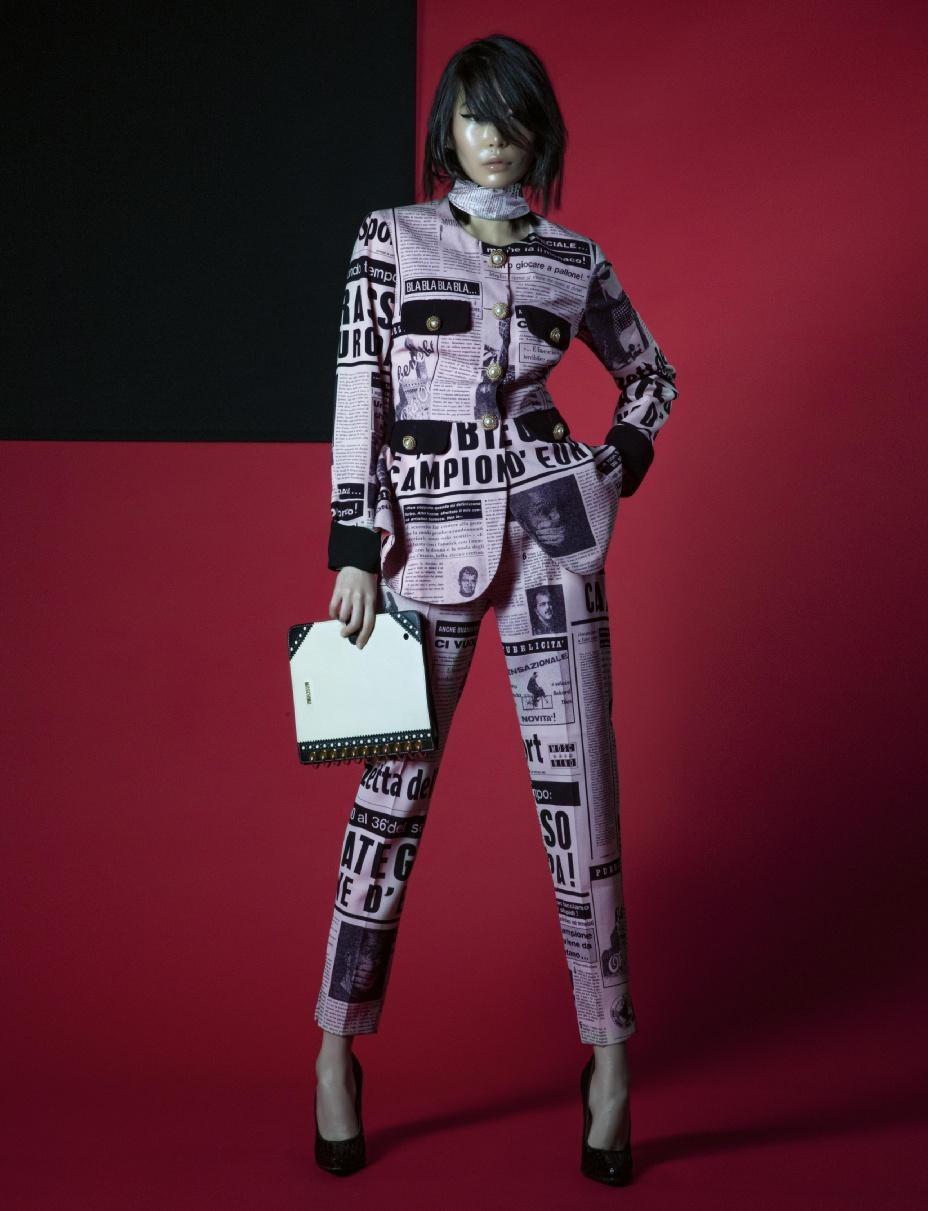
Total look MOSCHINO

Total look YVES SAINT LAURENT
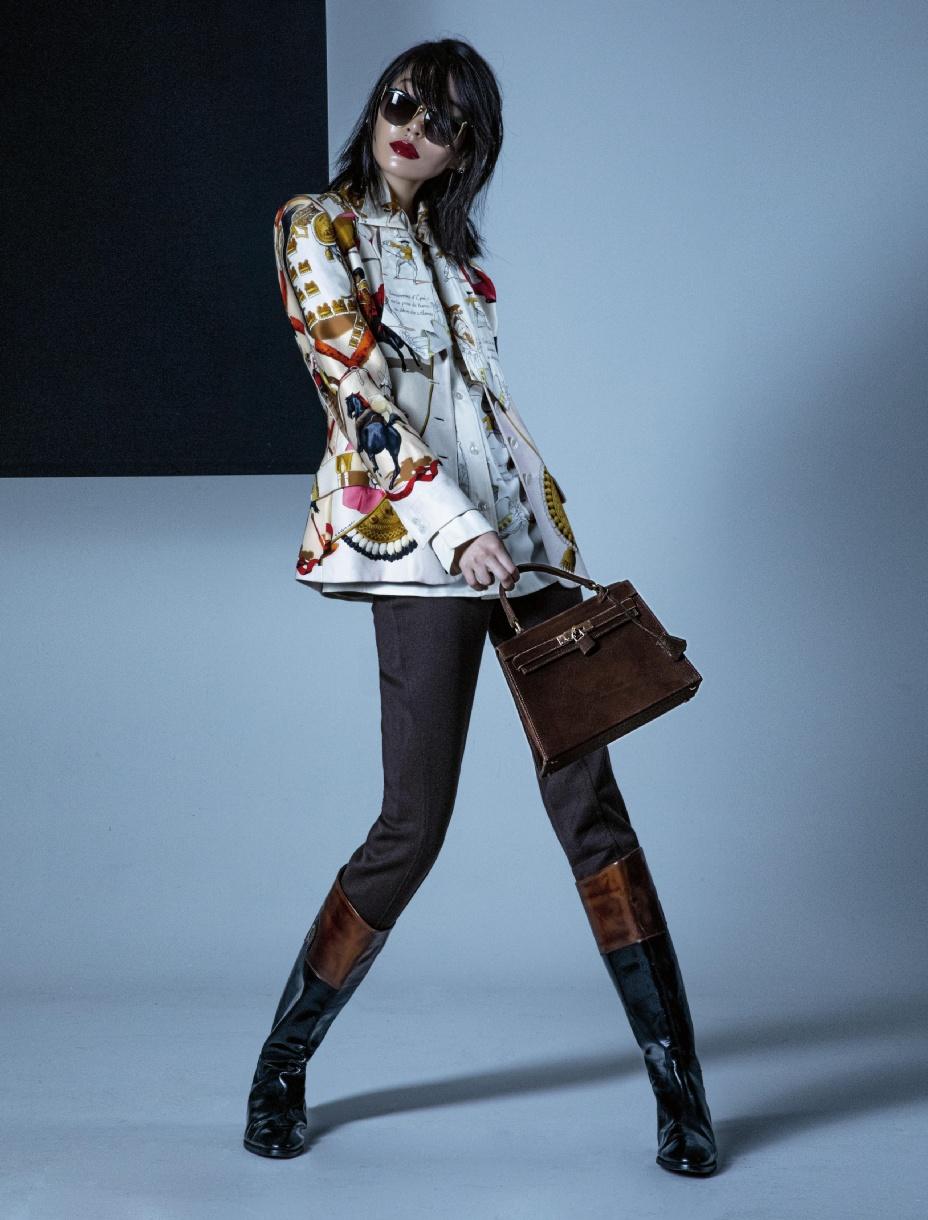
Total look HERMES


Total look CHANEL Shoes VERSACE

Total look DOLCE & GABBANA Shoes MIU MIU

Total look MAISON MARTIN MARGIELA

Total look JEAN PAUL GAULTIER
 Total look ISSEY MIYAKE Shoes Y3
Photos by Angelo Lanza Fashion by Luca Termine Make-up: Alessia Damiata @MKS Milano Hair: Mirko Battipaglia @MKS Milano
Photo assistant: Yadier Castro Piedra
Styling assistants: Ilaria Gelormini and Verdiana Alberghini Models: Sibin and Sofiia Chuprikova @BraveModel MNG
Thanks to Enrico Luigi Sidoli, Giulia Bacchi and Riccardo Giordani @A.N.G.E.L.O.
Total look ISSEY MIYAKE Shoes Y3
Photos by Angelo Lanza Fashion by Luca Termine Make-up: Alessia Damiata @MKS Milano Hair: Mirko Battipaglia @MKS Milano
Photo assistant: Yadier Castro Piedra
Styling assistants: Ilaria Gelormini and Verdiana Alberghini Models: Sibin and Sofiia Chuprikova @BraveModel MNG
Thanks to Enrico Luigi Sidoli, Giulia Bacchi and Riccardo Giordani @A.N.G.E.L.O.
Dopo il successo dell’edizione ‘rotonda’ di MODTISSIMO, il 6 e 7 settembre scorsi, l’edizione 60+1, che si svolgerà il 15 e 16 febbraio 2023, ha aperto le iscrizioni e conta già più di quattro dozzine di aziende iscritte per l’ennesimo evento dove robustezza, flessibilità e innovazione saranno ancora una volta in evidenza, caratteristiche fondamentali del DNA del tessile portoghese. All’inizio di un anno particolarmente impegnativo, lo “spirito di unità” che l’organizzazio ne intende promuovere ha perfettamente senso.
Per questo Manuel Serrão, CEO di Associação Selectiva Moda, responsabile dell’organizzazione, fa appello proprio a questo “spirito di unità” nel settore, affinché “continuiamo tutti a percorrere la strada del successo”, in un quadro in cui le prospettive per il 2023 indicano nella lotta all’inflazione la via ideale per rilanciare affari, consumi e ordini.
Vale la pena ricordare che il successo della 60esima edizione si è concretizzato nei numeri: 4.854 buyer portoghesi e 485 internazionali sono passati per i cor ridoi del Padiglione 6 di Exponor. Numeri da record, che si sono tradotti molto positivamente nel flusso di ordini per le aziende presenti. MODTISSIMO 60 si è esteso su una superficie espositiva di 9.500 mq, ha riunito 240 espositori, tralasciandone diversi, e ha presentato 350 collezioni. “Dopo la nostra ultima edizione nel settembre 2022 in cui abbiamo celebrato la nostra 60a edizione con grande successo e molta attitudine, siamo pronti a continuare a contare su di voi per la prossima”, afferma Manuel Serrão. L’e dizione 2023 si terrà sempre presso l’Exponor di Porto (Portogallo), il 15 e 16 febbraio. La divisione in settori è la consueta: tessuti e accessori, abbigliamento uomo, donna e bambino e servizi. Per quanto riguarda la tipologia di stand, gli espositori possono optare per uno stand attrezzato o libero.
Following the success of the ‘round’ edition of MODTISSIMO on 6 and 7 Sep tember last, the 60+1 edition, which will take place on 15 and 16 February 2023, has opened registration and already has more than four dozen compa nies registered for yet another event where robustness, flexibility and innova tion will once again be in evidence, fundamental characteristics of the DNA of Portuguese textiles. At the start of a particularly busy year, the ‘spirit of unity’ that the organisation intends to promote makes perfect sense.

This is why Manuel Serrão, CEO of Associação Selectiva Moda, in charge of the organisation, appeals precisely to this “spirit of unity” in the sector, so that “we all continue on the road to success”, in a framework in which the outlook for 2023 points to the fight against inflation as the ideal way to revive business, consumption and orders.
It is worth remembering that the success of the 60th edition was reflected in the numbers: 4,854 Portuguese and 485 international buyers passed through the corridors of Exponor’s Hall 6. Record numbers, which translated very posi tively into the flow of orders for the companies present. MODTISSIMO 60 cov ered an exhibition area of 9,500 sm, brought together 240 exhibitors, leaving out several, and presented 350 collections.


“After our last edition in September 2022 where we celebrated our 60th edition with great success and a lot of attitude, we are ready to continue counting on you for the next one”, says Manuel Serrão. The 2023 edition will also be held at the Exponor in Porto (Portugal), on 15 and 16 February. The division into sectors is the usual: fabrics and accessories, men’s, women’s and children’s wear, and services. As far as the type of stand is concerned, exhibitors can opt for an equipped or free stand.
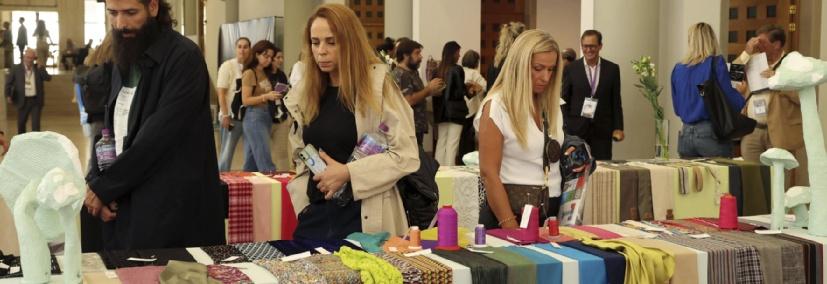 modtissimo.com
modtissimo.com

Coat and trousers BCBGMAXAZRIA Bag AMATO DANIELE Spot set GCDS for Wolford
Jump
the
No
The
the
fashion 39 F/W 2023
Welcome to Mudd Club
into
light Metaverso Mistaken shots
face
guardians of
moon
Welcome to Mudd Club
 Drawing by Joe Colosimo Photos by Angelo Lanza Fashion by Luca Termine
Drawing by Joe Colosimo Photos by Angelo Lanza Fashion by Luca Termine
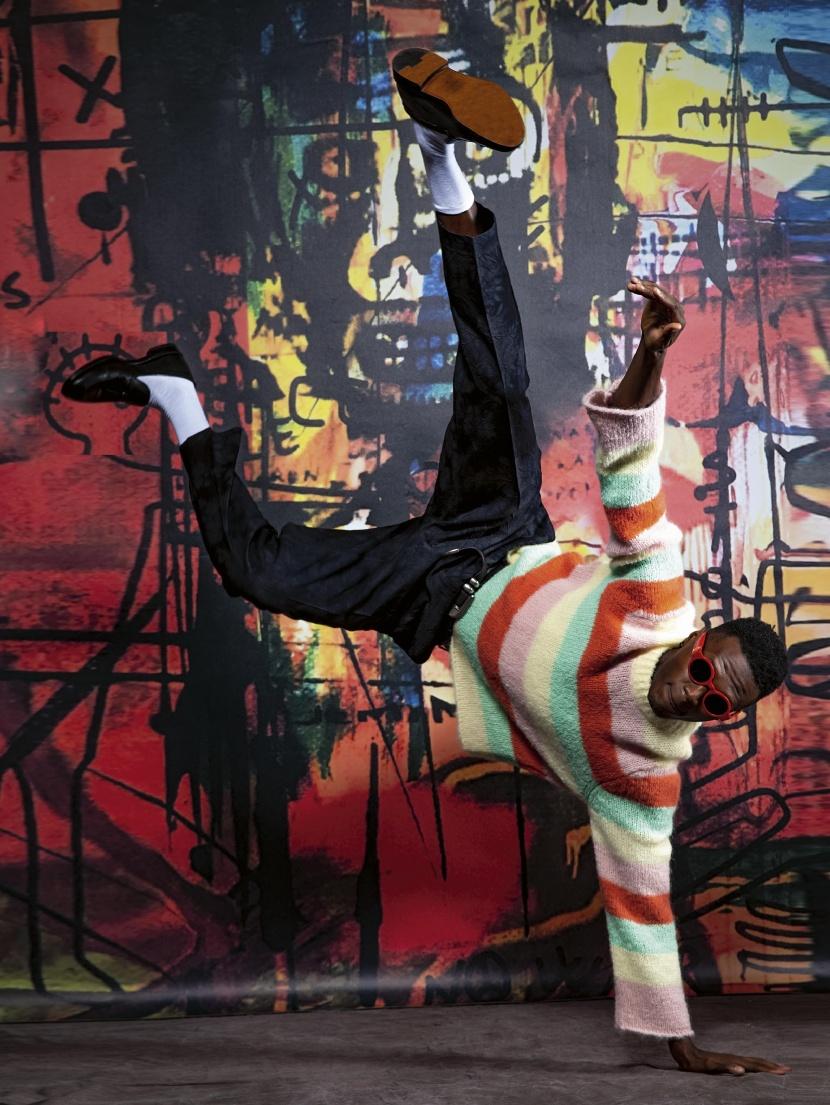 Jumper ATTIC AND BARN
Trousers PT TORINO Belt GAVAZZENI Sunglasses RALPH LAUREN Shoes SCAROSSO
Jumper ATTIC AND BARN
Trousers PT TORINO Belt GAVAZZENI Sunglasses RALPH LAUREN Shoes SCAROSSO
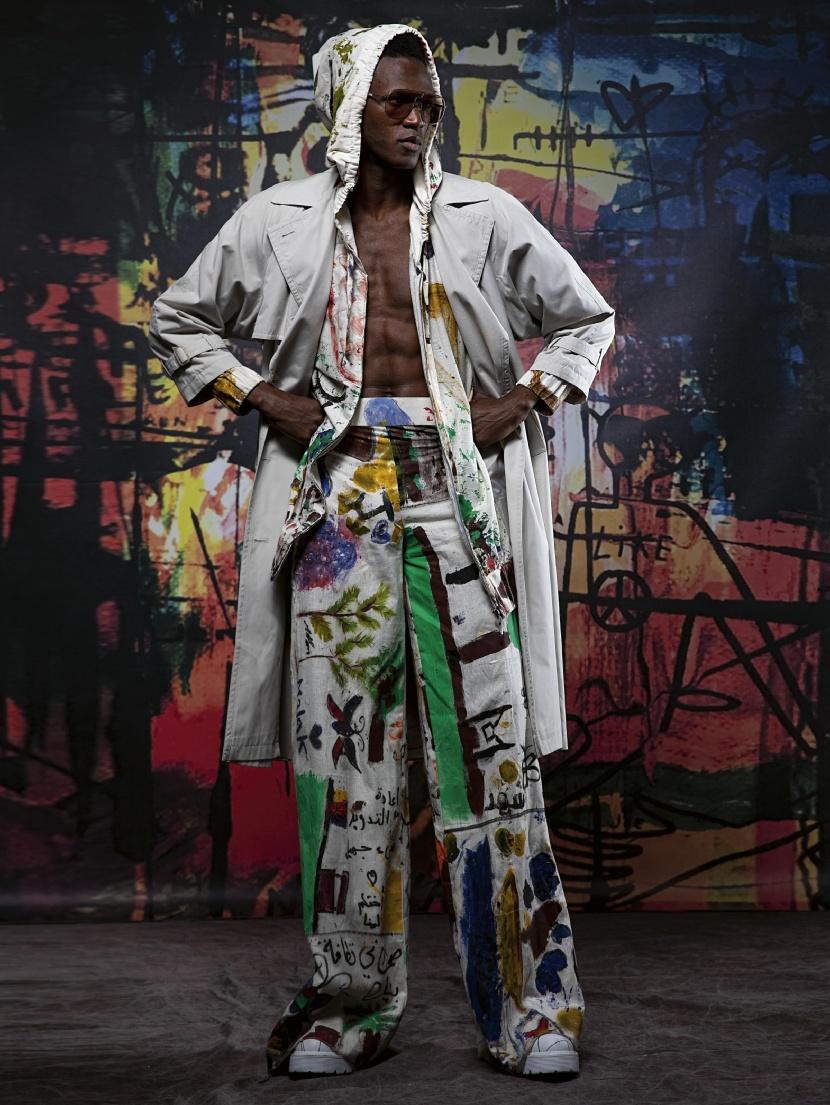 Trench VIENMNSUONNO 1926 Suit OTKUTYR for MyGeenKSA Sunglasses MIKYTA STUDIO Boots CULT
Trench VIENMNSUONNO 1926 Suit OTKUTYR for MyGeenKSA Sunglasses MIKYTA STUDIO Boots CULT
 Total BCBGMAXAZRIA Bag FIGUS DESIGNER Sunglasses MYKITA Boots MALONE SOULIERS
Total BCBGMAXAZRIA Bag FIGUS DESIGNER Sunglasses MYKITA Boots MALONE SOULIERS
Suit APNOEA Tourtleneck LAST POETS Necklace RADÀ Bag MICHELANGELO BROCCA

 Fur and trousers ATTIC AND BARN
Turtleneck CARLO PIGNATELLI
Shoes BIANCA SOUNDERS AT. Kollektive
Fur and trousers ATTIC AND BARN
Turtleneck CARLO PIGNATELLI
Shoes BIANCA SOUNDERS AT. Kollektive
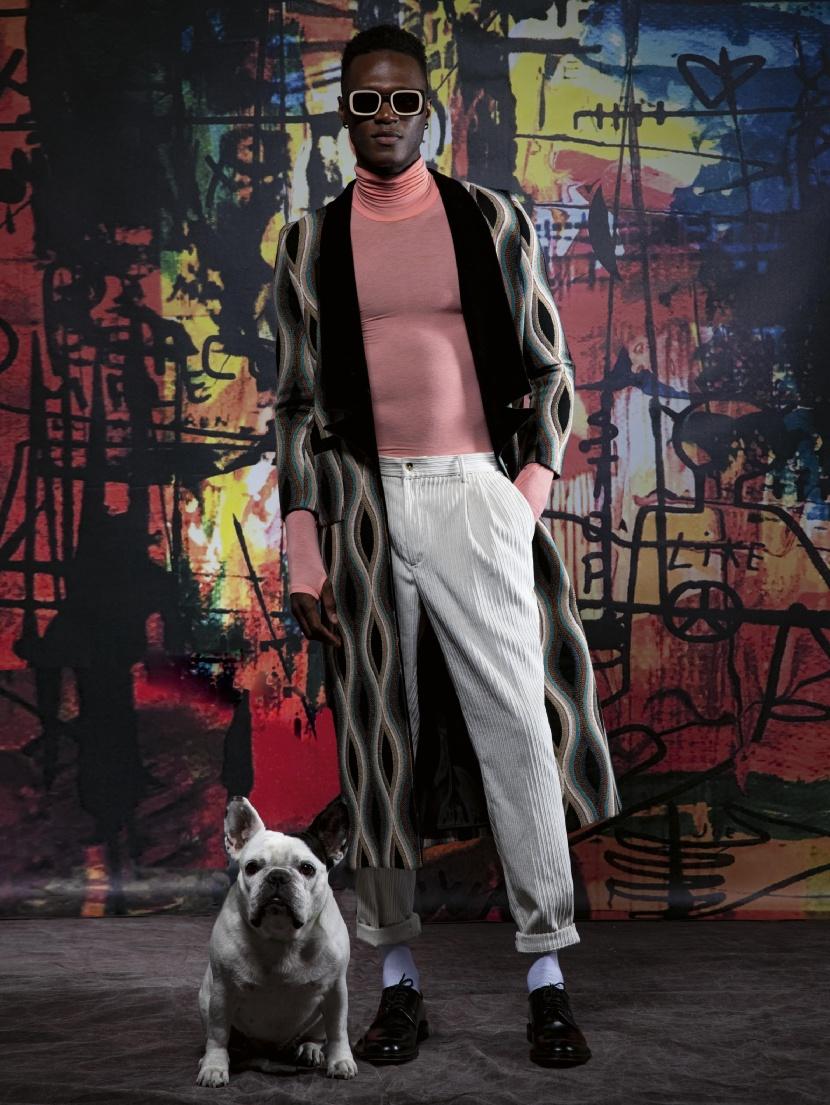 Coat BYAN
Turtleneck OTTO D’AME
Trousers GIAMPAOLO Sunglasses MYKITA STUDIO Shoes DOUCAL’S
Coat BYAN
Turtleneck OTTO D’AME
Trousers GIAMPAOLO Sunglasses MYKITA STUDIO Shoes DOUCAL’S

Coat HUI Suit SEVENTY Bag MICHELANGELO BROCCA Sunglasses BURBERRY Shoes MELISSA

Coat OTTOD’AME Bag GAVA Fur ecologic GILBERTO CALZOLARI Tailleur TAGLIATORE 0205 Boots JEFFREY CAMPBELL
 Jumper PEOPLE OF SHIBUYA Sunglasses DOLCE & GABBANA
Jumper PEOPLE OF SHIBUYA Sunglasses DOLCE & GABBANA
 Cardigan FRED PERRY
Jumper MATEMA
Trousers TRAMAROSSA
Glasses POPS MILANO Shoes ROBINSON
Cardigan FRED PERRY
Jumper MATEMA
Trousers TRAMAROSSA
Glasses POPS MILANO Shoes ROBINSON
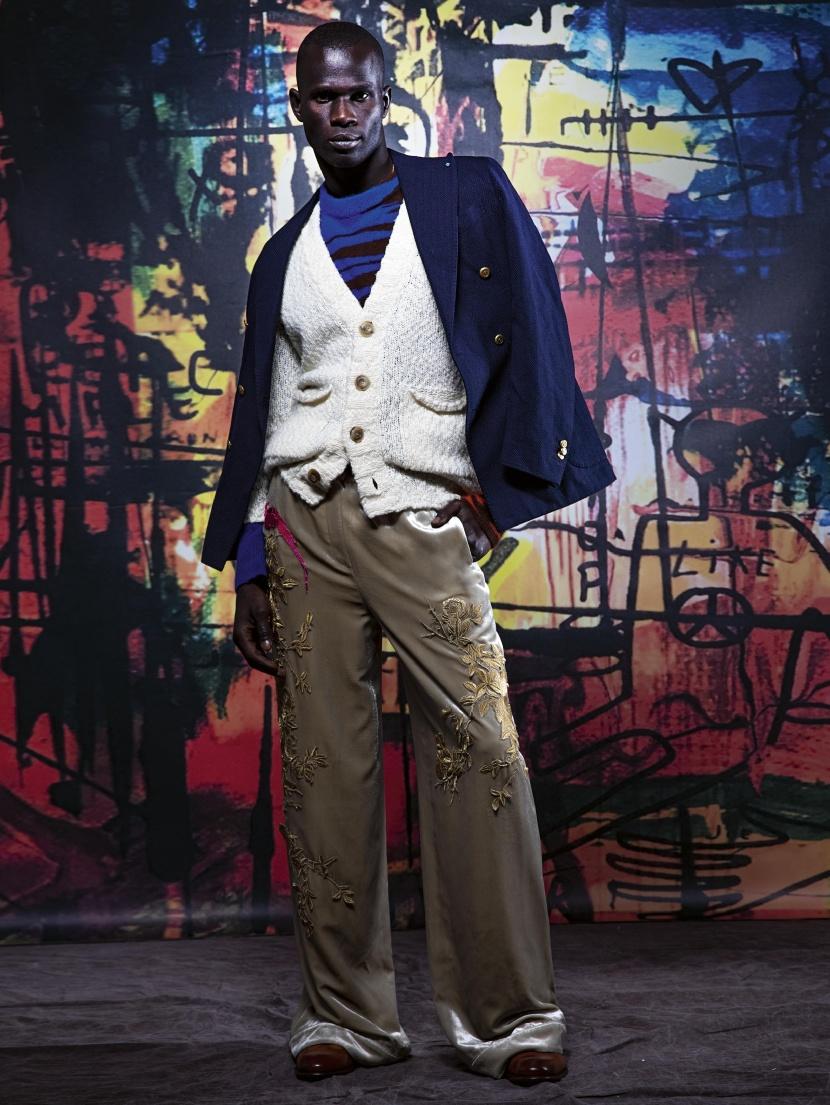 Jacket GIMPAOLO
Cardigan FILIPPO DE LAURENTIIS
Jumper PIACENZA CASHMERE
Trousers HUI
Shoes CUOIO DI TOSCANA
Jacket GIMPAOLO
Cardigan FILIPPO DE LAURENTIIS
Jumper PIACENZA CASHMERE
Trousers HUI
Shoes CUOIO DI TOSCANA
Total BCBGMAXAZRIA Bag FIGUS DESIGNER Sunglasses MYKITA
Drawing Basquiat inspiration: Joe Colosimo
 Photos by Angelo Lanza - Fashion by Luca Termine - Make-up: Imma Mennuti - Hair: Giorgia Prini @MKS Milano - Photo assistant: Yadier Castro Piedra Styling assistants: Evelyn Fogar, Giulia Ponti and Francesca Volpe - Models: Leo Correira and Talla Dieng @ILove Models MNG and Anna Virag Seck @BraveModels MNG
Photos by Angelo Lanza - Fashion by Luca Termine - Make-up: Imma Mennuti - Hair: Giorgia Prini @MKS Milano - Photo assistant: Yadier Castro Piedra Styling assistants: Evelyn Fogar, Giulia Ponti and Francesca Volpe - Models: Leo Correira and Talla Dieng @ILove Models MNG and Anna Virag Seck @BraveModels MNG
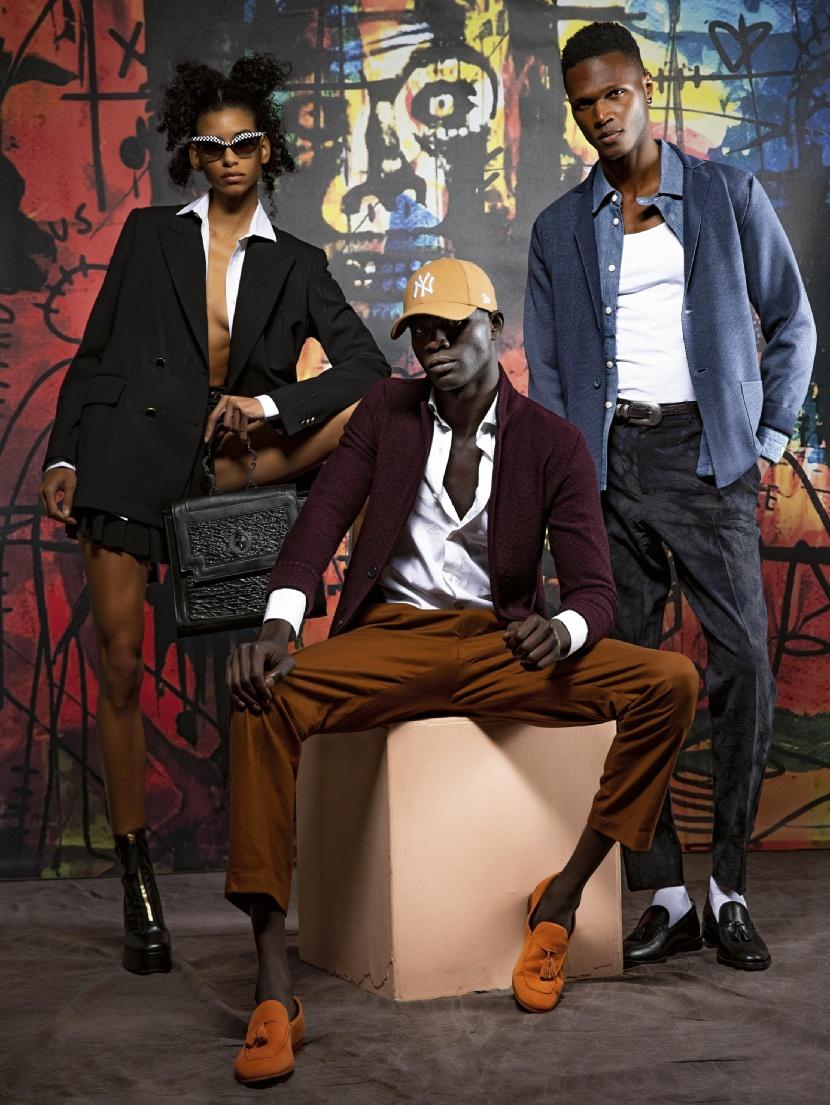
Left: Shirt ALESSANDRO GHERARDI Suit Jacket PT TORINO Skirt BURBERRY Bag MICHELANGELO BROCCA Sunglasses ALAIN MIKLI Boots LORIBLU Middle: Suit racket and shirt ETRO Trousers BERWICH Cap NEW ERA NY Shoes MELVIN AND HAMILTON Right: Underwear INTIMISSIMI Jacket FLY 3 Shirt TELA GENOVA Trousers PT TORINO Belt GAVAZZENI Shoes FRATELLI ROSSETTI
Jump into the light
Drawings by Silvia Caimi Performed by Stefano Frigeni Photos by Angelo Lanza Fashion by Luca Termine
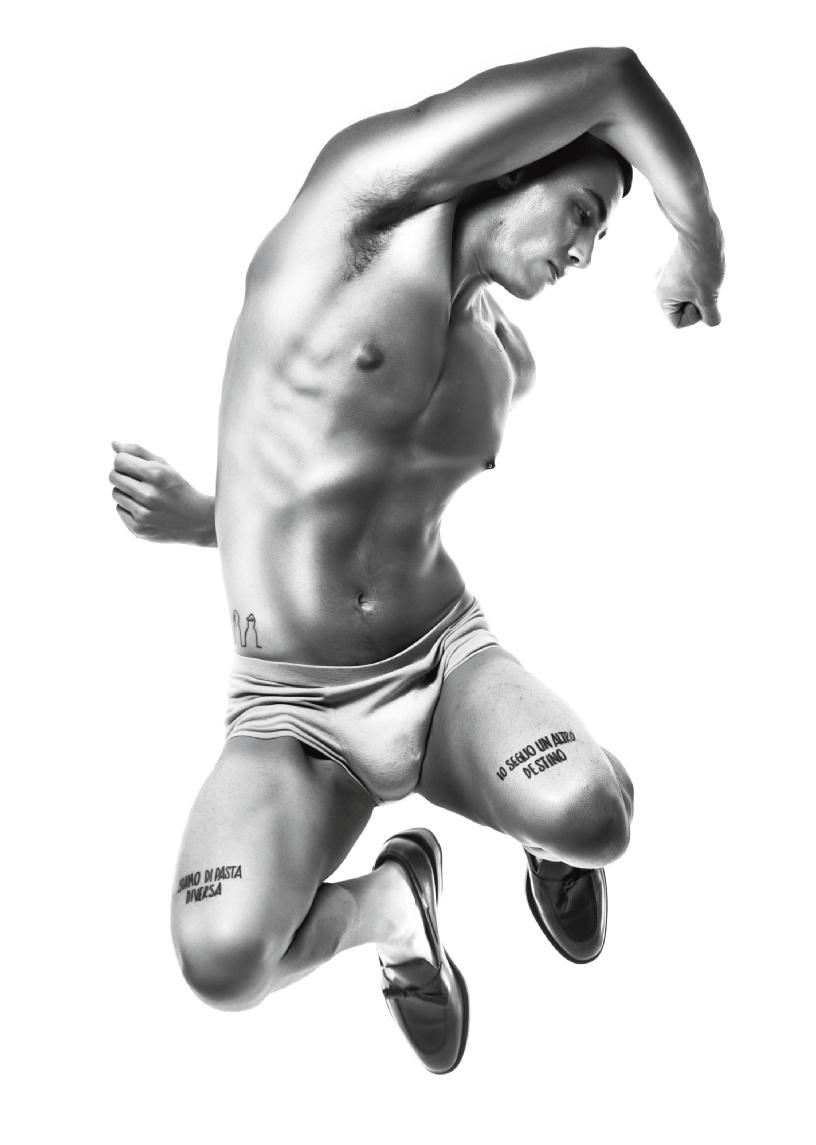
Shoes SCAROSSO Underwear INTIMISSIMI

JUMP 73, oil on canvas, 70x100 cm. (2018)

JUMP 82, oil on canvas, 80x120 cm. (2019)
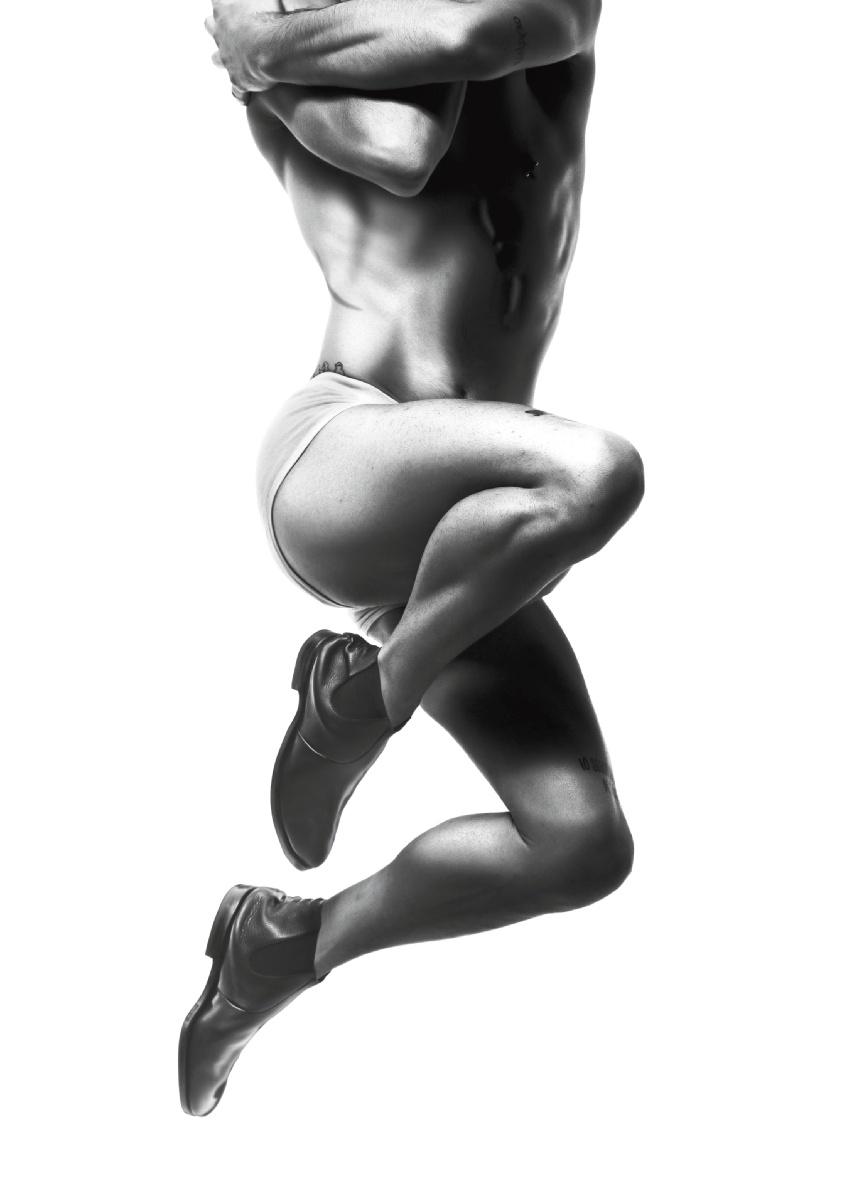
Shoes OFFICINE CREATIVE Underwear WOMO
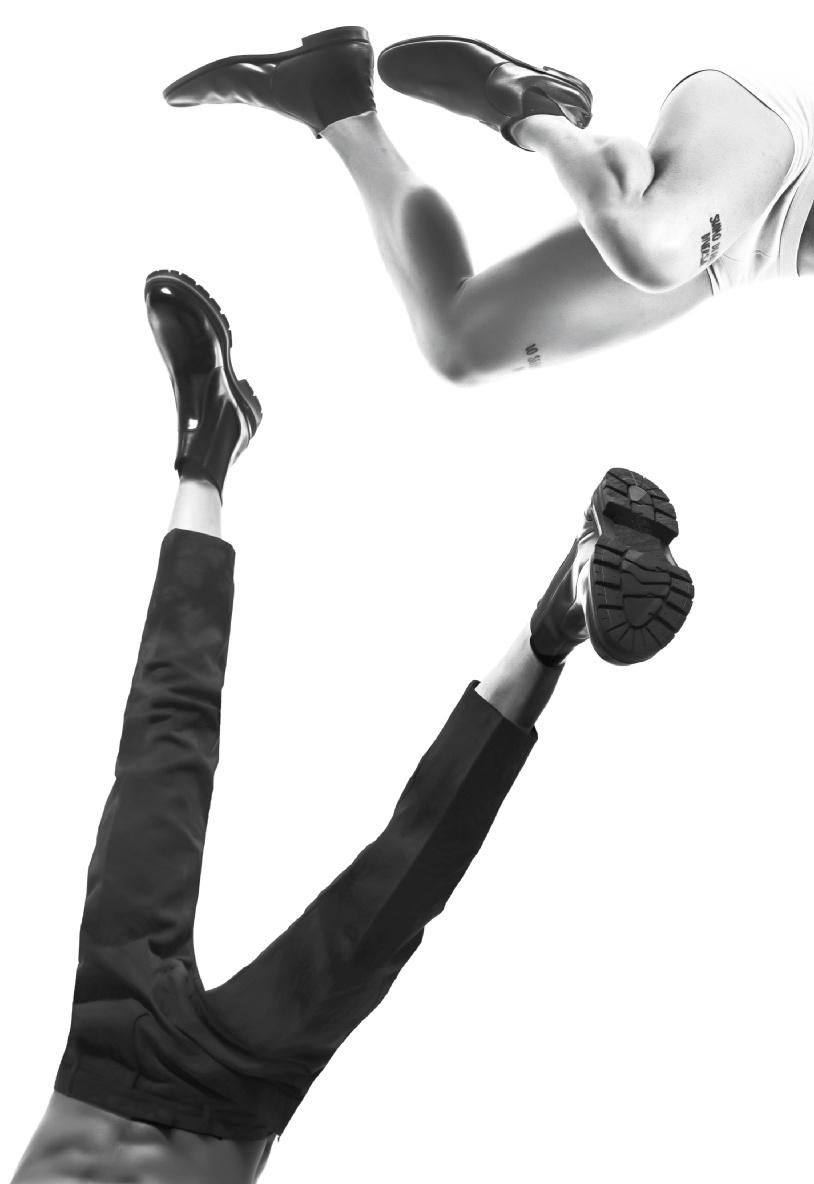 Boots DEICHMANN
Trousers PT TORINO
Up shoes OFFICINE CREATIVE Undewear INTIMISSIMI
Boots DEICHMANN
Trousers PT TORINO
Up shoes OFFICINE CREATIVE Undewear INTIMISSIMI

JUMP 108, oil on canvas, 50x70 cm. (2021)

JUMP 115, oil on canvas, 70x70 cm. (2022)

Shoes DOUCAL’S
TRAMAROSSA
Denim
Boots TAGLIATORE
Trousers TOM REBL
Drawings by Silvia Caimi
Performed by Stefano Frigeni
Photos by Angelo Lanza
Fashion by Luca Termine
Make-up: Alessia Damiata @MKS Milano
Hair: Mirko Battipaglia @MKS Milano
Photo assistant: Yadier Castro Piedra
Styling assistants: Ilaria Gelormini and Verdiana Alberghini


JUMP 114, oil on canvas, 70x100 cm. (2022)
64
Silvia Caimi
Elevating after the fall
L’arte, sia negli studi che nelle mani, come talento na turale, ha sempre avuto uno spazio importate nell’esi stenza di Silvia Caimi. “Ogni forma più pura di eleva zione nasce dalla caduta, dal buio, dalla perdita di se stessi. L’arte, nella mia vita, ha preso il sopravvento in un momento di prova, è letteralmente esplosa nella mia esistenza senza più darmi tregua”. Plotino, filosofo antico tra i più affascinanti, ispira la pittura dell’arti sta. Diceva: “Tutte le cose sono piene di segni, ed è un uomo sag gio chi riesce a imparare una cosa da un’altra.” Silvia Caimi ritiene molto naturale spingersi oltre se stessi. Oltre ogni apparenza reale. “Ciò che sembra complesso e articolato – dice – genera in me il fascino della semplicità, sostanzia la sfida della prova e la bellezza della scoperta continua”. Disegnare è rivelazione della figurazione, responsabilità e talento. Per lei il disegno è presupposto irrinun ciabile e necessario all’arte. Il disegno definisce la composizione, identifica e chiarisce la soggettazione, attribuendo precise forme all’idea. Cosa pensa della moda? Ritiene che il linguaggio della moda e dell’arte non siano differenti: “Ammiro chi ha saputo porta re nella moda la propria anima con un messaggio coerente, ma in costante evoluzione. Ammiro chi sa interpretare il tempo e ne for gia i limiti attraverso la propria espressione artistica: della moda mi piacciono fluidità e innovazione, ma ne apprezzo anche la solidità e la fedeltà al proprio sentimento artistico. Sento particolare affinità con le creazioni di Giorgio Armani. Amo le sue forme senza tempo, essenziali, comode e intriganti che ne interpretano immediatamen te sensibilità e gusto, addentrandosi sempre nell’anima dell’artista. Come i miei Jump insomma”. Dopo le due importanti personali del 2022 al Museo di Arte Contemporanea di Imperia e alla Galle ria Consorti in Via Margutta a Roma, Silvia Caimi si concentra ora nella realizzazione di nuove grandi tele che saranno esposte nella prima delle prossime mostre, a maggio 2023 in una prestigiosa sede istituzionale lombarda che ospita preziose architetture dipinte del Correggio.
Art, both in her studies and in her hands, as a natural talent, has always had an important space in Silvia Caimi’s existence. “Every purest form of elevation comes from the fall, from darkness, from the loss of self. Art, in my life, took over in a moment of trial, literally exploded in my existence without giving me any more respite.” Plotinus, one of the most fascinating ancient philosophers, inspi res the artist’s painting. He said, “All things are full of signs, and he is a wise man who can learn one thing from another.” Silvia Caimi considers it very natural to push beyond oneself. Beyond all real appearances. “What seems complex and articulate,” she says, “generates in me the fascination of simplicity, substantiates the challenge of trial and the beauty of continuous discovery”. Drawing is revelation of figuration, responsibility and talent. For her, drawing is an indispensable and necessary prerequisite to art. Dra wing defines the composition, identifies and clarifies the subjectifi cation, attributing precise forms to the idea. What does she think about fashion? She believes that the language of fashion and art are not different: “I admire those who have been able to bring their soul into fashion with a coherent, yet constantly evolving message. I admire those who know how to interpret time and forge its limits through their artistic expression: of fashion I like fluidity and innovation, but I also appreciate its solidity and fidelity to one’s artistic feeling. I feel particular affinity with Giorgio Armani’s creations. I love his timeless, essential, comfortable and intriguing shapes that immediately interpret his sensibility and taste, always delving into the soul of the artist. Like my Jumps.”
After her two important solo shows in 2022 at the Museum of Con temporary Art in Imperia and at the Consorti Gallery on Via Margut ta in Rome, Silvia Caimi is now concentrating on creating new large canvases that will be exhibited in the first of her upcoming shows, in May 2023 in a prestigious Lombard institutional venue that hou ses precious painted architecture by Correggio.
64 ART
JUMP 113, oil on canvas, 70x70 cm. (2022) silvia.caimi_painter
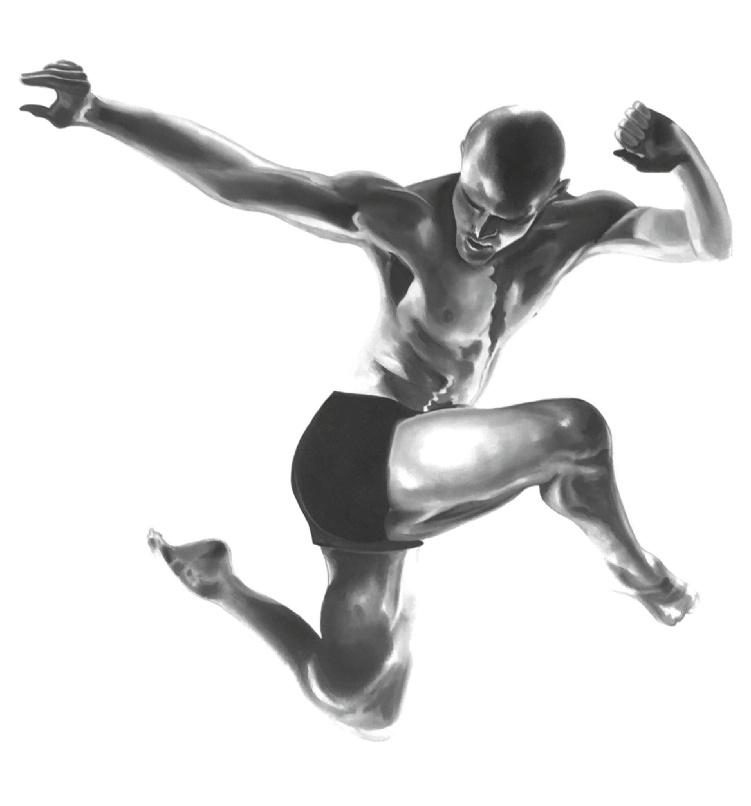
65 ART
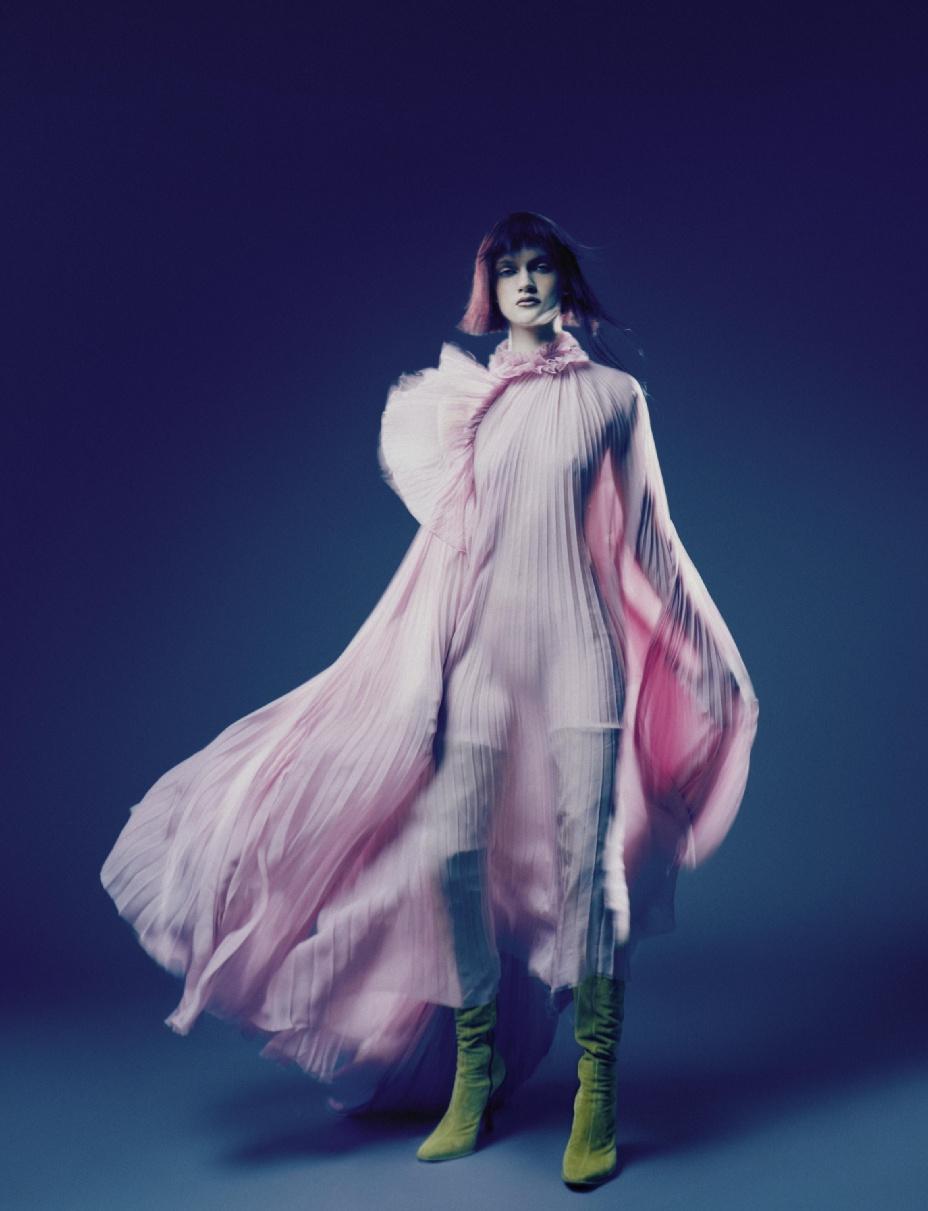
Dress LM AGNESE Boots GENNY
Metaverso
 Photos by Bohdan Bohdanov Fashion by Dinalva Barros
Top LM AGNES Trousers ANGELOS FRENTZOS Bag FENDI
Photos by Bohdan Bohdanov Fashion by Dinalva Barros
Top LM AGNES Trousers ANGELOS FRENTZOS Bag FENDI
 Top and trousers LM AGNESE
Pochette KNEED
Top and trousers LM AGNESE
Pochette KNEED
 Skirt SIMON CRACKER
Top WEILI ZHENG Bag A. CLOUD
Skirt SIMON CRACKER
Top WEILI ZHENG Bag A. CLOUD
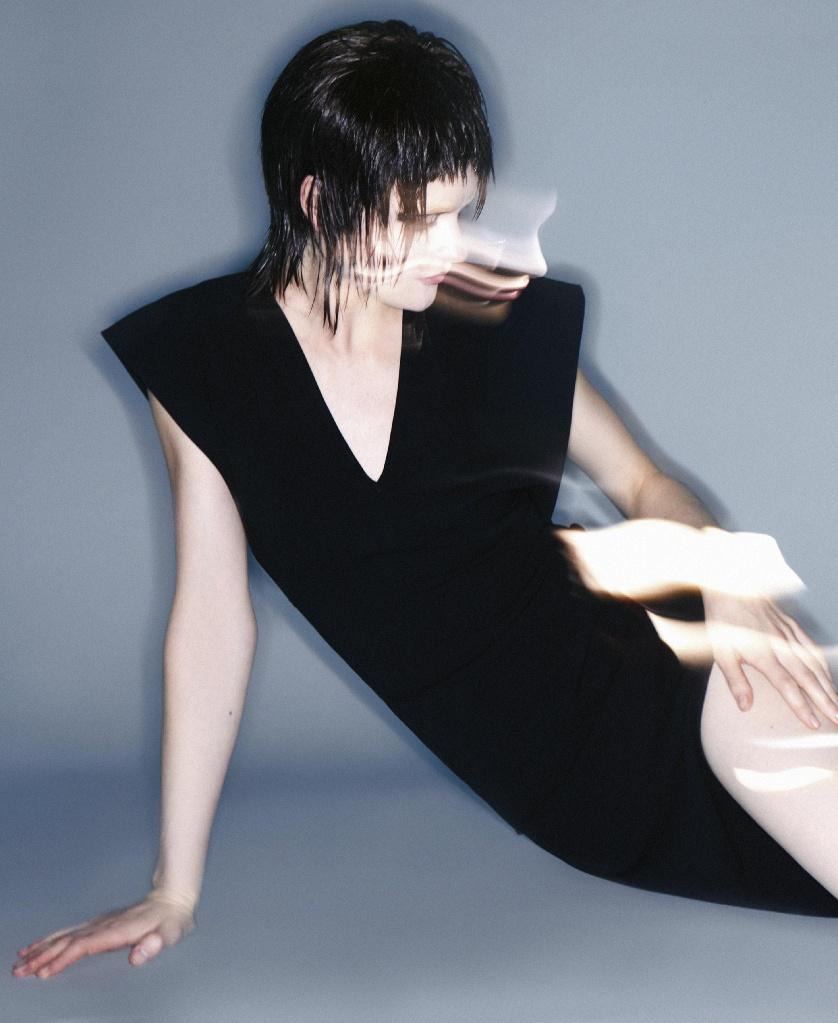
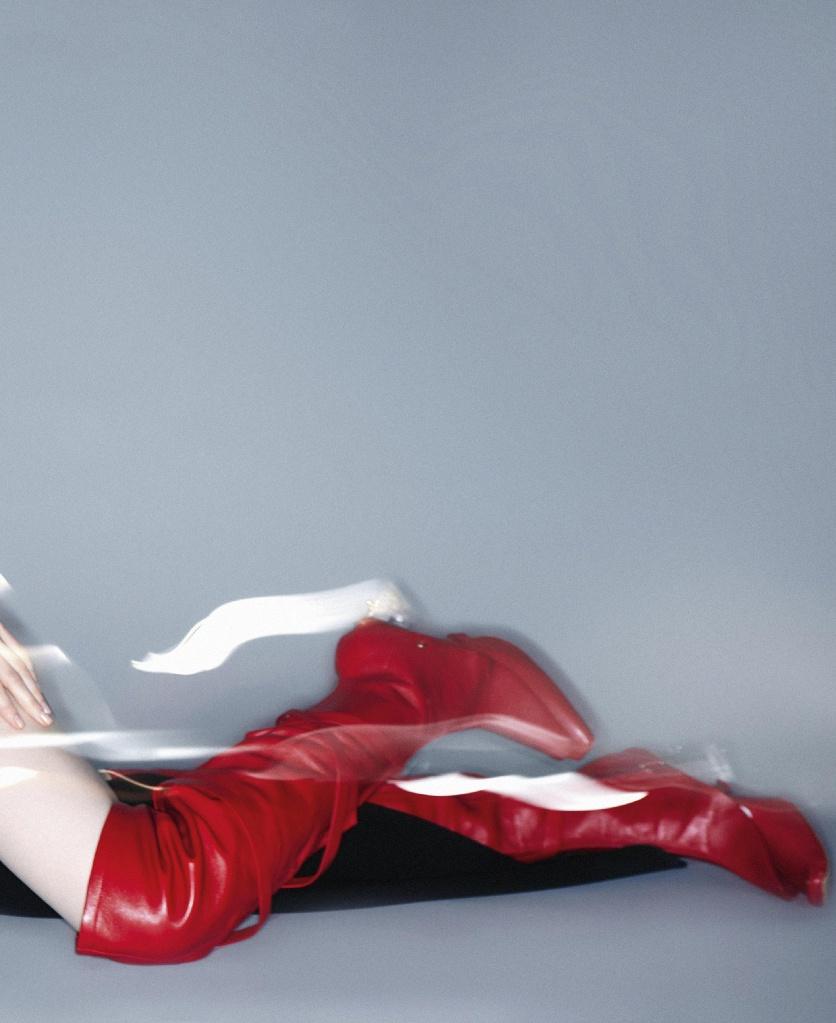 Dress ADEL BEL Boots SARA WONG
Dress ADEL BEL Boots SARA WONG
 Dress WEILI ZHENG Glasses FEDE CHETI Rings BONA CALVI
Dress WEILI ZHENG Glasses FEDE CHETI Rings BONA CALVI
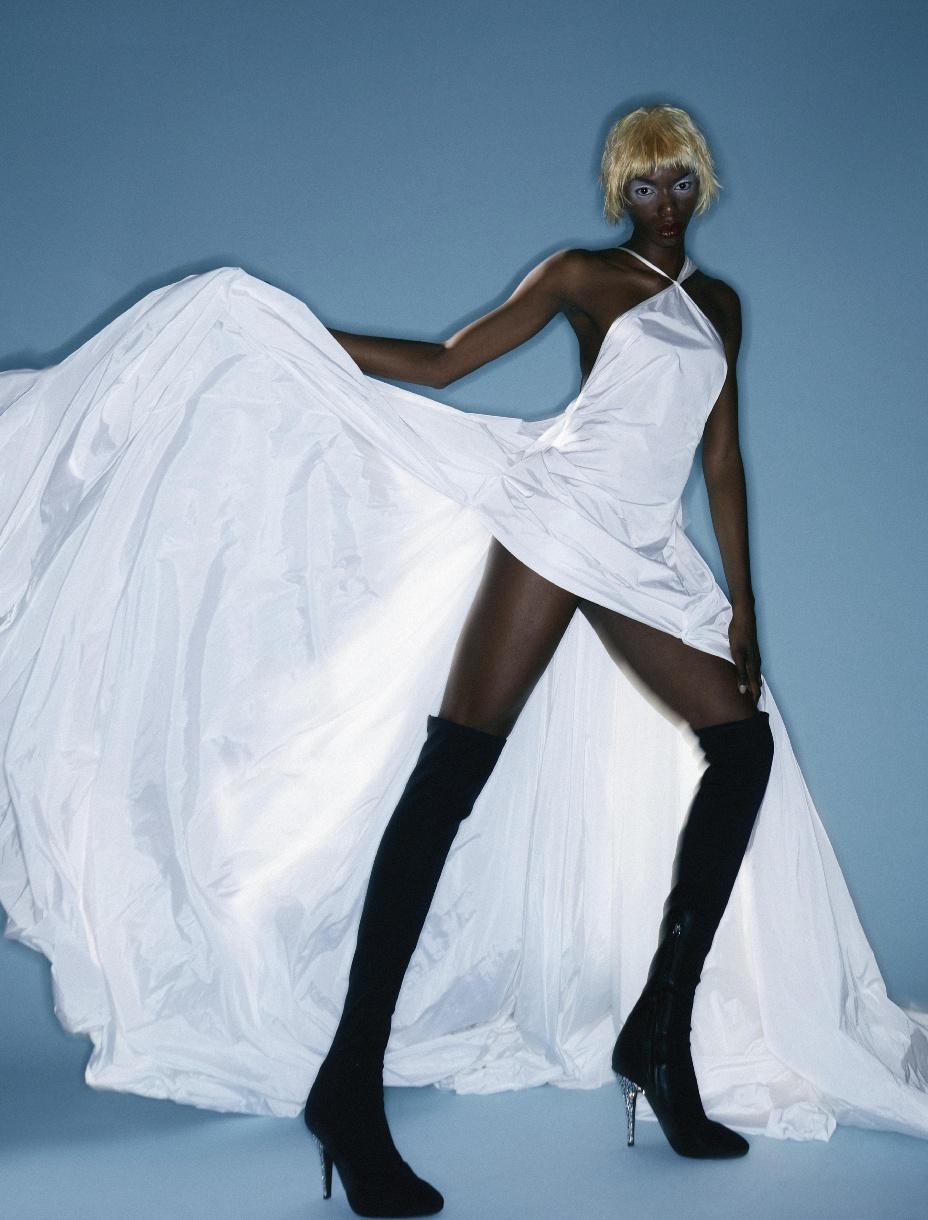
Dress ADEL BEL Boots GIUSEPPE ZANOTTI

Trousers
Bag
Top LM AGNES
ANGELOS FRENTZOS
FENDI
Make-up:
Hair:
Make-up
Hair
 Dress BARTOLOTTA E MARTORANA Bag JACQUEMUS
Photos by Bohdan Bohdanov Fashion by Dinalva Barros
Vanessa Udovicich
Anastasiia Tymoshchuk
Photo assistant: Kevin Yu Fashion assistants: Carlotta Laurenti and Giulia Tiraboschi
assistant: Camilla Negroni
assistant: Elizabeth Fogel
Models: Route @SophieModels and Mak K. @FashionModels MNG
Dress BARTOLOTTA E MARTORANA Bag JACQUEMUS
Photos by Bohdan Bohdanov Fashion by Dinalva Barros
Vanessa Udovicich
Anastasiia Tymoshchuk
Photo assistant: Kevin Yu Fashion assistants: Carlotta Laurenti and Giulia Tiraboschi
assistant: Camilla Negroni
assistant: Elizabeth Fogel
Models: Route @SophieModels and Mak K. @FashionModels MNG
Mistaken shots

Total look CHANEL
Photos by Daniela Rettore Styling by Federica Carnevali

Total look MAX MARA
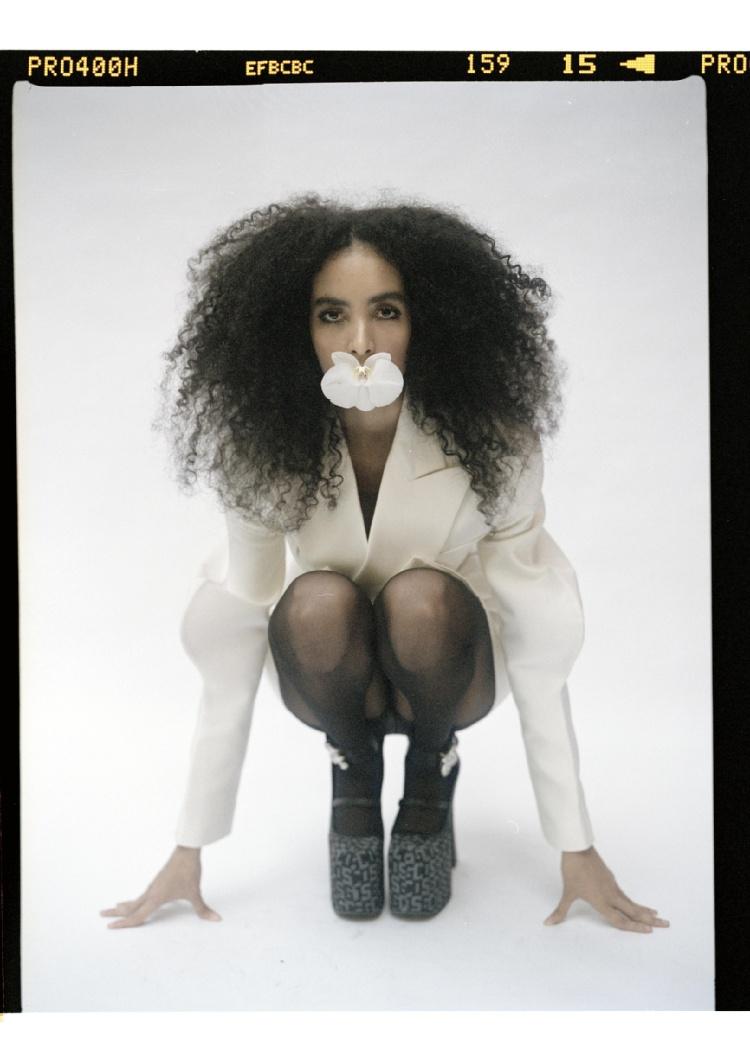
Jacket ANNAKIKI - Shoes GCDS

Total look TOD’S
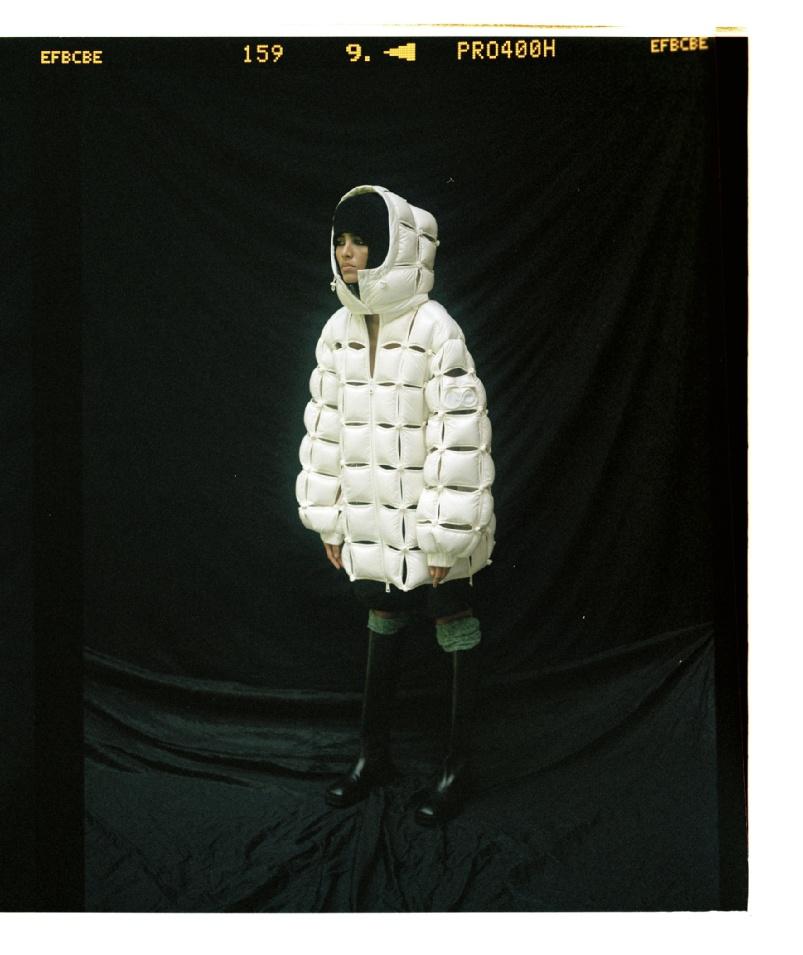
Jacket MONCLER - Boots MAX MARA
Total look GCDS
 Photos by Daniela Rettore - Styling by Federica Carnevali Make-up and hair: Agata Branchina - Retoucher: Katya Kachanouskaya Model: Eduarda Vieira @WomanMNG - Milan
Photos by Daniela Rettore - Styling by Federica Carnevali Make-up and hair: Agata Branchina - Retoucher: Katya Kachanouskaya Model: Eduarda Vieira @WomanMNG - Milan
No face
 Photos by Sara El Beshbichi
Styling by Martina De Carolis and Lucrezia De Vita
Photos by Sara El Beshbichi
Styling by Martina De Carolis and Lucrezia De Vita
 Left: Shirt BARTOLOTTA & MARTORANA Gloves VINTAGE Ring SWAROVSKI Pants FRACOMINA Bag NINA
Right: Coat ANIYE BY Bag VISONÀ Shoes BATA
Left: Shirt BARTOLOTTA & MARTORANA Gloves VINTAGE Ring SWAROVSKI Pants FRACOMINA Bag NINA
Right: Coat ANIYE BY Bag VISONÀ Shoes BATA
 Left: Dress and belt FLAVIA MARDI Gold leather jacket and Bootie MICHAEL KORS
Right: Sunglasses BALENCIAGA Blazer HUI
Left: Dress and belt FLAVIA MARDI Gold leather jacket and Bootie MICHAEL KORS
Right: Sunglasses BALENCIAGA Blazer HUI

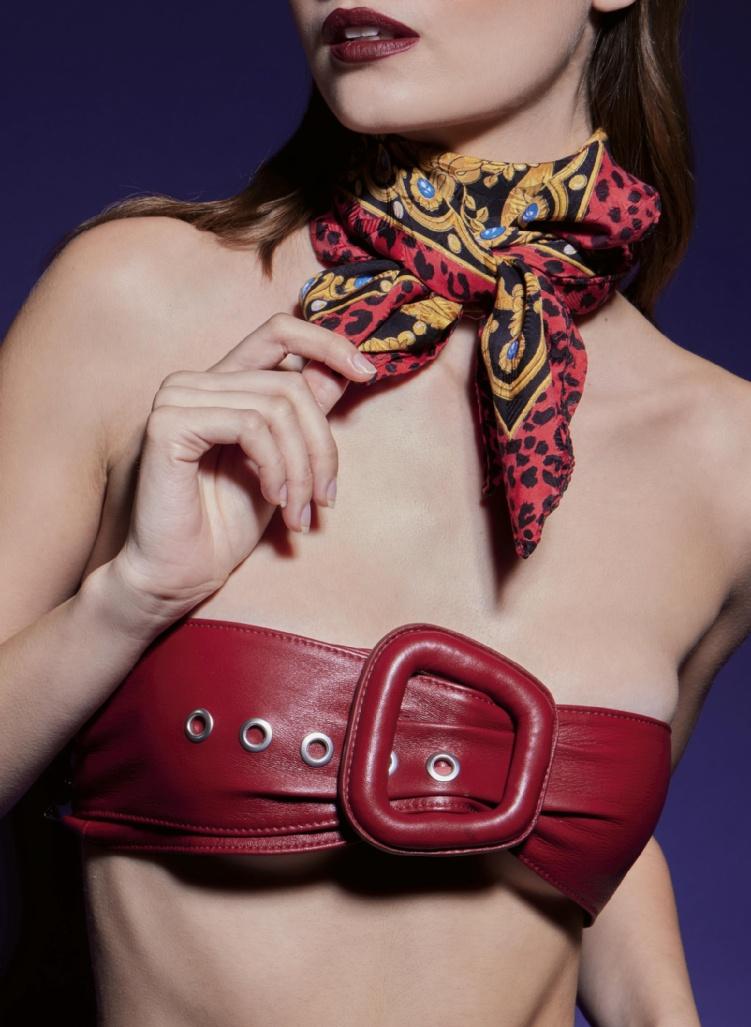
 Left: Foulard GIANNI VERSACE Belt GAVAZZENI
Right: Bag MICHELANGELO BROCCA Top VICOLO
Left: Foulard GIANNI VERSACE Belt GAVAZZENI
Right: Bag MICHELANGELO BROCCA Top VICOLO
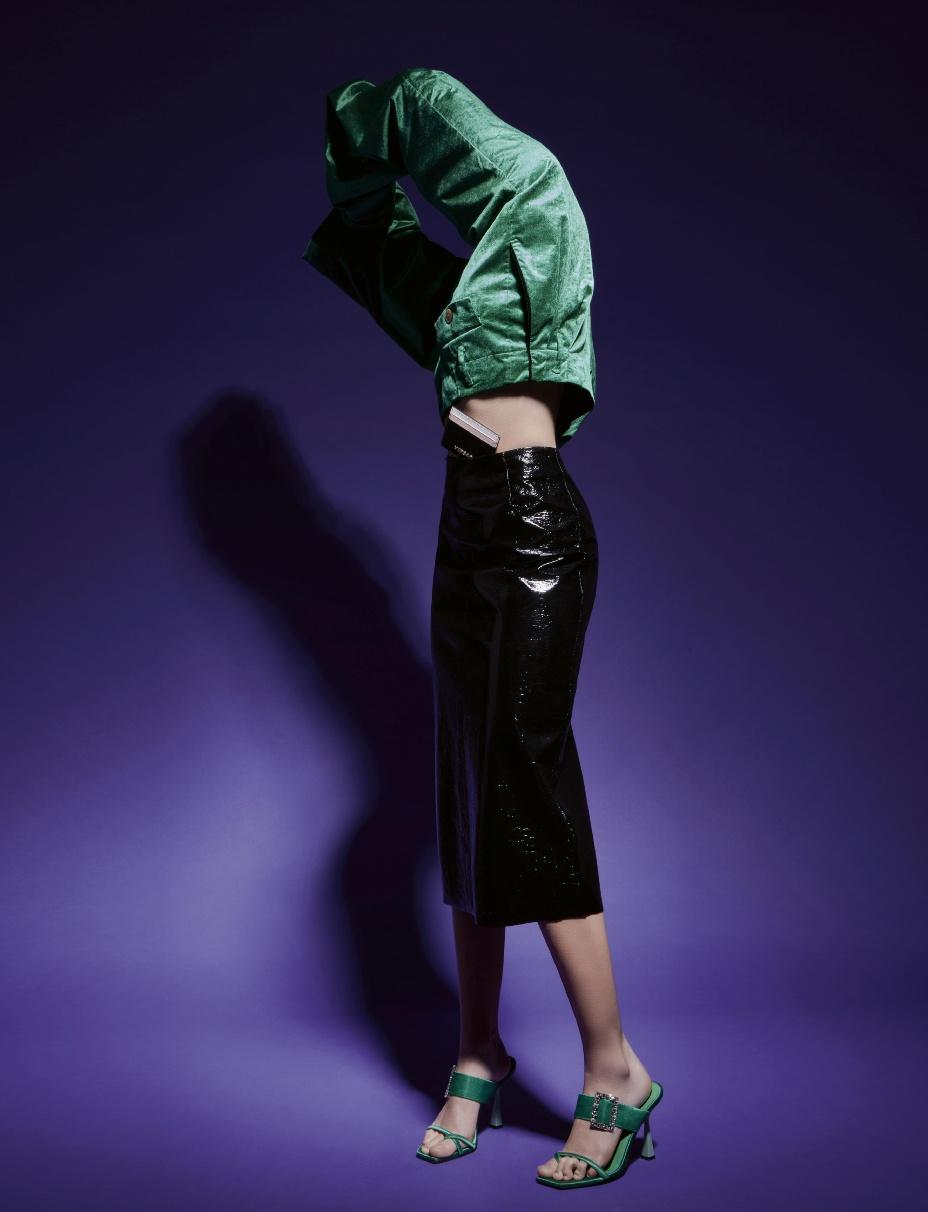 Left: Pants MOMONÌ Card holder VERSACE Skirt GILBERTO CALZOLARI Shoes MARIO VALENTINO
Right: Scarf MICHAEL KORS Pants WOMAN IN BERWICH
Left: Pants MOMONÌ Card holder VERSACE Skirt GILBERTO CALZOLARI Shoes MARIO VALENTINO
Right: Scarf MICHAEL KORS Pants WOMAN IN BERWICH
 Photos by Sara El Beshbichi Styling by Martina De Carolis and Lucrezia De Vita Make-up and hair: Americo Turtoro
Photos assistant: Alessio Giannetta Model: Cate Collins @TheWolvesModelManagement
Photos by Sara El Beshbichi Styling by Martina De Carolis and Lucrezia De Vita Make-up and hair: Americo Turtoro
Photos assistant: Alessio Giannetta Model: Cate Collins @TheWolvesModelManagement
The guardians of the moon
Sculpture hats by Fabius Tita
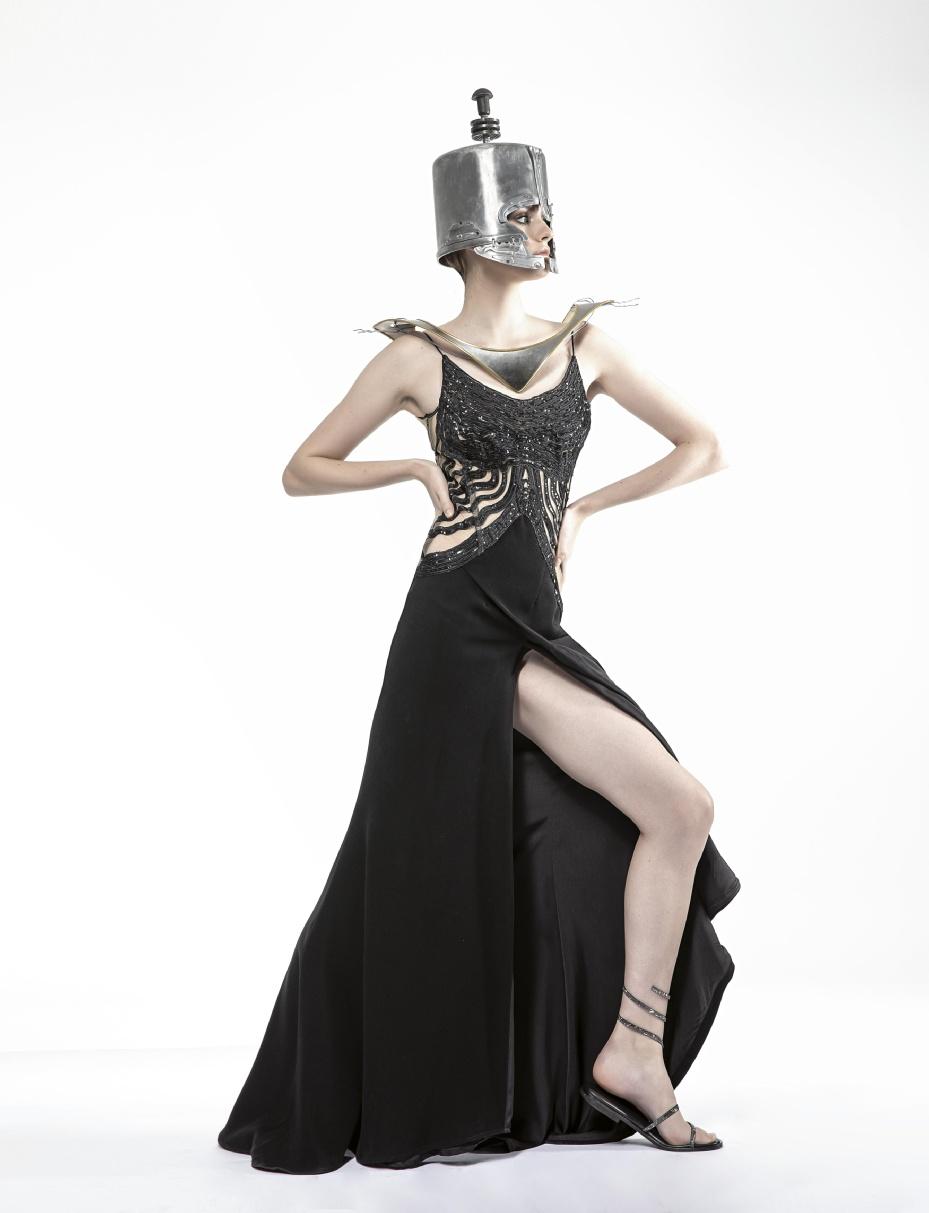 Photos by Angelo Lanza Fashion by Luca Termine
Dress AVARO FIGLIO Shoes CARYATIS
Photos by Angelo Lanza Fashion by Luca Termine
Dress AVARO FIGLIO Shoes CARYATIS
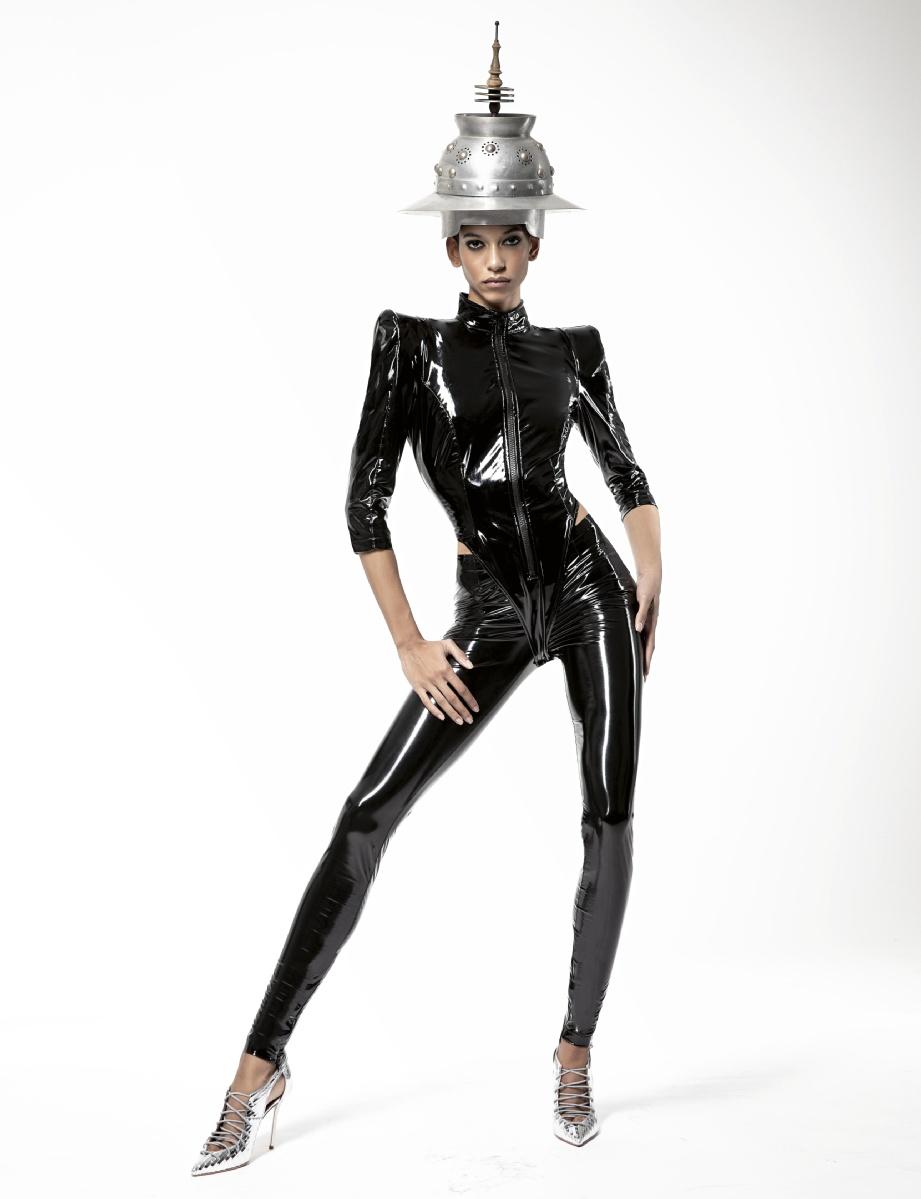
Total BABYLON Shoes MALONE SOULIERS

Jumpsuit HUI Shoes CULT

Dress BABYLON Shoes STEVE MADDEN

Dress FAINA Shoes CHIE MIHARA
Dress MURRII QUU COUTURE Shoes RENÈ CAOVILLA

Sculpture hats by Fabius Tita
Photos: Angelo Lanza
Fashion: Luca Termine
Make-up: Imma Mennuti
Hair: Giorgia Prini @MKS Milano
Photo assistant: Yadier Castro Piedra
Styling assistants: Evelyn Fogar, Giulia Ponti and Francesca Volpe
Models: Anna Virag Seck and Sia @BraveModels MNG
96
The Iron Hats Fabius Tita
Riccione, 1951: nasce Fabio Tita alias Fabius. Trasfe ritosi a Milano, vive il ‘68 con lo stesso desiderio di rinascita culturale della sua generazione e interrom pe gli studi umanistici per dedicarsi all’arte visiva. Nel 1975 trova casualmente dei “rottami significanti” e ne trae sculture antropomorfe e zoomorfe. Nasce una sua seconda natura artificiale, amica fedele di Fabius e della grande Anima collettiva (ROTTAMYSTICA).
Tita trasforma spazi abitativi con materiali di recupero di ogni gene re e la sua creatività genera case museo
Da queste case le sue creature hanno viaggiato in mostre personali e collettive, in gallerie, teatri, discoteche, cinema, ristoranti, aero porti. Dalla Biennale di Venezia alla Biennale di Montecarlo. Dall’E space Saint Exupery di Parigi allo spazio Etro Moda di Milano. Dal Museo d’Arte Contemporanea di Buenos Aires a diverse stazioni Metropolitane milanesi.
Tita ha anche fabbricato e ideato personaggi robotici per la televi sione e per il teatro.
“Vent’anni fa’ cominciai a mettere il cappello. Strano, al giorno d’oggi, indossare un cappello. Kean Etro, con cui collaboravo, mi disse che lo facevo per ‘proteggermi dall’alto’.
Da molto tempo sceglievo materiali di riciclo in metallo per le mie creazioni; perciò, era ovvio che sarebbe arrivata l’ispirazione a pen sare e creare dei cappelli in metallo. Tanto più che anche il mio spazio abitativo e lavorativo in Corso Garibaldi (Milano) si stava ri vestendo sempre più di metallo. Uscire da quel ‘bunker’ mi lascia va quasi indifeso così mi dissi che sarebbe stato utile proteggermi ulteriormente con un cappello-elmo. Ecco, così sono nati i miei cappelli di metallo. Oltre ad un’opera bella da tenere in casa, potrebbe essere anche utile a difendervi quando uscite nelle metropoli, ormai devastate da cinismo e violenza”.
Riccione, 1951: Fabio Tita alias Fabius was born. After moving to Milan, he experienced 1968 with the same desire for cultural rebirth as his generation and interrupted his humanistic studies to devote himself to visual art. In 1975, he accidentally found some ‘mea ningful scrap metal’ and made anthropomorphic and zoomorphic sculptures from it. His second artificial nature was born, a faithful friend of Fabius and the great collective Soul (ROTTAMYSTICA). Tita transforms living spaces with all kinds of recycled materials and his creativity generates museum houses.
From these houses his creatures have travelled to solo and group exhibitions, to galleries, theatres, discotheques, cinemas, restau rants and airports. From the Venice Biennale to the Monte Carlo Biennale. From the Espace Saint Exupery in Paris to the Etro Moda space in Milan. From the Museum of Contemporary Art in Buenos Aires to various Milanese underground stations.
Tita has also manufactured and designed robotic characters for television and theatre.
“Twenty years ago, I started wearing a hat. Strange, nowadays, to wear a hat. Kean Etro, with whom I collaborated, told me that I did it to ‘protect myself from above’.
For a long time, I had been choosing recycled metal materials for my creations; therefore, it was obvious that inspiration would come to think and create metal hats. Especially since my living and wor king space in Corso Garibaldi (Milan) was also becoming increa singly clad in metal. Stepping out of that ‘bunker’ left me almost defenceless so I told myself it would be useful to protect my head further with a helmet-hat.
Thus, my metal hats were born. Besides being a beautiful piece to keep in the house, it could also be useful to defend yourself when you go out in the metropolis, now ravaged by cynicism and violence’.
96 ART

97 ART fabiustita@gmail.com

free from the site NOW Consult AF MAGAZINE from your favorite device wherever you want, whenever you want Download here af-magazine.com CURRENT AND ARCHIVE ONLINE AVAILABLE

focus on RICK OWENS S/S 2023
Moncler Balenciaga Chanel Ferragamo Gucci Rick Owens Dior Saint Laurent Louis Vuitton

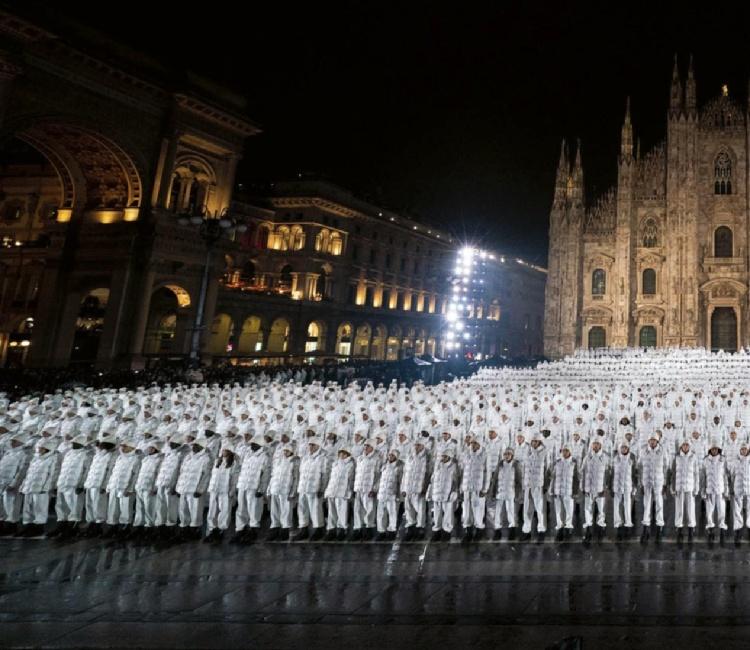

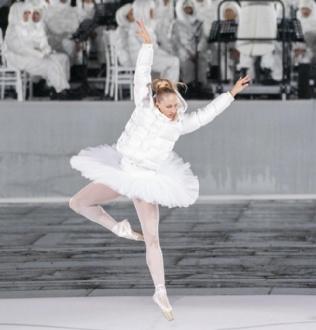
FOCUS ON 100 S/S 2023
Moncler



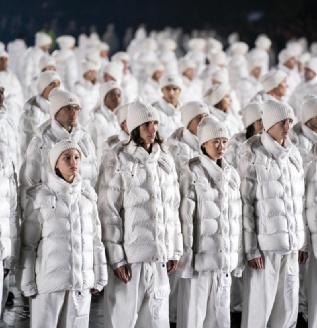
FOCUS ON 101 S/S 2023
Moncler
The magnificent 10 of SS23
by Luca Cioffi
Collezioni al quadrato, piazze gremite e mitologie pagane… sono solo alcuni segni distintivi di una stagione, che in un passo allungato tra Milano e Parigi, presenta un aggiornamento del lessico della moda, contaminato dal tempo. Resilienza e perseveranza sono forse le parole comuni a ogni evento di questa SS23: la prima presuppone determinazione, quella della moda a non farsi soverchiare dalle difficoltà; la seconda vede l’abito e il costume resistere impavidi ai temporanei scontri sociali. Sono pochi i brand capaci di risvegliare nel pubblico il senso di meraviglia, e questi pochi hanno la responsabilità di mostrare come la moda sappia ancora stupire. Dal nuovo Ferragamo, che sotto la direzione creativa di Maximilian Davis si sporge verso la Gen. Z tingendo di rosso e nero la sua prima collezione, fino ad arrivare alla “wearable art” dal tocco futurista di Louis Vuitton che inganna l’occhio del pubblico con abiti dalle dimensioni alterate, passando per gli show di Moncler e Dior, entrambi a segnare un anniversario: i 70 anni del brand italiano conosciuto per il calore dei noti bomber, e i 6 anni alla guida creativa della maison francese di Maria Grazia Chiuri, il cui show continua a insistere sul tema della liberazione femminile e sul binomio poterelibertà. L’abito diventa spazio di sperimentazione. Gucci e Balenciaga rimangono fedeli a se stessi, desiderosi ogni volta di sorprendere. Una collezione ‘sdoppiata’ dal nome Gucci Twinsburg ha portato in passerella 60 coppie di modelli gemelli, mentre Demna Gvsalia ha presentato una collezione apocalittica ambientata in uno scenario fangoso.
Entrambe ribadiscono l’indagine sociale su temi importanti come il rapporto realtà – finzione e copia - originale. E in una stagione tesa a riscoprire i codici artistici delle maison, Rick Owens ripropone una mitologia pagana fatta di corpi idealizzati, a tratti sovrumani, che si aprono alla molteplicità delle forme organiche di abiti e accessori. Si ricorre sempre all’iconografia d’archivio con Chanel che traspor ta gli spettatori sul grande schermo, precisamente nelle scene di “L’anno scorso a Marienbad” di Alain Resnais, reinterpretato con gli iconici completi in tweed che spaziano dal più maturo bianco e nero fino ad arrivare agli innocenti rosa e giallo, scrivendo un nuovo capitolo, questa volta più colorato, della biografia della fondatrice, amante della cinematografia d’autore. Sempre al cinema, solo più contemporaneo, attinge Saint Laurent con uno show che rende omaggio al look “attillato” di Grace Jones con abiti lunghi, giacche in pelle e l’iconico copricapo, anche per ricordare gli anni provocatori e sregolati a cui venne accostato, in passato, il nome della maison. Lo stesso accade nella SS23 di Balmain: un rave revival che ci riporta all’epoca di Cher. È proprio lei a chiudere uno show “polistrumentale”, che spazia dalla leggerezza di stampe floreali alla rigidità di mini abiti strutturati.
Sono questi i nomi che hanno rimodellato il planisfero della moda nell’ultima stagione, non più a forma di stivale o di Torre Eiffel, ma ad immagine di un abito che, grazie alla sua forma informe, collega ogni parte del mondo. Un messaggio condiviso che si realizza negli occhi sbarrati di un pubblico estasiato, il quale ricorderà questi show come avvenimenti storici.
102 FOCUS ON
102
Collections squared, packed plazas and pagan mythologies... the se are just some of the hallmarks of a season that, in an elongated stride between Milan and Paris, presents an update of the fashion lexicon, contaminated by time. Resilience and perseverance are perhaps the words common to every event of this SS23: the first presupposes determination, that of fashion not to be overwhelmed by difficulties; the second sees dress and habits fearlessly resisting temporary social clashes. There are few brands capable of awa kening a sense of wonder in the public, and these few have the responsibility of showing how fashion still knows how to amaze.
From the new Ferragamo, which under the creative direction of Maximilian Davis leans towards Gen. Z by dyeing its first collection in red and black, to Louis Vuitton’s wearable art with a futuristic touch that tricks the public’s eye with clothes of altered dimen sions, passing through the Moncler and Dior shows, both marking anniversaries: 70 years of the Italian brand known for the warmth of its famous bomber jackets, and the 6 years at the creative helm of the French maison of Maria Grazia Chiuri, whose show continues to insist on the theme of female liberation and the power-freedom binomial. The dress becomes a space for experimentation. Gucci and Balenciaga remain true to themselves, eager each time to surprise. A ‘doubled’ collection named Gucci Twinsburg brou ght 60 pairs of twin models to the catwalk, while Demna Gvsalia presented an apocalyptic collection set in a muddy scenario. Both reiterate the social investigation of important themes such as the relationship between reality - fiction and copy - original.
And in a season aimed at rediscovering the artistic codes of the maisons, Rick Owens re-proposes a pagan mythology made up of idealised bodies, at times superhuman, which open up to the multiplicity of organic forms of clothes and accessories.
Archival iconography is also used with Chanel transporting viewers to the silver screen, specifically to scenes from Alain Resnais’ Last Year at Marienbad, reinterpreted with the iconic tweed suits ran ging from the more mature black and white to the innocent pink and yellow, writing a new chapter, this time more colourful, in the biography of the founder, a lover of art-house cinema.
Saint Laurent also draws from cinema, only more contemporary, with a show that pays homage to the “tight” look of Grace Jones with long dresses, leather jackets and the iconic headgear, also to recall the provocative and unruly years to which the name of the maison was associated in the past.
The same happens in Balmain’s SS23: a revival rave that takes us back to the era of Cher. It is Cher herself who closes a ‘multiinstrumental’ show, ranging from the lightness of floral prints to the rigidity of structured mini-dresses.
These are the names that reshaped the fashion planisphere in the last season, no longer in the shape of a boot or the Eiffel Tower, but in the image of a dress that, thanks to its shapeless shape, connects every part of the world.
A shared message that is realised in the wide-eyed glance of an enraptured audience, who will remember these shows as historical events.
103 FOCUS ON





FOCUS ON 104 S/S 2023
Balenciaga

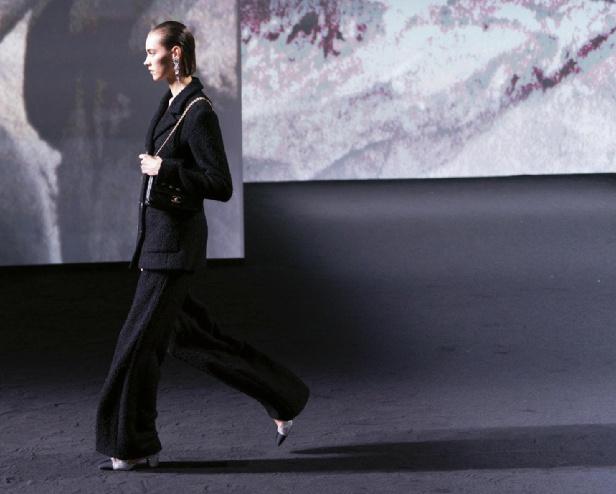

Chanel FOCUS ON 105 S/S 2023
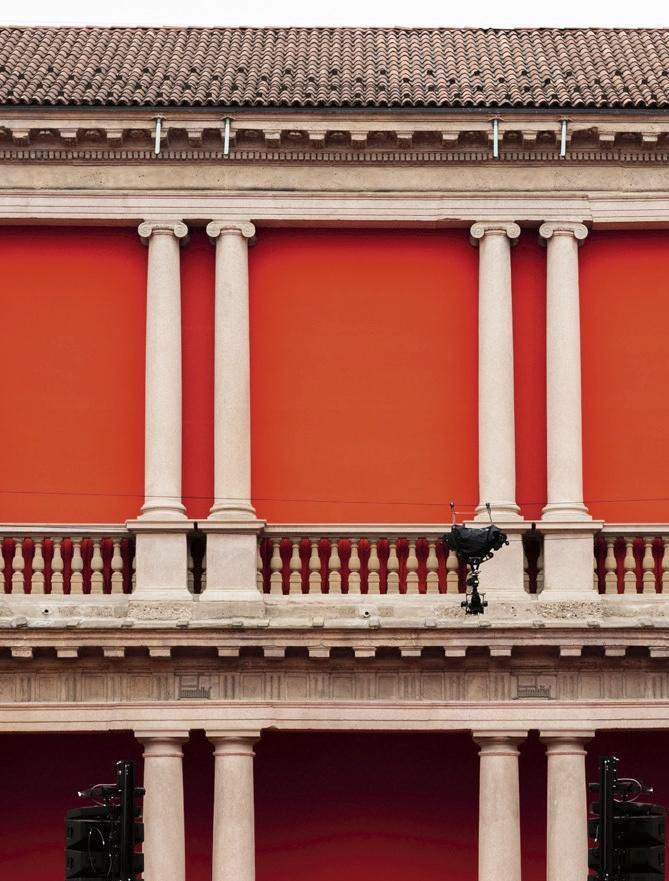
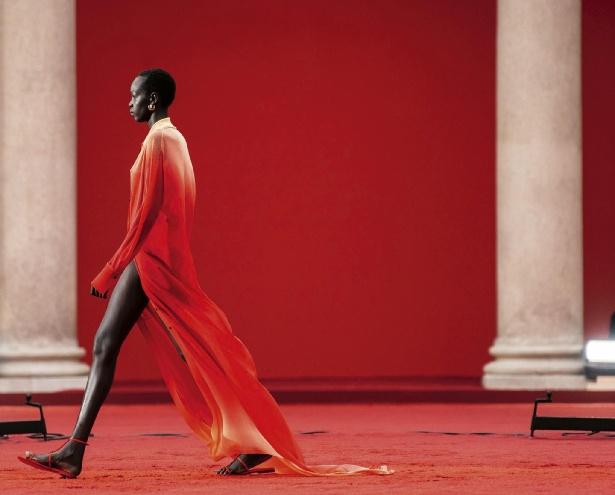

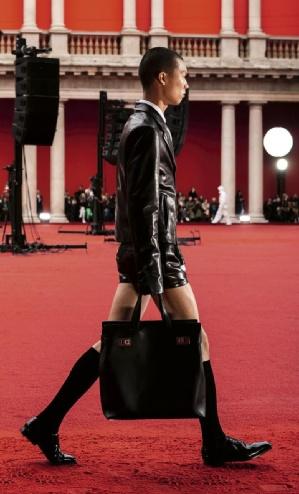
FOCUS ON 106 S/S 2023
Ferragamo
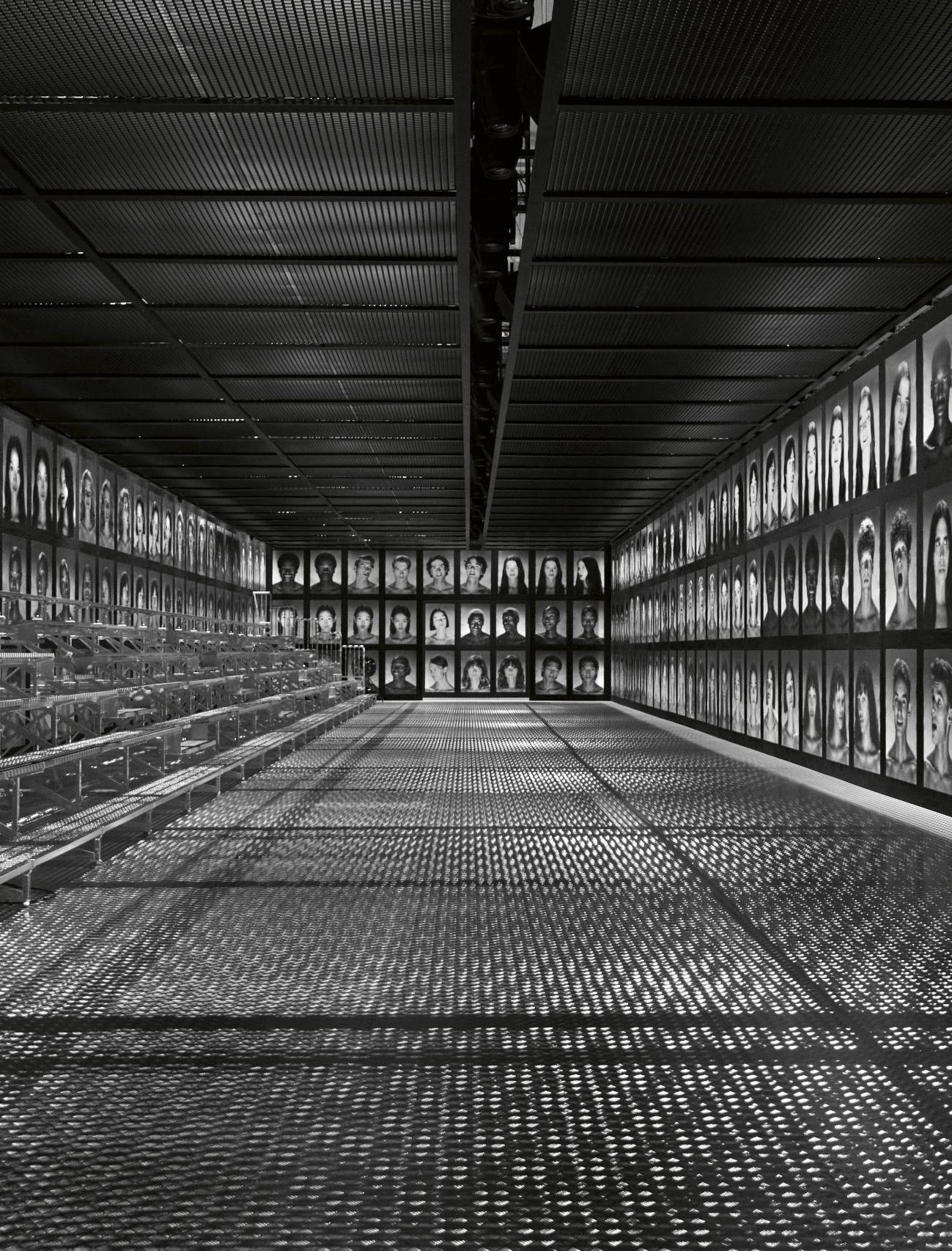



Gucci FOCUS ON 107 S/S 2023

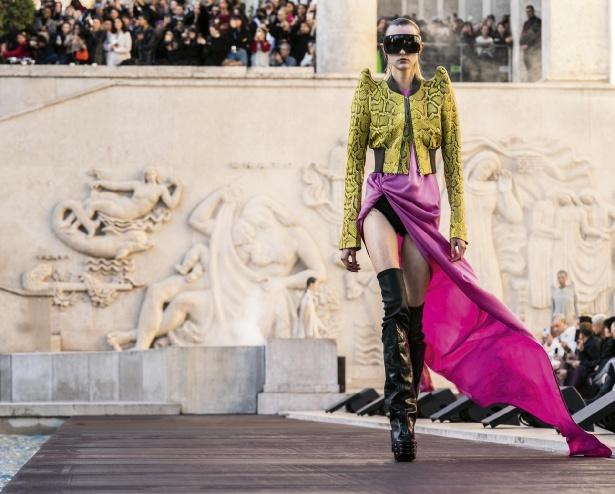

Rick Owens FOCUS ON 108 S/S 2023
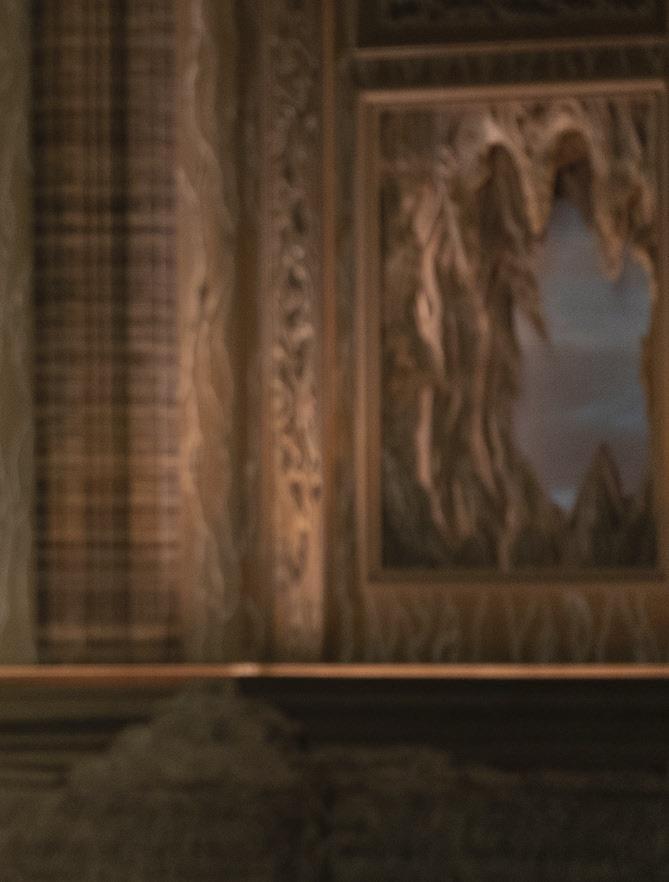

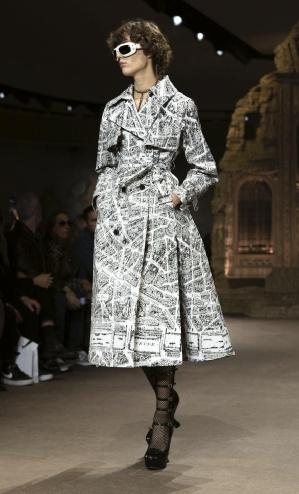

Dior FOCUS ON 109 S/S 2023
Laurent



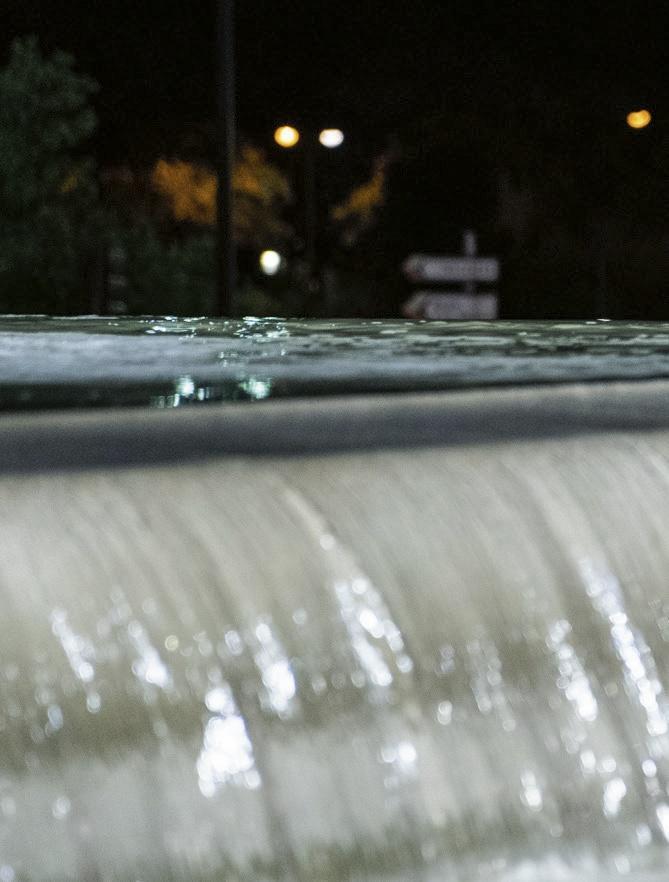
Saint
FOCUS ON 110 S/S 2023
Louis Vuitton

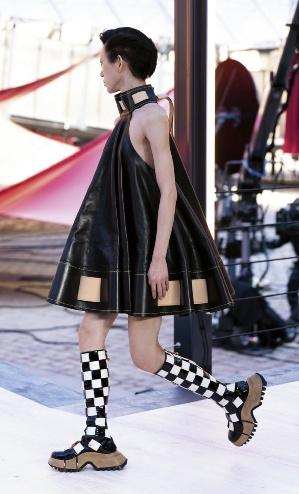

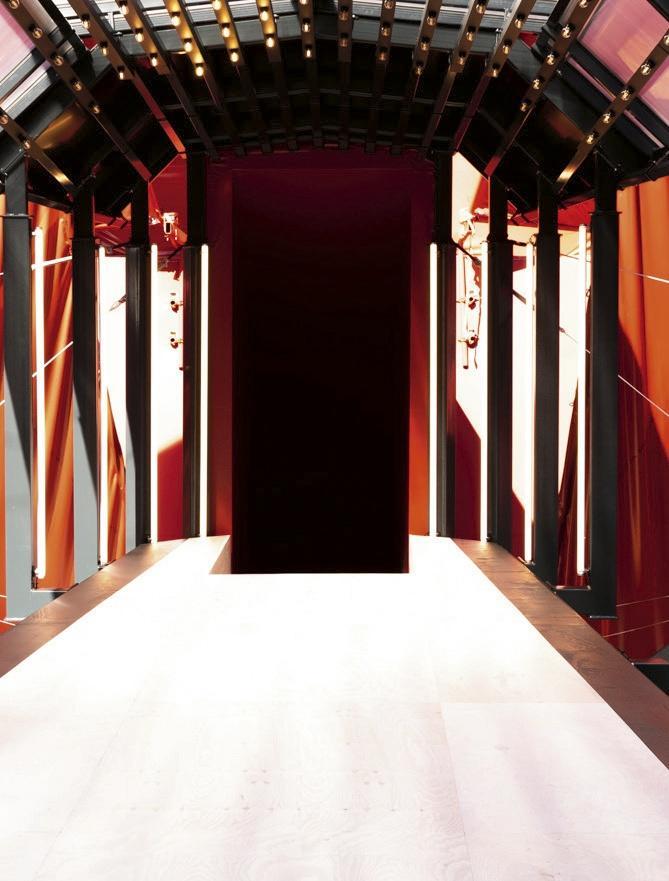
FOCUS ON 111 S/S 2023
Fashion in the time of war

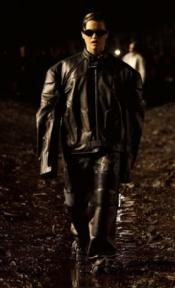 by Giulia Simonotti
by Giulia Simonotti
Che senso ha la moda in tempo di guerra? Dopo aver assi stito alla sfilata primavera estate 2023 di Balenciaga, que sta domanda ha iniziato a martellarmi in testa: modelle e modelli dai visi segnati e fasciati hanno sfilato in mezzo alla melma, al fango, di fianco a buche scavate come cra teri di bombe (opera dall’artista spagnolo Santiago Sierra) con vestiti simil militari a evocare una trincea, un mondo post apocalittico. E non è la prima volta che la maison parigina utilizza una sfilata come cassa di risonanza mediatica per spostare l’attenzione sulla guerra che dilania l’Ucraina: già con la sfilata au tunno inverno 2022-23 aveva rappresentato la collezione vestendo modelli che lottavano contro una bufera di neve, per elogiare il co raggio e l’eroismo del popolo ucraino. Il motivo per cui Balenciaga, tra tutte le grandi case di moda, ha deciso di non ignorare la guerra sta, probabilmente, nella storia personale del suo direttore creativo, Demna Gvasalia, rifugiato della Georgia, che la guerra l’ha speri mentata sulla sua pelle. Demna non è l’unico stilista ad avere un passato di guerra e non è l’unico, nel mondo della moda, che ha utilizzato il tema per sensibi lizzare il pubblico. Giorgio Armani ricorda bene la Seconda Guerra Mondiale vissuta da bambino e che lo ha segnato profondamente (anche a causa di un incidente con la polvere da sparo). Infatti, a seguito dell’invasione dell’Ucraina dello scorso 24 febbraio, la collezione Armani è stata presentata senza musica. Lo stilista ha scelto il silenzio come segno di solidarietà. Dall’altra parte della barricata molti creativi ritengono che il ruolo della moda non sia quello di mettere in luce le tante ombre della realtà, ma piuttosto farne risaltare le meraviglie e donare gioia. A febbraio, Gucci sfilò il giorno dopo l’invasione dell’Ucraina e Ales sandro Michele dichiarò che per lui la bellezza era l’unica risposta alla devastazione, che la bellezza era più forte anche della guerra. La pensava così anche Pier Paolo Piccioli: la collezione Pink Valen tino, ormai best-seller, è stata presentata sempre in corrisponden za con i primi giorni di bombardamenti su Kiev. Il designer aveva ammesso che “il lavoro è l’unico modo che conosciamo per reagi re. Non lasciandoci paralizzare dalla paura della guerra. Cercando di ricordare che il privilegio della nostra libertà ora è più grande che mai”. In fin dei conti, comunque la si veda, rimane una certezza: il mondo della moda non è solo frivolezze. Anzi, proprio confron tandosi con la tragedia la sua potenza creativa ricorda all’uomo quanto sia capace, responsabile e creatore di magnificenza o di miseria. Quando ci troviamo davanti a qualcosa di così doloroso e orribile, come la guerra, c’è chi cerca di portare l’attenzione su quanto accade e chi preferisce celebrare ciò che di bello rimane. In entrambi i casi la moda trova e dà senso… anche quando niente sembra più avere senso.
What is the point of fashion in wartime? After the Balenciaga’s spring-summer 2023 fashion show, this question started pounding in my head: models with scarred and bandaged faces paraded in the middle of the mud, next to holes dug like bomb craters (by Spanish artist Santiago Sierra) with military-style clothes evoking a trench, a post-apocalyptic world. And it is not the first time that the Parisian fashion house has used a catwalk as a media sounding board to shift attention to the war tearing Ukraine apart: already with the autumn-winter 2022-23 fashion show it had represented the collection by dressing models fighting a blizzard, to praise the courage and heroism of the Ukrainian people. The reason why Balenciaga, of all the great fashion houses, decided not to ignore the war lies, probably, in the personal story of its creative director, Demna Gvasalia, a refugee from Georgia, who experienced the war on his skin. Demna is not the only designer with a war background and he is not the only one in the fashion world who has used the theme to raise awareness. Giorgio Armani remembers well the Se cond World War that he experienced as a child and that marked him deeply (also due to a gunpowder accident). In fact, following the invasion of Ukraine on 24 February, the Armani collection was presented without music. The designer chose silence as a sign of solidarity. On the other side of the fence, many creatives believe that the role of fashion is not to highlight the many shadows of reality, but rather to bring out its wonders and give joy. In February, Gucci paraded the day after the invasion of Ukraine and Alessan dro Michele declared that for him beauty was the only answer to devastation, that beauty was stronger even than war. Pier Paolo Piccioli thought so too: the Pink Valentino collection, now a best-seller, was also presented in the first days of bombing in Kiev. The designer had admitted that ‘work is the only way we know to react. Not letting ourselves be paralysed by the fear of war. Trying to remember that the privilege of our freedom is now greater than ever’. At the end of the day, whichever way you look at it, one certainty remains: the world of fashion is not all frivolity. On the con trary, precisely by confronting tragedy its creative power reminds man how capable, responsible and creative he is of magnificence or misery. When we are faced with something as painful and hor rific as war, there are those who seek to bring attention to what is happening and those who prefer to celebrate what is beautiful that remains. In both cases, fashion finds and gives meaning... even when nothing seems to make sense anymore.
112 FASHION
112


MAX MARA
Woman/Man S/S 2023 Milan/Paris
Woman/Man S/S 2023

n molti hanno puntato sugli archivi, affondato le unghie nel passato per poi graffiare nuovamente con rivisitazioni di forme, colori e texture. Sul ritorno di diversi elementi che richiamano i Settanta non si discute. Per non parlare del rinvigorito approccio colorato alla prossima stagione estiva. Continua a riscuotere interesse e successo il concetto dei volumi esasperati che si riscontra in borse extra-large o in tacchi (spesso forieri di folli invenzioni) dalle dimensioni strabordanti.
Many have turned to the archives, sunk their nails into the past and then scratched again with revisitations of shapes, colors and textures. On the return of several elements reminiscent of the 1970s, there is no question. Not to mention the reinvigorated colorful approach to the upcoming summer season. The concept of exaggerated volumes found in extra-large handbags or heels (often harbingers of crazy inventions) of oversized dimensions continues to gain interest and success.

114 RUNWAY
JIL SANDER MAX MARA
I MILAN - PARIS

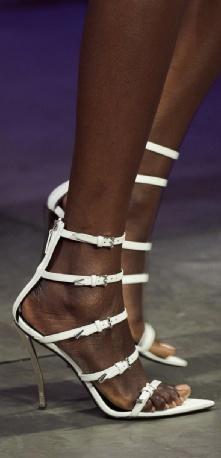
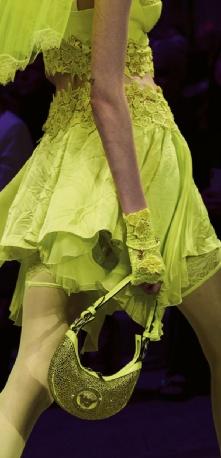

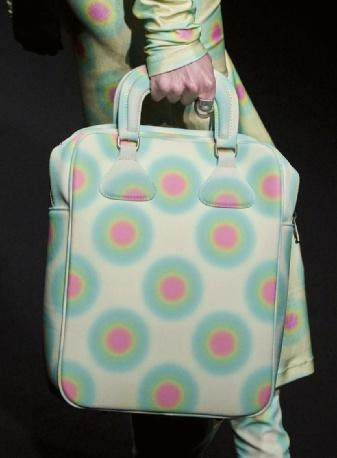
VERSACE
MILAN
RUNWAY 115
PRADA
SPORTMAX




 BOTTEGA VENETA
BOTTEGA VENETA
116 RUNWAY
ETRO
MILAN
FERRAGAMO
MILAN



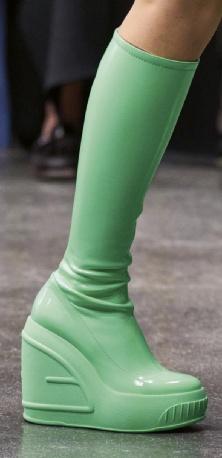
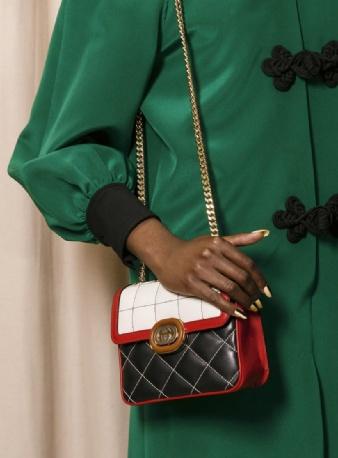
RUNWAY 117
FENDI
GUCCI
GIORGIO ARMANI

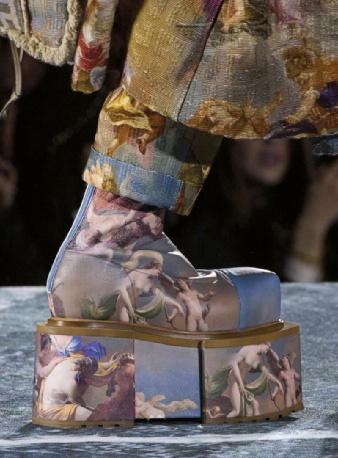

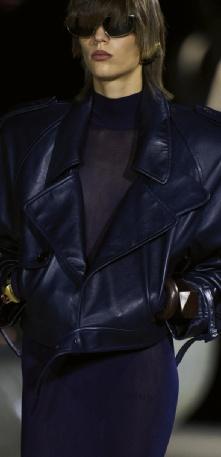

PARIS 118 RUNWAY
BALMAIN
SAINT LAURENT
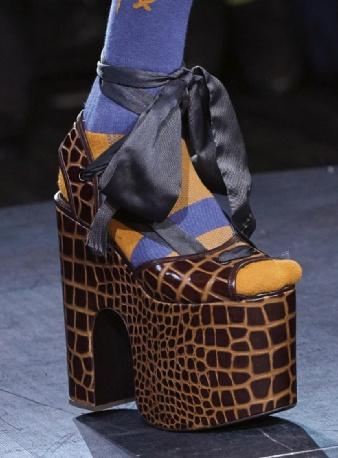


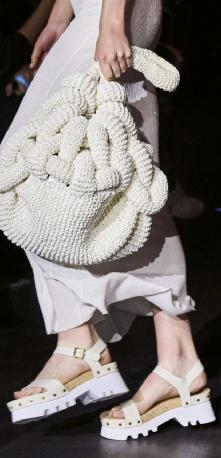

RUNWAY 119
PARIS
ANDREAS KRONTHALER for VIVIENNE WESTWOOD
CHLOÉ
RICK OWENS
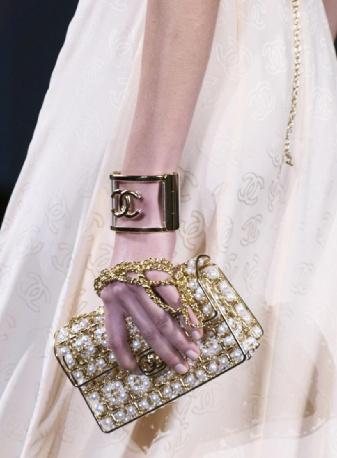
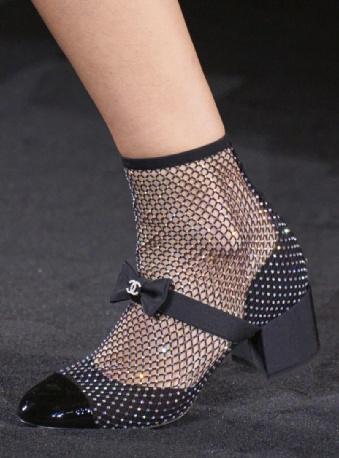

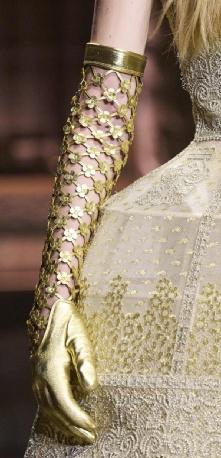

120 RUNWAY CHANEL
DIOR
PARIS
PARIS

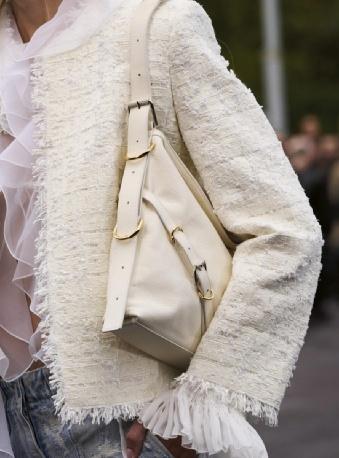

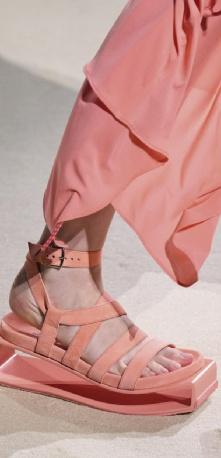

RUNWAY 121
HERMES
GIVENCHY
PARIS
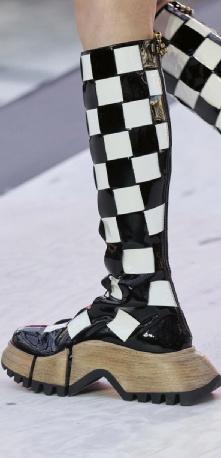



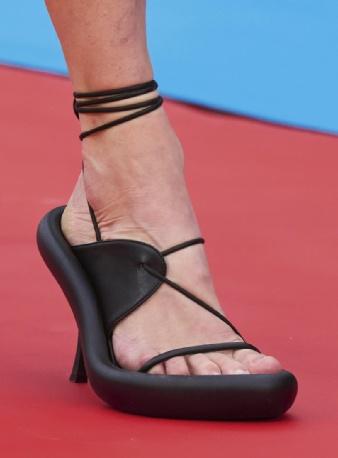
122
RUNWAY
ISSEY MIYAKE
LOUIS VUITTON
STELLA McCARTNEY

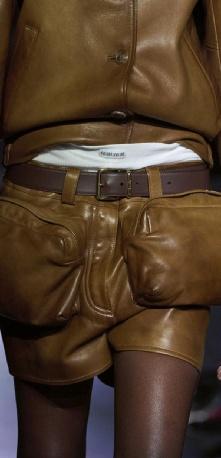

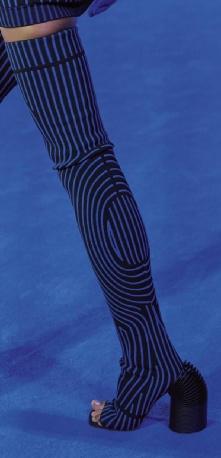
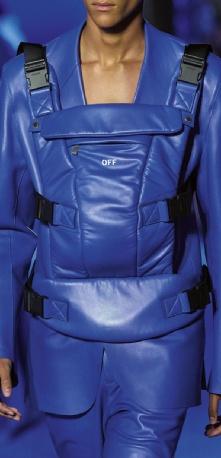
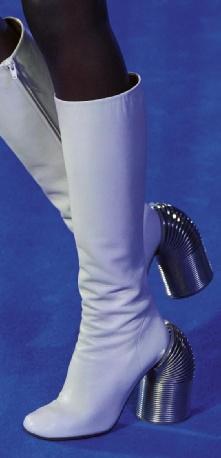
MIU MIU
PARIS
RUNWAY 123
OFF-WHITE
I lack... water
Il New York Times l’ha definita il «gigante assetato». Con una popolazione pari al 16% di quella mondiale, a fronte di una disponibilità d’acqua di appena il 4%, l’India è sempre più provata dalla scarsità delle risorse idriche. In questo Paese letteralmente a secco si trova Mahalakshmi Dhobi Ghat, la più grande lavanderia a cielo aperto del mon do, si dice. Occupa circa 8 chilometri quadrati di Mumbai. Ogni giorno, per 18-20 ore, circa 7.000 lavoratori lavano, sbiancano, tingono, asciugano e stirano più o meno 1 milione di capi d’abbi gliamento e tessuti.

Lo fanno a mano, noi diremmo ‘come si faceva una volta’, tra zan zare e caldo soffocante. La maggior parte dei malati di malaria e dengue ricoverati negli ospedali di Kasturba e Nair viene da qui. La lavanderia è nata nel 1890, in epoca coloniale, e da allora è cre sciuta in modo esponenziale per estensione e per numero di capi trattati. Piedi nudi in vasche corrose dai prodotti chimici sversati, poi, nel già fragile ecosistema fluviale e marino della regione. Un lavoro duro che, però, ‘regala’ una vita dignitosa alle circa 200 famiglie che si tramandano le vasche di lavaggio di generazione in generazione. Dignitosa rispetto alla moltitudine di poveri che affol lano i marciapiedi di questa caotica metropoli. Non suoni assurdo o poco rispettoso: quelle vasche malsane sono un lusso. Il lavoro prima di tutto. Anche a costo di ignorare la tu tela di chi vi immerge gambe e braccia o il rispetto dell’ambiente. L’attenzione per queste tematiche qui è un lusso che non ci si può permettere. Eppure, l’India è un paese assetato; in media un in diano deve accontentarsi di 3 litri di acqua al giorno, contro i 175 consumati da un italiano. Secondo una stima della Banca Mondia le, in India, il 21% delle malattie è legato all’utilizzo di acqua non potabile. La cattiva gestione delle risorse idriche, sempre secondo la Banca Mondiale, genera un costo sociale per il Paese stimato in 54 miliardi di dollari. L’India ha sete, ma avvelena le poche gocce d’acqua che potrebbero alleviare l’arsura.
Carlo Olmi, vincitore del Premio Internazionale di fotografia Agne se Meotti 2022 ha raccontato il ‘lusso’ dell’acqua con istanti foto grafici in cui il bianco emerge dal nero come una lacrima da una pupilla ferita.

124 REPORTAGE
124 In vasca
Photos by Carlo Olmi

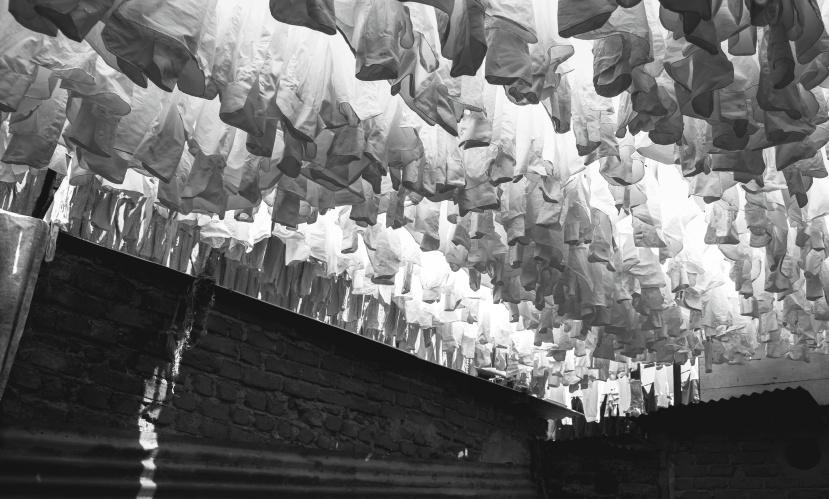
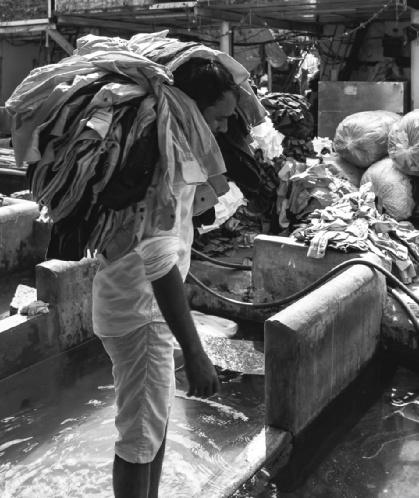
125 REPORTAGE Al sole
L’attico
Equilibrio instabile
The New York Times called it the “thirsty giant”. With a population equal to 16% of the world’s, compared to a water supply of just 4%, India is increasingly tested by water scarcity.
In this literally dry country lies Mahalakshmi Dhobi Ghat, the world’s largest open-air laundry, it says. It occupies about 8 square kilo meters of Mumbai. Every day, for 18 to 20 hours, about 7,000 workers wash, bleach, dye, dry and iron about 1 million garments and fabrics.
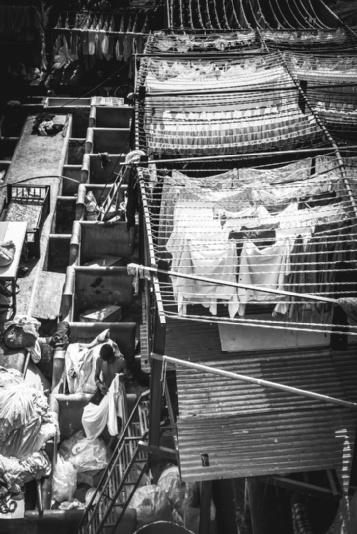
They do this by hand, we would say ‘the old-fashioned way’, amid mosquitoes and sweltering heat. Most of the malaria and dengue patients admitted to hospitals in Kasturba and Nair come from here.
The laundry was established in 1890, during colonial times, and has since grown exponentially in size and number of garments pro cessed. Bare feet in tanks corroded by chemicals spilled, then, into the region’s already fragile river and marine ecosystem.
Hard work that, however, ‘gifts’ a dignified life to the 200 or so families who hand down the washing tanks from generation to ge neration. Dignified compared to the multitude of poor who crowd the sidewalks of the chaotic metropolis.

Don’t sound absurd or disrespectful: those unhealthy tubs are a luxury. Jobs come first. Even at the cost of ignoring the protection of those who soak their legs and arms in them or respect for the environment. Attention to these issues here is a luxury that cannot be afforded.
Yet, India is a thirsty country; on average an Indian must survive with 3 liters of water a day, compared to the 175 consumed by an Italian. According to a World Bank estimate, 21% of diseases in India are linked to the use of non-potable water.
Mismanagement of water resources, again according to the World Bank, generates a social cost to the country estimated at $54 bil lion. India is thirsty, but it poisons the few drops of water that could alleviate its thirst.
Carlo Olmi, winner of the 2022 Agnese Meotti International Pho tography Prize, chronicled the ‘luxury’ of water with photographic instants in which white emerges from black like a tear from a wounded pupil.
126 REPORTAGE
Dedalo
Bagni pubblici
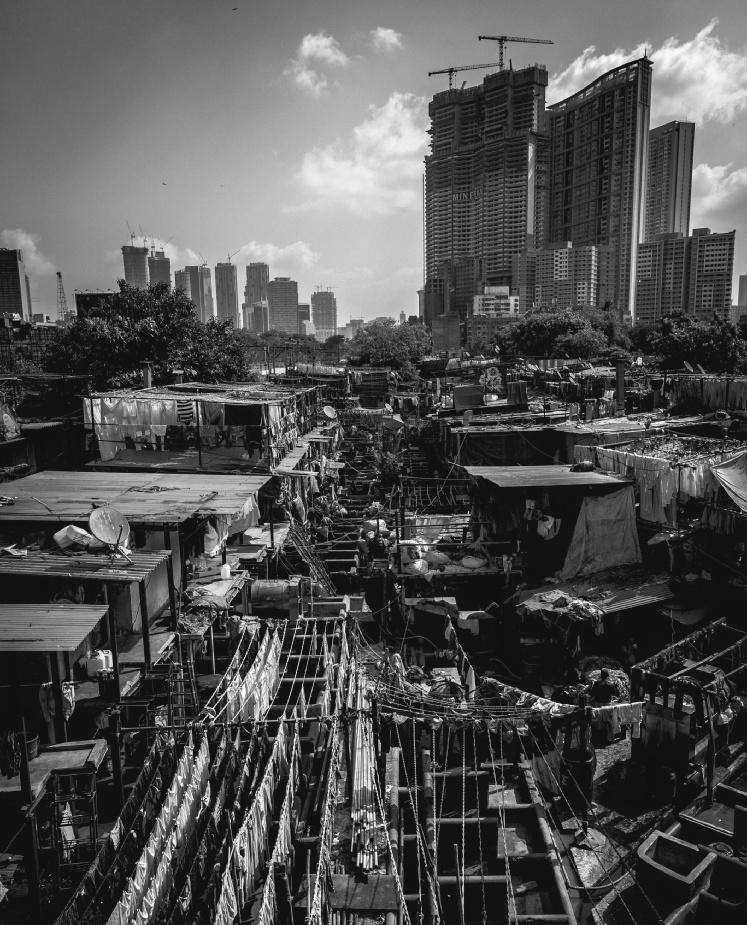
127 REPORTAGE Il labirinto
North Face
128Con sole 30 paia prodotte in tutto il mondo, la mule non sarà in vendita, ma è stata ideata per confermare l’impegno di The North Face nel portare la propria proposta footwear in contesti sempre più prestigiosi. Il modello si ispira al design distintivo dei due brand, con la suola in gomma vulcanizzata, la costruzione norvegese tipica di Paraboot e un riferimento alla Thermoball Traction V Mule di The North Face. La tomaia è in pelle matelassé full grain e un colletto elastico morbido la rendo confortevole e facile da indossare in una molteplicità di occasioni.
With only 30 pairs produced worldwide, the mule will not be for sale, but is designed to confirm The North Face’s commitment to bringing its footwear offerings to increasingly prestigious settings. The model is inspired by the distinctive design of the two brands, with a vulcanized rubber sole, Paraboot’s signature Norwegian construction, and a reference to The North Face’s Thermoball Traction V Mule. The upper is made of mate lassé full grain leather and a soft elastic collar makes it comfortable and easy to wear on a variety of occasions.

Amedeo Testoni
Siena line by Amedeo Testoni: an ‘exploration’ of handcrafted details
Tema della nuova collezione Amedeo Testoni è l’esplorazione. Un’esplorazio ne che parte prima di tutto dall’artigianalità, che da sempre contraddistingue il brand. Anche dopo 93 anni come brand di calzature di lusso, continua l’impegno nella ricerca di tecniche manifatturiere artigianali per approdare alla creazione di design moderni innovando i processi tradizionali. Ne è un esem pio la linea uomo Siena, in pelle di vitello tinta a mano, con lavorazione Bolo gnese, conosciuta anche come “costruzione a sacchetto”, e una particolare rifinitura bicolore.
The theme of the new Amedeo Testoni collection is exploration. An explora tion that starts first of all from craftsmanship, which has always distinguished the brand. Even after 93 years as a luxury footwear brand, it continues its commitment to researching artisanal manufacturing techniques to arrive at the creation of modern designs by innovating traditional processes. One example is the Siena men’s line, made of hand-dyed calfskin leather with Bolognese workmanship, also known as “pouch construction,” and a distinctive two-tone finish.

128 NEWS
The North Face for Paraboot
by Ursula Beretta

windows
Drawing by Joe Colosimo ©
From Navigli with love
La poesia di Milano è tutta qui. Nella bellezza struggente e straordinaria dei suoi placidi specchi d’acqua, in cui i riflessi del sole al tramonto raccontano una storia senza tempo che parla di eleganza d’antan e di nebbie ro mantiche. Canali ricchi di fascino, corteggiati dai tavolini dei bar all’aperto e dalle chiacchiere di gente di ogni età ed etnia, sedotti dagli strass multicolori delle luminarie che accendono negozi, rifugi e botteghe d’artigiani, capaci di par lare la lingua antica di una città in perenne movimento. Non stupi sce che qualche anno fa i Navigli, in particolare il Naviglio Grande e Porta Ticinese, siano stati inseriti dal New York Times tra le 12 strade più belle d’Europa, in un fermo immagine da percorrere a piedi o in bicicletta godendo di un concentrato di storia in chiave glamour che non smette di conquistare. Tutti, davvero. Perché il Naviglio è anche e soprattutto questo, la sua grande ca pacità di sorprendere con i suoi scorci mozzafiato. È sufficiente pensare al Cortile degli Artisti, uno scrigno custodito da un’antica casa di ringhiera; al famoso Vicolo dei Lavandai, immortalato in numerosi quadri; alla sfortunata chiesa di Santa Maria delle Grazie al Naviglio, distrutta da un incendio e poi lasciata ferita; al superfotografato Pont de Fer. Luoghi-manifesto di uno splendore mai pago che conserva una patina antica, la stessa che, ogni ultima domenica del mese, è celebrata dal mercatino dell’antiquariato che permette ai curiosi di fare un salto nel tempo, ricco di emozioni. Emozioni che sono di casa, è proprio il caso di dirlo, allo Spazio
Alda Merini (noto anche come Casa delle Arti), un palazzo in cui è stata ricostruita la camera da letto della poetessa che proprio sui Navigli abitava e che consente un’esperienza immersiva nella dolente intimità di una donna meravigliosa, curiosando tra i cimeli, le lettere, i vestiti sui quali è stata lasciata la polvere che è “fatta di ali di farfalla sbriciolate che se la spolveri cancelli i ricordi”. Poesia anche culinaria, che ha il suo indirizzo speciale in Darsena, fresca dello splendore ritrovato dopo la riqualificazione per Expo 2015, e in particolare nel Mercato Comunale, dove è consigliato approdare per una tappa mangereccia in cui gustare prodotti tipici milanesi e godere di uno scenografico aperitivo al calare del sole. Aperitivo, proprio lui! Eh sì, perché i Navigli sono da sempre la zona festaiola della città, cuore di una movida sana e pittoresca che ha nel “ape” che si consuma all’ombra della golden hour un rituale trasformato in fenomeno di costume. È tra queste vie che brulicano di gente che si può assaporare la vera movida milanese fino a notte inoltrata, in un luogo inconfondibile e unico, capace di riassumere alla perfezione la mondanità dei milanesi e il loro carattere. Chi si vuol sentire realmente cittadino della metropoli, deve venire qui e fermarsi anche per il tempo di una cena. Provare la cucina tipica nella cornice dei Navigli è un’esperienza consigliabile sotto tutti i punti di vista, culinari e non. Come non perdersi nell’atmosfera ro mantica del ristorante “El Brellin” che conserva il sapore della vec chia osteria e che, nell’eleganza senza tempo dei suoi spazi, pro pone delizie doc, cassouela e risotto giallo compresi? Piatti toscani in trasferta meneghina, invece, per lo storico “Il Montalcino” con la sua irresistibile cantina, mentre è la carta dei formaggi a farla da padrone al “Asso di Fiori”. “Alzaia 26”, invece, ha fatto suoi gli spazi di una casa di ringhiera del ‘700 mentre a “L’altro Luca e Andrea” si potrà provare tutto il calore milanese comprensivo della celebre orecchia di elefante, dell’ossobuco, dello stinco e dei mondeghili. Ma lungo l’Alzaia Naviglio Grande e nelle sue viuzze laterali c’è an che un universo creativo che parte dagli storici – e iconici - studi e laboratori di artisti e pittori e arriva alle piccole gallerie indipendenti, compresa la Fondazione Arnaldo Pomodoro. Arte, design e anche moda, perché lontano dal Quadrilatero il quartiere dei Navigli vanta una selezione di piccoli negozi vintage, atelier originali e boutique dal tocco cosmopolita assolutamente irrinunciabile. Basta fare un salto proprio all’imbocco del vicolo dei Lavandai da Desert Fish, uno dei santuari dello stile milanese, dove scovare brand nazionali e internazionali, per credere! E tornare, perché la simpatia della proprietaria e del suo staff è contagiosa. Come del resto, quella dei milanesi…

130 EDITORIAL windows location
130
The poetry of Milan is all here. In the poignant and extraordina ry beauty of its placid stretches of water, in which the reflections of the setting sun tell a timeless story of old-fashioned elegance and romantic mists. Canals full of charm, courted by the tables of open-air bars and the chatter of people of all ages and ethnici ties, seduced by the multicoloured rhinestones of the illuminations that light up shops, shelters and artisans’ workshops, capable of speaking the ancient language of a city in perpetual movement. It is not surprising that a few years ago the Navigli, and in particular the Naviglio Grande and Porta Ticinese, were included by the New York Times among the 12 most beautiful streets in Europe, in a still image to be travelled on foot or by bicycle, enjoying a concentra tion of history in a glamorous key that never ceases to conquer. Everyone, really.
Because the Naviglio is also and above all this, its great ability to surprise with its breathtaking views. Just think of the Cortile degli Artisti, a treasure chest guarded by an ancient railing house; of the famous Vicolo dei Lavandai, immortalised in numerous paintings; of the unfortunate church of Santa Maria delle Grazie al Naviglio, destroyed by fire and then left wounded; of the super-photo graphed Pont de Fer. Places-manifestos of a splendour that never paid off, which retains an ancient patina, the same one that, every last Sunday of the month, is celebrated by the antiques market that allows the curious to take a leap back in time, full of emotions.
Emotions that are at home at the Spazio Alda Merini (also known as The House of Arts), a building in which the bedroom of the po etess who lived in the Navigli area has been reconstructed, offe ring an immersive experience in the painful intimacy of a wonderful woman, browsing through the memorabilia, letters and clothes on which dust has been left, “made of crumbled butterfly wings that erase memories if you dust them”. Poetry is also culinary, which has its special address in the Darsena, fresh from its rediscovered splendour after the redevelopment for Expo 2015, and in particular in the Mercato Comunale, where it is recommended to stop if you want to taste typical Milanese products and enjoy a scenic aperitif at sunset.
Aperitivo, indeed! Oh yes, because the Navigli have always been the city’s party zone, the heart of a healthy and picturesque movida consumed in the shadow of the golden hour. It is among these streets teeming with people that one can savour the true Milanese movida until late at night, in an unmistakable and unique place that perfectly sums up the worldliness of the Milanese and their cha racter. Anyone who wants to feel like a true citizen of the metropolis should come here and stop even for dinner. Trying typical cuisine in the setting of the Navigli is an advisable experience from all points of view, culinary and otherwise. How can you not get lost in the romantic atmosphere of the ‘El Brellin’ restaurant, which retains
the flavour of the old osteria and which, in the timeless elegance of its spaces, offers DOC delicacies, including cassouela and yellow risotto? Tuscan dishes on the move in Milan, on the other hand, for the historic ‘Il Montalcino’ with its irresistible wine cellar, while it is the cheese menu that rules at ‘Asso di Fiori’. ‘Alzaia 26’, on the other hand, has made the spaces of an 18th-century railing house its own, while at ‘L’altro Luca e Andrea’ you can experience all the Milanese warmth, including the famous orecchia di elefante (elephant’s ear), ossobuco (veal shank), stinco (shin of pork) and mondeghili (chicken fingers).
But along the Alzaia Naviglio Grande and its side streets there is also a creative universe that starts with the historic - and iconicstudios and workshops of artists and painters and arrives at the small independent galleries, including the Fondazione Arnaldo Pomodoro. Art, design and even fashion, because far from the Quadrilatero the Navigli district boasts a selection of small vintage shops, original ateliers and boutiques with a cosmopolitan touch that is absolutely unmissable. Just pop in right at the entrance to Vicolo dei Lavandai at Desert Fish, one of Milan’s style sanctuaries, where you can find national and international brands, to believe it! And come back, because the friendliness of the owner and her staff is contagious. As, indeed, is that of the Milanese....

EDITORIAL 131 windows location
Federica Zambon Wok Store
There is room for everything, first and foremost design
Qual è la filosofia alla base di Wok Store e qual è il suo ap proccio allo stile?
Da Wok Store c’è un solo imperativo, la versatilità unita a un ap proccio seasonless allo stile che rende i capi dei classici senza tempo, perfetti sempre, speciali nella loro unicità che dura per sem pre. Alla base di tutto c’è un grande lavoro di ricerca e di scouting, oltre che un rapporto forte ed empatico con il cliente.
Da cosa si parte per fare un buon buying?
Sicuramente dalla ricerca dell’essenza di pezzi che siano senza tempo e capaci di fare guardaroba, che si pongano, cioè, in ma niera complementare con la proposta interna al negozio, in cui c’è spazio per diverse fasce di prezzo e per differenti occasioni d’uso. Perché è necessario guardare alla vita reale in cui momenti sociali e altri casual vanno di pari passo in una quotidianità sem pre diversa.
Quali sono gli atout che vi fanno scegliere un brand piuttosto che un altro?
Adesso i veri discriminanti sono i materiali, il “Made in” e il conte nuto di sostenibilità. Siamo stati i primi ad avere lanciato, a Milano, Jacquemus, Coperni, Josha Rubchinskiy, il brand russo del pupil lo di Rei Kawakubo, mentre, per quanto riguarda gli italiani, Rold Skov di Francesco Rossini, Federico Cina e Magliano.
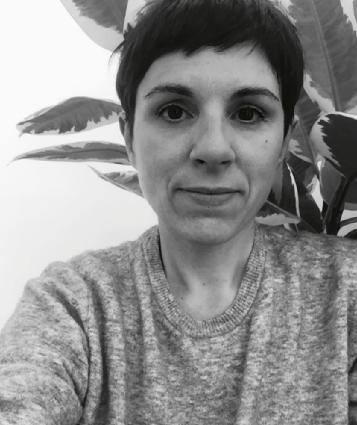
Colab, limited edition, partnership speciali: ci racconta quali sono stati i vostri step clou?
La moda cambia sempre. Questa è la regola d’oro di Federica Zambon che, 15 anni fa, ha dato vita a Wok Store, un concept store di Milano in cui l’esperienza d’acquisto assume una connotazione diversa. Perché in vendita non ci sono semplici abiti, ma una vera e pro pria concezione di lifestyle il cui contenuto – culturale, ma anche artistico, assolutamente di ricerca – si vive prima ancora di indossarlo. Vediamo come.
Wok Store, il concept store in cui la ricerca è di casa: com’è nato il negozio, Federica?
Nel 2006, io e la mia socia di allora sentimmo l’esigenza di un ne gozio che a Milano non c’era: lo sguardo si rivolgeva a Londra, all’Europa tutta, in cui lo spazio fisico del punto vendita era conce pito come un contenitore versatile in cui ci fosse posto per tutto, in primis il design. La mia formazione artistica da una parte e la curiosità nel replicare qualcosa in cui intravedevo il futuro dall’altra ci spinsero a creare uno store in cui arte, moda e comunicazione fossero legati a 360 gradi. Da qui i primi eventi, le prime collabo razioni in chiave artistica che hanno caratterizzato Wok Store e lo hanno connotato come una vetrina speciale, un bazaar eclettico e moderno.
Abbiamo fatto un paio di partnership fortunate con gli anfibi di Tri cker’s e con Retrosuperfuture, un brand di eyerwear italiano con cui abbiamo creato, per il nostro 10mo anniversario, gli occhiali Wok. Inoltre, in occasione di White Milano, abbiamo collaborato con alcuni giovani designer per creare la Wok Room negli spazi del Superstudio. Ovviamente senza dimenticare tutti gli altri eventi di cui è costellata la nostra storia!
Wok Store è anche una raffinata e-boutique, creata a immagi ne e somiglianza del negozio fisico: quali sono le ragioni per visitarla?
Credo che la boutique online sia una vetrina e serva principalmente a questo, anticipando in qualche caso il passaggio fisico in nego zio oppure permettendoci di raggiungere i nostri clienti nel mondo. I brand più cercati sono sicuramente Magliano, Aeyde e Paloma Wool, un’altra nostra scoperta.
Parliamo del rapporto con i clienti… È da sempre fondamentale mettere a proprio agio il cliente quando entra da noi e fargli capire il brand e lo storytelling di quello che proponiamo, un contenuto che va ben oltre l’estetica. Per questo credo molto nel valore del team, nella sua preparazione, nell’em
132 EDITORIAL windows shop
patia con il cliente, nella sua capacità di informarlo e di guidarlo a districarsi nel mare magnum della moda, fornendo un’informazione chiara e completa in linea con la visione di Wok.
Tre parole per descrivere il vostro cliente tipico Curioso, istruito e attento alle tendenze
Cosa vede nel vostro futuro e in quello della moda?
L’entusiasmo! Guardare avanti, essere propositivi e positivi. E per la moda in generale non saprei… penso che l’unica persona che, oggi, potrebbe rispondere a una simile domanda sia Alessandro Michele!
Fashion is always changing. This is the golden rule of Federica Zam bon who, 15 years ago, set up Wok Store, a concept store in Milan where the shopping experience takes on a different connotation. Be cause on sale are not just clothes, but a real lifestyle concept whose content - cultural, but also artistic, absolutely research-based - can be experienced even before wearing it. Let’s see how.
Wok Store, the concept shop where research is at home: how did the shop come about, Federica?
In 2006, my partner at the time and I felt the need for a shop that did not exist in Milan: our gaze was turned to London, to the whole of Europe, where the physical space of the shop was conceived as a versatile container in which there was room for everything, design first and foremost. My artistic training on the one hand and my cu riosity in replicating something in which I saw the future on the other pushed us to create a store in which art, fashion and communication were linked at 360 degrees. Hence the first events, the first collabo rations in an artistic vein that characterised Wok Store as a special showcase, an eclectic and modern bazaar.
What is the philosophy behind Wok Store and what is its appro ach to style?
At Wok Store there is only one imperative, versatility combined with a seasonless approach to style that makes garments timeless clas sics, perfect always, special in their uniqueness that lasts forever. Underlying it all is a great deal of research and scouting work, as well as a strong and empathetic relationship with the customer.
What is the starting point for good buying?
Certainly, from the search for the essence of pieces that are timeless and able to make a wardrobe, that is, that complement the in-store offer, where there is room for different price ranges and different oc casions of use. Because it is necessary to look at real life where social and casual moments go hand in hand in an ever-changing everyday life.
What are the atouts that make you choose one brand over another?
Now the real discriminators are materials, ‘Made in’ and sustaina bility content. We were the first to launch, in Milan, Jacquemus, Coperni, Josha Rubchinskiy, the Russian brand of Rei Kawakubo’s protégé, and, as for the Italians, Rold Skov by Francesco Rossini, Federico Cina and Magliano.
Colab, limited editions, special partnerships: can you tell us what have been your highlights?
We made a couple of lucky partnerships with Tricker’s amphibians and with Retrosuperfuture, an Italian eyerwear brand with whom we created, for our 10th anniversary, the Wok glasses. Furthermore, on the occasion of White Milano, we collaborated with some young designers to create the Wok Room in the Superstudio spaces. Of course, without forgetting all the other events with which our history is studded!
Wok Store is also a refined e-boutique, created in the image and likeness of the physical shop: what are the reasons for vi siting it?
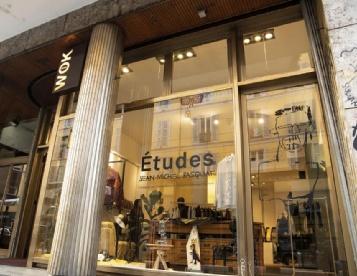
I believe that the online boutique is a showcase and serves mainly for this purpose, in some cases anticipating the physical shop or allowing us to reach our customers around the world. The most searched brands are definitely Magliano, Aeyde and Paloma Wool, another discovery of ours.
Let’s talk about the relationship with customers...
It has always been essential to put customers at ease when they come to us and make them understand the brand and the storytel ling of what we offer, a content that goes far beyond aesthetics. This is why I strongly believe in the value of the team, in their preparation, in their empathy with the customer, in their ability to inform and guide them to untangle themselves in the magnum sea of fashion, provi ding clear and complete information in line with Wok’s vision.
Three words to describe your typical customer Curious, educated and trend-conscious
What do you see in your future and that of fashion?
Enthusiasm! Looking forward, being proactive and positive. And for fashion in general, I don’t know... I think the only person who could answer such a question today is Alessandro Michele!
EDITORIAL 133 windows shop
His majesty the amphibian
Si chiama anfibio, ma non è un animale. Senza dubbio è impermeabile e pure impeccabile per la sua capacità di resistere alle intemperie, ma le sue origini, pur risalenti alla notte dei tempi, hanno poco a che fare con questioni bio-geologiche. Ma andiamo per gradi. Quello che Pete Townshend, storico frontman degli Who e icona, anche stilistica, di un’epoca e della sua cultura, considerava una divisa, ha letteralmente attraversato le epoche mostrando una trasversalità ancora oggi inimitabile. Soldati, operai, rockstar, anziani, infortunati; e ancora modelle, ribelli, intellettuali e rivoltosi: la lista di chi ha indossato gli anfibi è lunga e in continuo aggiornamento. Il merito è tutto da ricercare in quella versatilità che gli appartiene per DNA: presente fin dagli albori delle civiltà, modellato sul calceus, lo stivaletto al calcagno indossato dai nobili cives romani fin dal II secolo a.C., era realizzato in cuoio con decori preziosi e la sua pratica comodità venne presto virata in chiave militare quando divenne la calzatura prediletta dei soldati dell’Impero Romano d’Oriente, prima di aprirsi a un carriera worldwide declinata lungo i secoli. Grazie a progressive migliorie che li resero funzionali a una vita in trincea, gli avi degli anfibi divennero impermeabili, acquistarono la loro iconica suola a carrarmato diventata poi chiodata, la chiusura a stringhe e quelle cuciture in punta con i quali arrivarono ai piedi di Klaus Maertens. Era il 1945 e quel medico tedesco infortunatosi sugli sci pensò bene di riadattare un paio di anfibi militari -inaugurando, suo malgrado, il trend sostenibile - insopportabilmente duri per il suo piede ferito ispirandosi alle scarpe antiinfortunistiche, comode e soprattutto dotate di un’ottima ammortizzazione. Caratteristiche, queste, che le resero calzature feticcio per lui e per una
pletora di incidentati e persone anziane alla ricerca di un sostegno per muoversi più agevolmente. Ma la nicchia dei consumatori si allargò grazie all’intuito di un produttore britannico e agli aggiustamenti che vi inserì - il design del tallone, le tipiche cuciture gialle e le suole AirWair - che segnarono la nascita di quei Dr. Martens modello 1460 diventati presto la scarpa da due sterline, comoda e indistruttibile, di operai, poliziotti e postini. Questo fin0 a quando il Pete Townshend di cui sopra li indossò a un concerto cambiando per sempre la storia dei Dr. Martens e dei suoi adepti. Da lì seguirono i punk, gli anticonformisti, gli skinhead rossi e neri, la new wave degli anni 80 e tutto quel ricco immaginario racchiuso nell’essenza stessa dell’anfibio, capace di andare al di là delle mode per conquistare intere generazioni. E, in ultimo, vennero gli stilisti. Che se ne appropriarono. Che li ingentilirono. Che gli diedero un nuovo carattere. Che giocarono con profili, cuciture, fibbie e suole rendendoli un must have irrinunciabile. Dalla passerella – sconsacrata - di Marc Jacobs per Perry Ellis nel lontano 1993 a oggi, i combat boots sono un modello sempre presente nelle collezioni delle grandi maison: basti solo pensare alla Resort 2023 di Louis Vuitton con i suoi anfibi ricchi di catene abbinati a mini dress femminili o ai contrasti sbarazzini di Miu Miu tra mise e scarponi carrarmato. Ma per il quotidiano? Ci ha pensato Cult, che è stato il primo a lanciare in Italia, nel 1987, l’anfibio a 8 buchi: diretta emanazione del suo cugino british con quel suo fascino punk e underground esasperato dal puntale in acciaio, la calzatura del brand non ha smesso di evolversi rimanendo sempre fedele a sé stessa. Il risultato? Una scarpa in cui ogni generazione si è riconosciuta e si riconosce, fuori dagli schemi e assolutamente no gender. In una parola, un’icona.
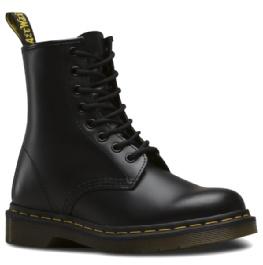
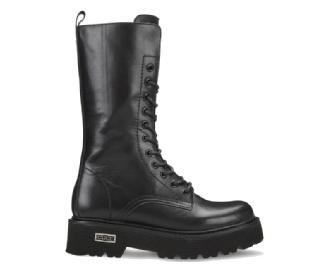
134 EDITORIAL windows products
Cult Dr.
Martens
It is called amphibian, but it is not an animal. It is undoubtedly wa terproof and even flawless in its ability to withstand the elements, but its origins, though dating back to the mists of time, have little to do with bio-geological issues. But let us go step by step. What Pete Townshend, historical frontman of The Who and icon, also stylistic, of an era and its culture, considered a uniform, has literally crossed the epochs, displaying a transversality that is still inimitable today. Soldiers, workers, rock stars, the elderly, the injured; and even models, rebels, intellectuals and insurgents: the list of those who have worn the amphibians is long and constantly updated. The merit lies in that versatility that belongs to their DNA: present since the dawn of civilisations, modelled on the calceus, the heel boot worn by noble Roman cives from the 2nd century B.C., they were made of leather with precious decorations and their practical comfort was soon turned to military use when they became the favourite footwear of the soldiers of the Eastern Roman Empire, be fore opening up to a worldwide career that declined over the cen turies. Thanks to gradual improvements that made them functional for life in the trenches, the ancestors of the amphibian became waterproof, acquired their iconic carrarmate sole which later beca me spiked, the lace-up closure and those stitching at the toe with which they reached the feet of Klaus Maertens. It was 1945 and that German doctor who had been injured on skis thought well of adapting a pair of military amphibious boots -inaugurating, in spite of himself, the sustainable trend - that were unbearably hard on his injured foot, taking inspiration from safety shoes, comfortable and above all with excellent cushioning. Characteristics, these, that made them fetish footwear for him and for a plethora of accident
victims and elderly people looking for support to move more easily. But the consumer niche widened thanks to the insight of a British manufacturer and the adjustments he made to it - the heel design, the typical yellow stitching and AirWair soles - that marked the birth of those Dr. Martens model 1460s that soon became the comforta ble and indestructible two-pound shoe of workers, policemen and postmen. That is, until the aforementioned Pete Townshend wore them to a concert and changed the history of Dr. Martens and its followers forever. From there followed the punks, the nonconfor mists, the red and black skinheads, the new wave of the 80s and all that rich imagery contained in the very essence of the amphibian, capable of going beyond fashion to conquer entire generations. And, finally, came the fashion designers. Who appropriated them. Who refined them. Who gave them a new character. Who played with profiles, stitching, buckles and soles, making them a musthave. From Marc Jacobs’ - deconsecrated - catwalk for Perry Ellis back in 1993 to the present day, combat boots are an ever-present model in the collections of the big fashion houses: just think of Louis Vuitton’s Resort 2023 with its chain-linked amphibian boots teamed with feminine mini-dresses or Miu Miu’s jaunty contrasts between outfits and tank boots. But for everyday wear? Cult was the first to launch the 8-hole amphibian in Italy, in 1987: a direct emanation of its British cousin with its punk and underground allure exasperated by the steel toe cap, the brand’s footwear has never stopped evolving while remaining true to itself. The result? A shoe in which every generation has recognised and recognises itself, out of the box and absolutely no gender. In a word, an icon.
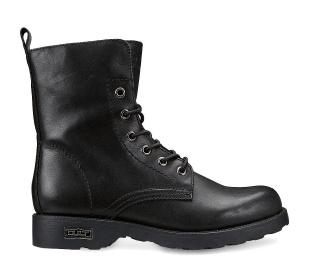

EDITORIAL 135 windows products
Cult Dr. Martens
Intriguing novelties

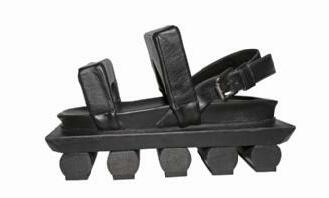

Da diversi anni MICAM Milano permette ai compratori di entrare in contatto con alcuni nuovi, curiosi e interes santi marchi internazionali.
Nell’ultima edizione di settembre si è rinnovata l’intera sezione della manifestazione con nuovi nomi e creati vità sempre più intriganti.
Ci hanno particolarmente colpito due brand, espres sione giovane, contemporanea e un po’ folle dei temi più in tenden za delle recenti stagioni.
Sergio Silva presenta ÉHONTÈ che nasce dal desiderio delle donne di possedere nel proprio armadio un jolly capace di caratterizzare il guardaroba. La filosofia di design ha un approccio Bauhaus in cui la forma segue la funzione. “Diamo risalto alla tecnologia attraverso la stampa 3D, a nuove tecniche mai esplorate o anche a tecniche tradizionali che suonano come nuove rispetto agli standard odierni. ÉHONTÈ ha sempre immaginato un marchio che riflettesse i nostri valori sociali”.
Victoria André presenta, invece, il marchio Vandrélaar fondato con il preciso obiettivo di fondere un design senza tempo con un’ar tigianalità di qualità. “In un mondo saturato da continue mode e da una cultura usa e getta, abbiamo fatto un passo indietro per concentrarci su ciò che conta davvero per noi: rallentare il ciclo della moda progettando in modo integrato, producendo meno e utilizzando materiali più rispettosi del pianeta”

136
136
Ehonte
For several years now, MICAM Milan has allowed buyers to come into contact with some new, curious and interesting international brands.





In the last edition in September, the entire section of the show was renewed with new names and increasingly intriguing creativity. We were particularly impressed by two brands, young, contempo rary and somewhat crazy expressions of the trendiest themes of recent seasons.
Sergio Silva presents ÉHONTÈ, which stems from women’s de sire to have a jolly in their wardrobe. The design philosophy has a Bauhaus approach in which shape follows function. “We em phasise technology through 3D printing, new techniques that have never been explored or even traditional techniques that sound new by today’s standards. ÉHONTÈ has always imagined a brand that reflects our social values”.
Victoria André presents, on the other hand, the Vandrélaar brand that was founded with the precise aim of fusing timeless design with quality craftsmanship. “In a world saturated by constant fads and a disposable culture, we took a step back to focus on what really matters to us: slowing down the fashion cycle by designing in an integrated way, producing less and using more planet-friendly materials.”
137
Vandrelaar
Watch the interview to our selection of Emerging Designers
Ducanero 138
The magic of colour (even black)
La famiglia Camerlengo crea calzature da uomo e da donna da oltre trent’anni. La storia ha inizio con Ga briele, per poi proseguire con la seconda generazione, rappresentata da Marco e Matteo. Un ricco patrimonio familiare fatto di conoscenze e tradizioni e, al tempo stesso, un’azienda giovane.
Le scarpe Ducanero sono interamente realizzate a Monte San Giusto, nel cuore di uno dei più importanti distretti cal zaturieri italiani. Dal design al prodotto finale la creatività e il genio di artigiani altamente qualificati realizzano collezioni che appaiono come il racconto di una storia senza tempo. “Scarpe che hanno un passato ancor prima di essere indossate, pensate da menti creati ve e realizzate da mani sapienti”, raccontano in azienda. Un fascino antico che si materializza in ogni processo produttivo, in cui sono evidenti i segni della tradizione calzaturiera italiana e attraverso cui forme e colori si fondono in qualcosa di nuovo. Il tocco di classe delle collezioni Ducanero? Il colore. “La nostra competenza risiede nell’esclusivo processo di colorazione chiama to ‘tinto in capo’: ogni singolo pezzo di pelle viene immerso nel colore più puro.
Quando la pelle di altissima qualità incontra la vivacità e la forza del colore, avviene la magia. Assorbe naturalmente il colore e prende vita, acquisendo sfumature ricche, magnifiche e uniche”. Dalla tomaia alla suola, ogni parte della scarpa viene tinta singolar mente per ottenere omogeneità ed esaltare texture e volumi. In seguito, il colore viene lasciato asciugare naturalmente, in modo che il tempo possa fissarlo delicatamente.
Per la prossima stagione Ducanero ha deciso di puntare tutto sulla creatività, con grandi ritorni come i camperos o i texani, i combat boots con un chiaro richiamo allo stile grunge anni Novanta, e infi ne i bikers, grintosi ed eccessivi. Grande spazio, quest’anno, è riservato ai mocassini, in pelle nera o marrone lucida.
Si torna, poi, alle calzature con fondo in cuoio, alla bellezza delle suole di bufalo con striature e caratteristiche uniche nel loro genere che danno un sapore di artigianalità davvero spettacolare. “Se per diverse stagioni abbiamo assistito al dominio del colore, ora si inverte la rotta e si ritorna al nero, la tonalità preferita dalla moda. Il nero è sempre stato il nostro colore più importante, che ci contraddistingue e che meglio si adatta alle nostre calzature”.
The Camerlengo family has been creating men’s and women’s fo otwear for over thirty years. The story began with Gabriele, and continued with the second generation, represented by Marco and Matteo. A rich family heritage of knowledge and tradition and, at the same time, a young company.
Ducanero shoes are entirely made in Monte San Giusto, in the he art of one of Italy’s most important footwear districts. From the design to the final product, the creativity and genius of highly skilled craftsmen create collections that appear like the tale of a timeless story. “Shoes that have a past even before they are worn, concei ved by creative minds and made by skilful hands”, they tell from the company.
An ancient charm that materialises in every production process, in which the signs of the Italian footwear tradition are evident and through which shapes and colours merge into something new.
The classy touch of the Ducanero collections? The colour. “Our ex pertise lies in the exclusive colouring process called ‘tinto in capo’: every single piece of leather is immersed in the purest colour. When the highest quality leather meets the vibrancy and strength of co lour, magic happens.
It naturally absorbs the colour and comes to life, acquiring rich, magnificent and unique shades.
From the upper to the sole, each part of the shoe is individually dyed to achieve homogeneity and enhance texture and volume. Afterwards, the colour is left to dry naturally so that time can gently fix it.
For the coming season, Ducanero has decided to focus on creati vity, with great returns such as camperos or Texans, combat boots with a clear reference to the grunge style of the Nineties, and finally bikers, gritty and excessive.
Great space, this year, is reserved for moccasins, in black or shiny brown leather.
There is a return, then, to footwear with leather soles, to the beauty of buffalo soles with unique streaks and features that give a truly spectacular taste of craftsmanship.
“If for several seasons we have witnessed the dominance of colour, we now reverse course and return to black, the fashion favourite. Black has always been our most important shade, which distingui shes us and best suits our footwear”.
138 COMPANY


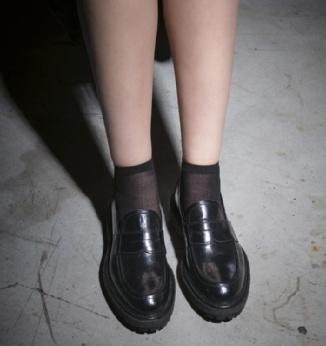

139 COMPANY
“Shoes that have a past even before they are worn, conceived by creative minds and made by skilful hands”
140
Press Room:
It’s happen
Press Room
Idivinity
La Maison nasce dalla sinergia creativa dell’imprenditore italiano Luca Corinaldesi, CEO di uno dei più importanti Ricamifici italiani nel mondo del lusso, e del designer dei beni di lusso, Salvatore Elia. Nascono così accessori unici ed elitari, ricamati su tela nera attraverso fittissimi punti battuti in filo prezioso, caratterizzati da rilievi scultorei, superfici monolitiche e colori desaturati che iden tificano un mood minimalista destinato a protrarsi nel tempo. Ma terico, duttile, scultoreo, identitario, gender fluid, monocromatico, minimalista, artigianale, Made In Italy sono i punti cardine di un marchio che vuole esprimere visioni innovative, valori e unicità.

Idivinity
An identifying and gender fluid style for those who want to stand out
Maison Idivinity was born from the creative synergy of the Italian entrepreneur Luca Corinaldesi, CEO of one of the most important Italian embroidery factories in the world of luxury, and Salvatore Elia, designer of luxury goods. These are the origins of unique and elite accessories, embroidered on black canvas through very den se stitches in precious thread, characterised by sculptural reliefs, monolithic surfaces and desaturated colours, which identify a mini malist mood destined to last over time. Material, ductile, sculptural, identifying, gender fluid, monochromatic, minimalist, handcrafted, andMade in Italy: these are the cornerstones of a brand that would like to express innovative visions, values and uniqueness.
140
PRESS ROOM
Stile identitario e gender fluid per chi vuole distinguersi
Henope
“Leggenda”: quel che conta non è la meta, ma… lo zaino
Giuseppe Ungaretti sentenziava: “La meta è partire”. E lo zai no Leggenda di Hènope è il compagno di viaggio ideale. Lo hanno ideato due fratelli che di trasferte se ne intendono (uno vive a Napoli e l’altro a Miami), fondatori del giovane brand (il cui nome deriva da Parthènope, antica denominazione latina di Napoli) ma già votato all’eccellenza del made in Italy. Lo zaino Leggenda è realizzato artigianalmente e vanta pellami di eccellente qualità e dettagli degni di un bagaglio di Bruce Chatwin. I ganci metallici di cui Leggenda è dotato, per esempio, non sono solo un bel detta glio di design ma consentono l’unione di altri accessori, borsellini e porta oggetti.
Henope
“Legend”: what counts
the destination, but... the backpack

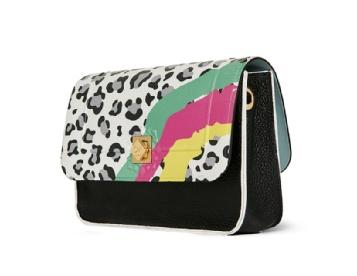
Giuseppe Ungaretti sentenced: ‘The goal is to leave’. And Hèno pe’s Leggenda backpack is the ideal travelling companion. It was designed by two brothers who know a thing or two about travelling (one lives in Naples and the other in Miami), the founders of the young brand (whose name derives from Parthènope, the ancient Latin name for Naples) but who are already devoted to the excellence of Made in Italy. The Leggenda backpack is handcrafted and boasts excellent quality leather and details worthy of a Bruce Chatwin luggage. The metal hooks with which Leggenda is equip ped, for example, are not only a nice design detail but also allow for the attachment of other accessories, purses and holders.
De Marquet
Presentata a Milano Moda Donna la scultura realizzata da Kalen Lennox in resina cristallo che vuole eternare lo stile di Amy Wi nehouse, scomparsa a soli 27 anni. La cantante, infatti, ha indos sato le scarpe intrappolate nella resina in occasione del Concerto per il 90° compleanno di Nelson Mandela. Amy Winehouse, rico noscibile non solo per la sua incredibile voce, ma anche per la pet tinatura, la body art e lo stile, ha colpito Lennox il quale ha scelto di dipingere nell’opera il tatuaggio dedicato da Amy a sua nonna e di impreziosire la scarpa con l’iconica rosa di Amy. Lennox ha scelto di cristallizzare ‘Amy’ in modo esplosivo così facendo per mostrare il violento impatto psicologico che Hollywood e la fama possono avere sulle star.
De Marquet
Raffaella Iten, founder and creative spirit of the brand, confirms also for the coming spring-summer 23 her focus on the modern idea of sustainability: the base of the bags remains the same, while the covers change. The Night&Day system of De Marquet (WIPO mod.dep.), with its interchangeable covers, accordingly combines design, fashion, and functionality, adapting itself to all moods and all occasions with just a simple click. The new collection, in particu lar, proposes innovative and seemingly abstract prints with a frac tal theme, where mathematic calculations and numbers become colours and unique shapes, with innovative printing techniques on hammered cowhide.
141 PRESS ROOM
is not
Il gioco della trasformazione in soli due click!
The game of transformation in just two clicks!
Hide Hide&Jack: luxury sneakers made in Italy
Il brand fondato da Alberto e Nicola Franceschi nel 2014 propone come leit motif per la nuova SS23 il lifestyle anni ‘90, con prota gonisti pelle lucida, mix di accessori, colori e finiture diverse. Dalla denim mania, passando dall’utilizzo di colori accessi sino allo stile grafico dei murales, Hide&Jack offre così un’ampia selezione per rivivere quegli anni con un rinnovato stile contemporaneo. Come sempre la collezione vede la selezione dei migliori pellami e mate riali italiani e viene realizzata in Veneto da esperti artigiani del famo so distretto calzaturiero della Riviera del Brenta.
Hide Hide&Jack: made in Italy luxury sneakers

The brand founded by Alberto and Nicola Franceschi in 2014 pro poses the ‘90s lifestyle as a leit motif for the new SS23, starring shiny leather, mix of accessories, different colors and finishes. From denim mania, through the use of bright colors to the graphic style of the street art, Hide&Jack thus offers a wide selection to relive those years with a renewed contemporary style. As always, the collection sees the selection of the best Italian leathers and mate rials and is made in the Veneto region by expert craftsmen from the famous footwear district of the Riviera del Brenta.
Giovani
Daniele Giovani Design al Festival di Venezia
Le calzature Daniele Giovani Design si distinguono per l’immate rialità seduttiva della luce, che prende forma nella preziosità dei pellami pregiati dai riflessi luminosi e cangianti, che richiamano lo stupore che suscitano certe albe o tramonti quando il cielo si tinge di riflessi dorati. E proprio da queste suggestioni prende il nome la nuova collezione del brand chiamata ‘Metafore di Luce’, presenta ta alla Fashion Week di Montecarlo e diventata poi grande prota gonista anche al Festival del cinema di Venezia. ‘Metafore di luce’ si caratterizza per le lavorazioni artigianali, insite nel Made in Italy, che vanno dai trafori sinuosi o geometrici alle rouches dal tocco femminile, dalle eleganti cavigliere gioiello ai raffinati puntali dorati.
Giovani Daniele Giovani Design at the Venice Film Festival
Daniele Giovani Design shoes stand out for the seductive immate riality of light, which takes shape in the exquisiteness of premium le athers featuring bright and iridescent reflections, recalling the mar vel of certain dawns or sunsets when the sky is filled with golden reflections. It is precisely from this idea that the name of the brand’s new collection, ‘Metaphors of Light’, takes its name. Presented du ring Montecarlo Fashion Week, it then went on to also become the great protagonist of the Venice Film Festival. ‘Metaphors of Light’ is characterised by artisanal workmanship, intrinsic to Made in Italy, which ranges from sinuous or geometric openwork details to ruffles with a feminine touch, from elegantly jewelled anklets to the most sophisticated golden toes.
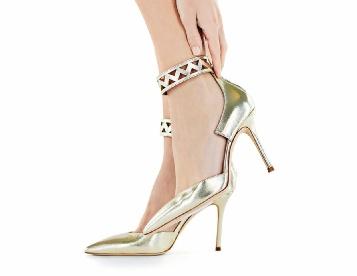
PRESS ROOM 142
Ledeff
Le nuove mini bag porta cellulare
Il brand napoletano, creato da Barbara e Luigia de Felice, inizia il suo viaggio creativo nel 2017 con un baule da collezionista, che le due sorelle ricevono dalla nonna e al cui interno trovano seta francese, velluto, abiti antichi e accessori di ricca eredità napole tana. Piccoli ’tesori’ che Barbara e Luigia decidono di trasformare in una collezione esclusiva e senza tempo di borse fatte a mano, una diversa dall’altra, dove la cura dei dettagli è maniacale. Il nome che scelgono per le loro creazioni richiama un soprannome che gli amici avevano dato ai quattro fratelli, i “Deffs”.
Freitag
F Cut di Freitag: il design ‘fai da te’ diventa realtà
F-Cut è il nuovo ambiente virtuale di bag design dove nascono borse reali e dove chi non riesce a trovare la sua borsa dei sogni tra i circa 100’000 pezzi unici in circolazione in tutto il mondo, ha a disposizione un tavolo da lavoro virtuale dove, con l’aiuto di 4 sagome virtuali e 20-50 teloni di camion digitalizzati tra cui sce gliere, potrà creare la sua F712 DRAGNET in base ai propri gusti. Dopodiché non resta che aspettare: il pezzo più che unico sarà tagliato, cucito e impreziosito da cinture di sicurezza, copertoni di bici e fibbie dai F-Worker e dopo un paio di settimane arriverà dritto a casa dei designer provetti.

Ledeff
Freitag
F Cut by Freitag: DIY design becomes a reality

The Neapolitan brand, created by Barbara and Luigia de Felice, began its creative journey in 2017 from a collector’strunk, which the two sisters received from their grandmother that was filled with French silk, velvet, vintage garments and accessories rich in Nea politan heritage. Small ‘treasures’ that Barbara and Luigia decided to transform into an exclusive and timeless collection of handmade bags, each one uniquely crafted, where there is an obsessive at tention to details. The name they chose for their creations recalls the nickname given to the four siblings by their friends, the “Deffs”.
F-Cut is the new, virtual form of bag design with actual bag output. Those who canno’t find their dream bag among the 100,000 or so FREITAG one-offs currently on sale somewhere in the world, have now a virtual work table where, with the help of 4 virtual silhouettes and 20-50 digitized truck tarpaulins to choose from, can create their F712 DRAGNET to their own tastes. After that, all that’s left to do is wait: the more-than-one-of-a-kind piece will be cut, sewn, and embellished with seat belts, bike tires, and buckles by the FWorkers, and after a couple of weeks it will arrive straight to the home of the proven designers.
>
The new mini bags with cellphone holder
PRESS ROOM 143
Philomena The vegan bags

Il nome deriva dalla lettera greca PHI e ne celebra la forma incan tevole, simbolo della proporzione aurea. Alla base di Philomena c’è l’idea di unire estetica e sensibilità ambientale. Per questo le materie prime e tutti i materiali adoperati sono vegani, senza utilizzo di pelle animale. Inoltre, l’attitude del brand è quella di non rispon dere ai trend e alla stretta attualità delle tendenze, ma di definire il proprio dna sulla base della ricerca del design, dei materiali e del gusto. In collezione troviamo tre linee: MUL MANTRA realizzata in cellulosa; JANAS, che si rifà alla narrativa sarda delle fate e viene realizzata con la singolare lavorazione sarda da artigiani locali; AP PLE SKIN in pelle-mela.

Amy
Le scarpe scultura di Kalen Lennox
Presentata a Milano Moda Donna la scultura realizzata da Kalen Lennox in resina cristallo che vuole eternare lo stile di Amy Wi nehouse, scomparsa a soli 27 anni. La cantante, infatti, ha indos sato le scarpe intrappolate nella resina in occasione del Concerto per il 90° compleanno di Nelson Mandela. Amy Winehouse, rico noscibile non solo per la sua incredibile voce, ma anche per la pet tinatura, la body art e lo stile, ha colpito Lennox il quale ha scelto di dipingere nell’opera il tatuaggio dedicato da Amy a sua nonna e di impreziosire la scarpa con l’iconica rosa di Amy. Lennox ha scelto di cristallizzare ‘Amy’ in modo esplosivo così facendo per mostrare il violento impatto psicologico che Hollywood e la fama possono avere sulle star.
Philomena
The vegan bags
The name comes from the Greek letter PHI and celebrates its en chanting shape, a symbol of the golden proportion. Underlying Philomena is the idea of combining aesthetics and environmental sensitivity. Therefore, the raw materials and all materials used are vegan, without the use of animal skin. In addition, the attitude of the brand is not to respond to trends and the strict topicality of trends, but to define its own DNA based on the research of design, materials and taste. In the collection we find three lines: MUL MAN TRA made of cellulose; JANAS, which draws on the Sardinian fairy narrative and is made with the unique Sardinian craftsmanship by local artisans; and APPLE SKIN made of leather-apple.
Amy
The sculpture shoes by Kalen Lennox
Presented at Milano Moda Donna, the sculpture created by Kalen Lennox in crystal resin that seeks to eternalise the style of Amy Wi nehouse, who died at the age of just 27. The singer wore the shoes trapped in resin at the Nelson Mandela 90th Birthday Concert. Amy Winehouse, recognisable not only by her incredible voice but also by her hairstyle, body art and look, impressed Lennox who chose to paint Amy’s tattoo dedicated to her grandmother into the work and to embellish the shoe with Amy’s iconic rose. Lennox chose to crystallise ‘Amy’ explosively in this way to show the violent psycho logical impact that Hollywood and fame can have on stars.
PRESS ROOM 144
AMBITIOUS
tel. +351 253.559.043 www.ambitious-brand.com info@ambitious-brand.com pag. IV cover
ARTIOLI - Calzaturificio STAR S.p.A. 21049 TRADATE VA Italy Via Oslavia 3 tel. +39 0331.841.322 fax +39 0331.844.564 www.artioli.com - info@artioli.com Showroom - Via Bigli 15 Milano pag. Sottocover
ASTORMUELLER AG www.bagatt.com - scolari@frida.it Representation Italy: Scolari Lorenzo Show room: Strada del Cristo 5 37012 Bussolengo VR Mob: +39 335.647.30.19 pag. II cover
HIDE & JACK tel. +39 334.503.12.83 info@hideandjack.com www.hideandjack.com pag. 23
IMAC S.p.A. 63010 MONTEFIORE DELL’ASO AP Italy Via Menocchia 27 tel. +39 0734.938.721 fax +39 0734.938.223 www.imacspa.com info@imac-italia.it pag. Cover
LEVI’S www.levi.com pag. 15
LIU JO - ELI s.r.l. 62012 CIVITANOVA MARCHE MC Italy Via Gobetti 118 tel. +39 0733.026.400 www.liujo.com info@liujoshoes.it pag. 3
XTI FOOTWEAR S.L. 30510 YECLA Spain Pol. Ind. Las Teresas - C/. Miguel Servet, s/n - P.O. Box 690 tel. +34 968.718.313 fax +34 968.718.340 www.xti.es - xti@xti.es pag. III cover
145 af mag
ADDRESSES
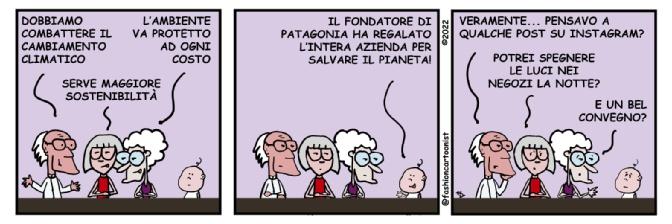


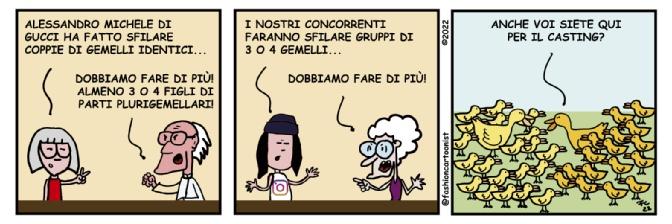
146 @fashioncartoonist by
Sessa Vitali
ACTUALLY… I WAS THINKING ABOUT A FEW INSTA GRAM POSTS? - I COULD SWITCH OFF LIGHTS IN THE STORES AT NIGHT? - HOW ABOUT A NICE SYMPOSIUM? - FOLLOWING A FOCUS ON COMFORT DURING THE PANDEMIC, HIGH HEELS ARE COMING BACK IN FASHION! - AH NO! DATA SHOWS ALL OF OUR CUSTOMERS FALL INTO THIS DEMOGRAPHIC ALL OUR MARKETING ACTIVITIES HOWEVER EXCLUSIVELY TARGET THIS DEMOGRAPHIC - SUGGESTIONS? - CALL IT “DIVERSITY AND INCLUSION”. NOBODY WILL OBJECT… ARE YOU ALSO HERE FOR THE CASTING? - ALESSANDRO MICHELE OF GUCCI HAD COUPLES OF IDENTICAL TWINS IN HIS RUNWAY SHOW… - WE NEED TO DO MORE! AT LEAST IDENTICAL TRIPLETS OR QUADRUPLETS! - OUR COMPETITORS WILL HAVE IDENTICAL TRIPLETS AND QUADRUPLETS IN THEIR RUNWAY SHOW… - WE NEED TO DO MORE! - WE MUST FIGHT CLIMATE CHANGE - THE ENVI RONMENT NEEDS TO BE PROTECTED AT ALL COSTS - WE NEED MORE SUSTAINABILITY PATAGONIA FOUNDER GAVE AWAY HIS WHOLE COMPANY TO SAVE THE PLANET! - GREAT BARGAIN SALE OF HIGH HEELS STARTING NOW!!! - ON OUR WAYYYY!!! I WILL NOT LET MY WARDROBE BE DICTATED BY A TREND! I CAN’T EVEN WALK IN THESE HEELS…
Matteo
-

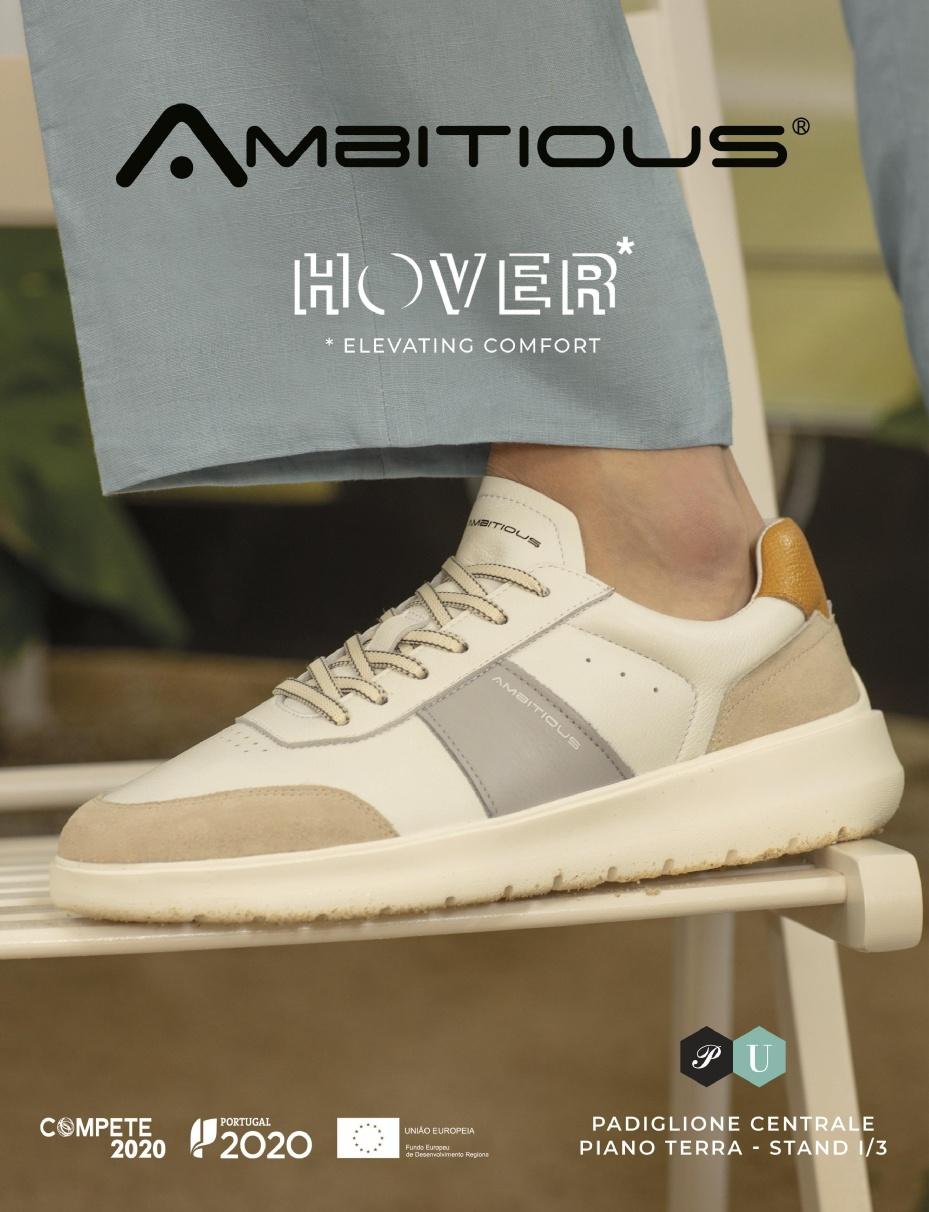












 by Luca Cioffi Drawing by Joe Colosimo
by Luca Cioffi Drawing by Joe Colosimo
















 Total look ISSEY MIYAKE Shoes Y3
Photos by Angelo Lanza Fashion by Luca Termine Make-up: Alessia Damiata @MKS Milano Hair: Mirko Battipaglia @MKS Milano
Photo assistant: Yadier Castro Piedra
Styling assistants: Ilaria Gelormini and Verdiana Alberghini Models: Sibin and Sofiia Chuprikova @BraveModel MNG
Thanks to Enrico Luigi Sidoli, Giulia Bacchi and Riccardo Giordani @A.N.G.E.L.O.
Total look ISSEY MIYAKE Shoes Y3
Photos by Angelo Lanza Fashion by Luca Termine Make-up: Alessia Damiata @MKS Milano Hair: Mirko Battipaglia @MKS Milano
Photo assistant: Yadier Castro Piedra
Styling assistants: Ilaria Gelormini and Verdiana Alberghini Models: Sibin and Sofiia Chuprikova @BraveModel MNG
Thanks to Enrico Luigi Sidoli, Giulia Bacchi and Riccardo Giordani @A.N.G.E.L.O.



 modtissimo.com
modtissimo.com

 Drawing by Joe Colosimo Photos by Angelo Lanza Fashion by Luca Termine
Drawing by Joe Colosimo Photos by Angelo Lanza Fashion by Luca Termine
 Jumper ATTIC AND BARN
Trousers PT TORINO Belt GAVAZZENI Sunglasses RALPH LAUREN Shoes SCAROSSO
Jumper ATTIC AND BARN
Trousers PT TORINO Belt GAVAZZENI Sunglasses RALPH LAUREN Shoes SCAROSSO
 Trench VIENMNSUONNO 1926 Suit OTKUTYR for MyGeenKSA Sunglasses MIKYTA STUDIO Boots CULT
Trench VIENMNSUONNO 1926 Suit OTKUTYR for MyGeenKSA Sunglasses MIKYTA STUDIO Boots CULT
 Total BCBGMAXAZRIA Bag FIGUS DESIGNER Sunglasses MYKITA Boots MALONE SOULIERS
Total BCBGMAXAZRIA Bag FIGUS DESIGNER Sunglasses MYKITA Boots MALONE SOULIERS

 Fur and trousers ATTIC AND BARN
Turtleneck CARLO PIGNATELLI
Shoes BIANCA SOUNDERS AT. Kollektive
Fur and trousers ATTIC AND BARN
Turtleneck CARLO PIGNATELLI
Shoes BIANCA SOUNDERS AT. Kollektive
 Coat BYAN
Turtleneck OTTO D’AME
Trousers GIAMPAOLO Sunglasses MYKITA STUDIO Shoes DOUCAL’S
Coat BYAN
Turtleneck OTTO D’AME
Trousers GIAMPAOLO Sunglasses MYKITA STUDIO Shoes DOUCAL’S


 Jumper PEOPLE OF SHIBUYA Sunglasses DOLCE & GABBANA
Jumper PEOPLE OF SHIBUYA Sunglasses DOLCE & GABBANA
 Cardigan FRED PERRY
Jumper MATEMA
Trousers TRAMAROSSA
Glasses POPS MILANO Shoes ROBINSON
Cardigan FRED PERRY
Jumper MATEMA
Trousers TRAMAROSSA
Glasses POPS MILANO Shoes ROBINSON
 Jacket GIMPAOLO
Cardigan FILIPPO DE LAURENTIIS
Jumper PIACENZA CASHMERE
Trousers HUI
Shoes CUOIO DI TOSCANA
Jacket GIMPAOLO
Cardigan FILIPPO DE LAURENTIIS
Jumper PIACENZA CASHMERE
Trousers HUI
Shoes CUOIO DI TOSCANA
 Photos by Angelo Lanza - Fashion by Luca Termine - Make-up: Imma Mennuti - Hair: Giorgia Prini @MKS Milano - Photo assistant: Yadier Castro Piedra Styling assistants: Evelyn Fogar, Giulia Ponti and Francesca Volpe - Models: Leo Correira and Talla Dieng @ILove Models MNG and Anna Virag Seck @BraveModels MNG
Photos by Angelo Lanza - Fashion by Luca Termine - Make-up: Imma Mennuti - Hair: Giorgia Prini @MKS Milano - Photo assistant: Yadier Castro Piedra Styling assistants: Evelyn Fogar, Giulia Ponti and Francesca Volpe - Models: Leo Correira and Talla Dieng @ILove Models MNG and Anna Virag Seck @BraveModels MNG





 Boots DEICHMANN
Trousers PT TORINO
Up shoes OFFICINE CREATIVE Undewear INTIMISSIMI
Boots DEICHMANN
Trousers PT TORINO
Up shoes OFFICINE CREATIVE Undewear INTIMISSIMI







 Photos by Bohdan Bohdanov Fashion by Dinalva Barros
Top LM AGNES Trousers ANGELOS FRENTZOS Bag FENDI
Photos by Bohdan Bohdanov Fashion by Dinalva Barros
Top LM AGNES Trousers ANGELOS FRENTZOS Bag FENDI
 Top and trousers LM AGNESE
Pochette KNEED
Top and trousers LM AGNESE
Pochette KNEED
 Skirt SIMON CRACKER
Top WEILI ZHENG Bag A. CLOUD
Skirt SIMON CRACKER
Top WEILI ZHENG Bag A. CLOUD

 Dress ADEL BEL Boots SARA WONG
Dress ADEL BEL Boots SARA WONG
 Dress WEILI ZHENG Glasses FEDE CHETI Rings BONA CALVI
Dress WEILI ZHENG Glasses FEDE CHETI Rings BONA CALVI


 Dress BARTOLOTTA E MARTORANA Bag JACQUEMUS
Photos by Bohdan Bohdanov Fashion by Dinalva Barros
Vanessa Udovicich
Anastasiia Tymoshchuk
Photo assistant: Kevin Yu Fashion assistants: Carlotta Laurenti and Giulia Tiraboschi
assistant: Camilla Negroni
assistant: Elizabeth Fogel
Models: Route @SophieModels and Mak K. @FashionModels MNG
Dress BARTOLOTTA E MARTORANA Bag JACQUEMUS
Photos by Bohdan Bohdanov Fashion by Dinalva Barros
Vanessa Udovicich
Anastasiia Tymoshchuk
Photo assistant: Kevin Yu Fashion assistants: Carlotta Laurenti and Giulia Tiraboschi
assistant: Camilla Negroni
assistant: Elizabeth Fogel
Models: Route @SophieModels and Mak K. @FashionModels MNG





 Photos by Daniela Rettore - Styling by Federica Carnevali Make-up and hair: Agata Branchina - Retoucher: Katya Kachanouskaya Model: Eduarda Vieira @WomanMNG - Milan
Photos by Daniela Rettore - Styling by Federica Carnevali Make-up and hair: Agata Branchina - Retoucher: Katya Kachanouskaya Model: Eduarda Vieira @WomanMNG - Milan
 Photos by Sara El Beshbichi
Styling by Martina De Carolis and Lucrezia De Vita
Photos by Sara El Beshbichi
Styling by Martina De Carolis and Lucrezia De Vita
 Left: Shirt BARTOLOTTA & MARTORANA Gloves VINTAGE Ring SWAROVSKI Pants FRACOMINA Bag NINA
Right: Coat ANIYE BY Bag VISONÀ Shoes BATA
Left: Shirt BARTOLOTTA & MARTORANA Gloves VINTAGE Ring SWAROVSKI Pants FRACOMINA Bag NINA
Right: Coat ANIYE BY Bag VISONÀ Shoes BATA
 Left: Dress and belt FLAVIA MARDI Gold leather jacket and Bootie MICHAEL KORS
Right: Sunglasses BALENCIAGA Blazer HUI
Left: Dress and belt FLAVIA MARDI Gold leather jacket and Bootie MICHAEL KORS
Right: Sunglasses BALENCIAGA Blazer HUI


 Left: Foulard GIANNI VERSACE Belt GAVAZZENI
Right: Bag MICHELANGELO BROCCA Top VICOLO
Left: Foulard GIANNI VERSACE Belt GAVAZZENI
Right: Bag MICHELANGELO BROCCA Top VICOLO
 Left: Pants MOMONÌ Card holder VERSACE Skirt GILBERTO CALZOLARI Shoes MARIO VALENTINO
Right: Scarf MICHAEL KORS Pants WOMAN IN BERWICH
Left: Pants MOMONÌ Card holder VERSACE Skirt GILBERTO CALZOLARI Shoes MARIO VALENTINO
Right: Scarf MICHAEL KORS Pants WOMAN IN BERWICH
 Photos by Sara El Beshbichi Styling by Martina De Carolis and Lucrezia De Vita Make-up and hair: Americo Turtoro
Photos assistant: Alessio Giannetta Model: Cate Collins @TheWolvesModelManagement
Photos by Sara El Beshbichi Styling by Martina De Carolis and Lucrezia De Vita Make-up and hair: Americo Turtoro
Photos assistant: Alessio Giannetta Model: Cate Collins @TheWolvesModelManagement
 Photos by Angelo Lanza Fashion by Luca Termine
Dress AVARO FIGLIO Shoes CARYATIS
Photos by Angelo Lanza Fashion by Luca Termine
Dress AVARO FIGLIO Shoes CARYATIS
















































 by Giulia Simonotti
by Giulia Simonotti













 BOTTEGA VENETA
BOTTEGA VENETA


















































































